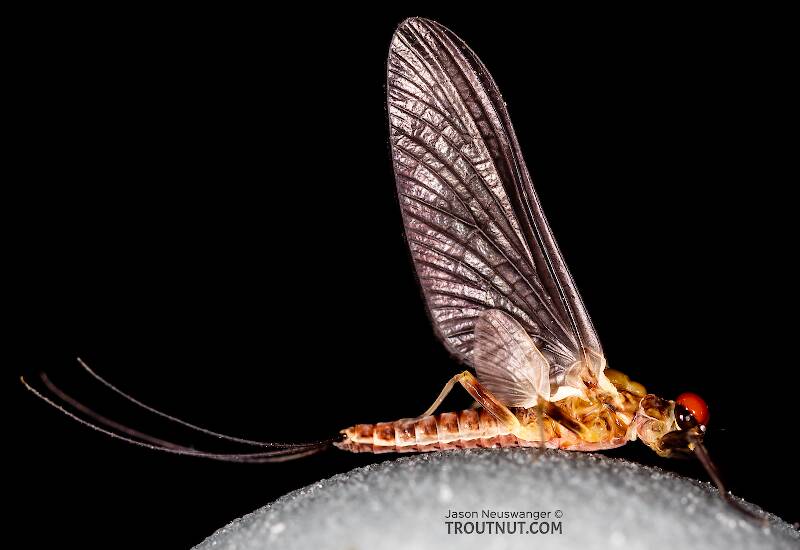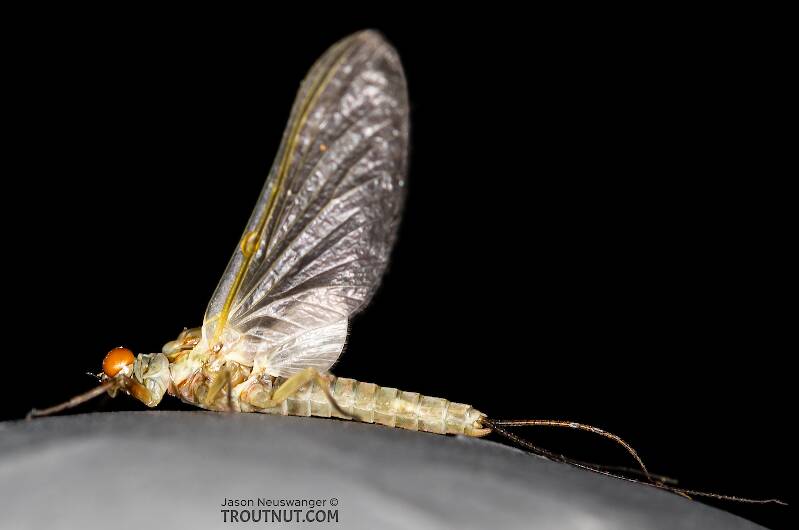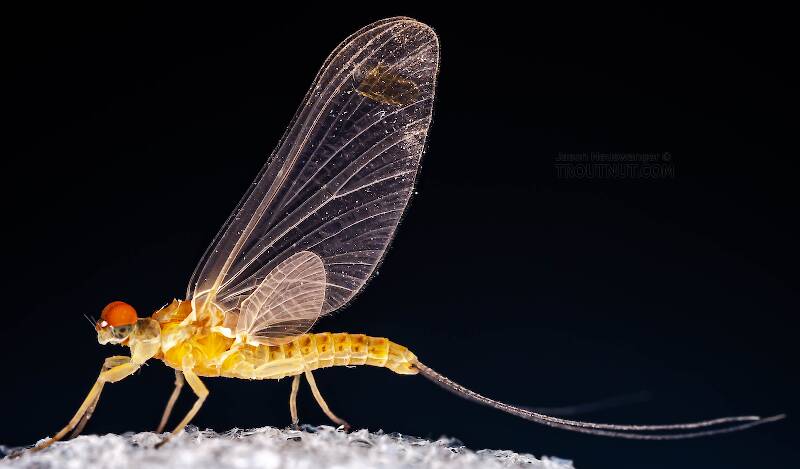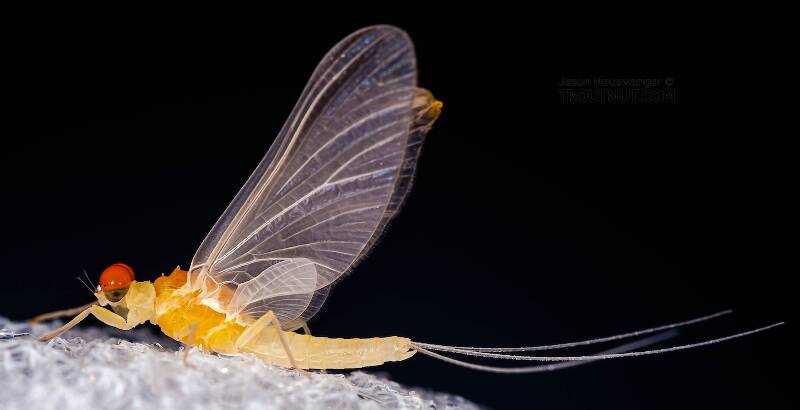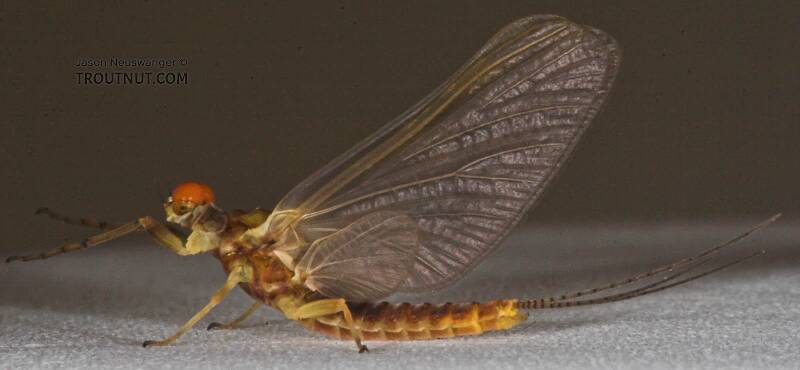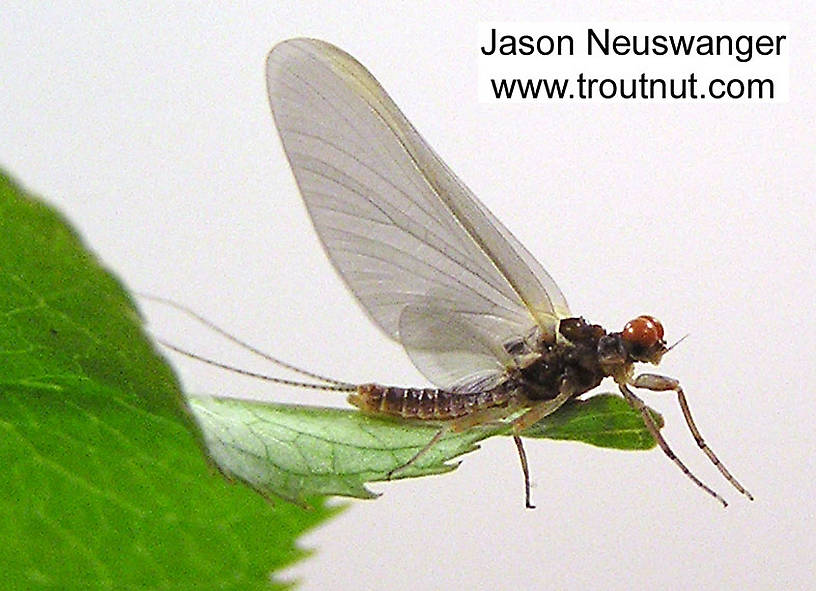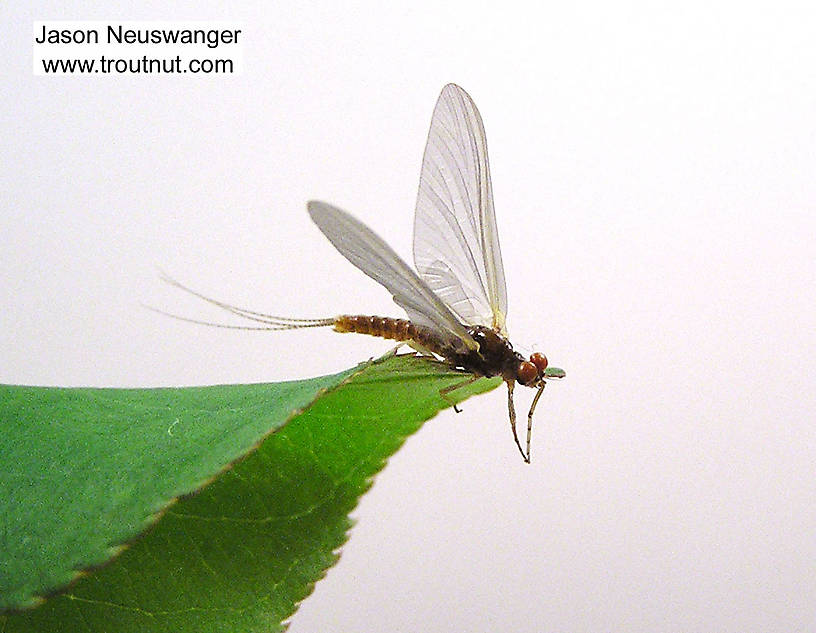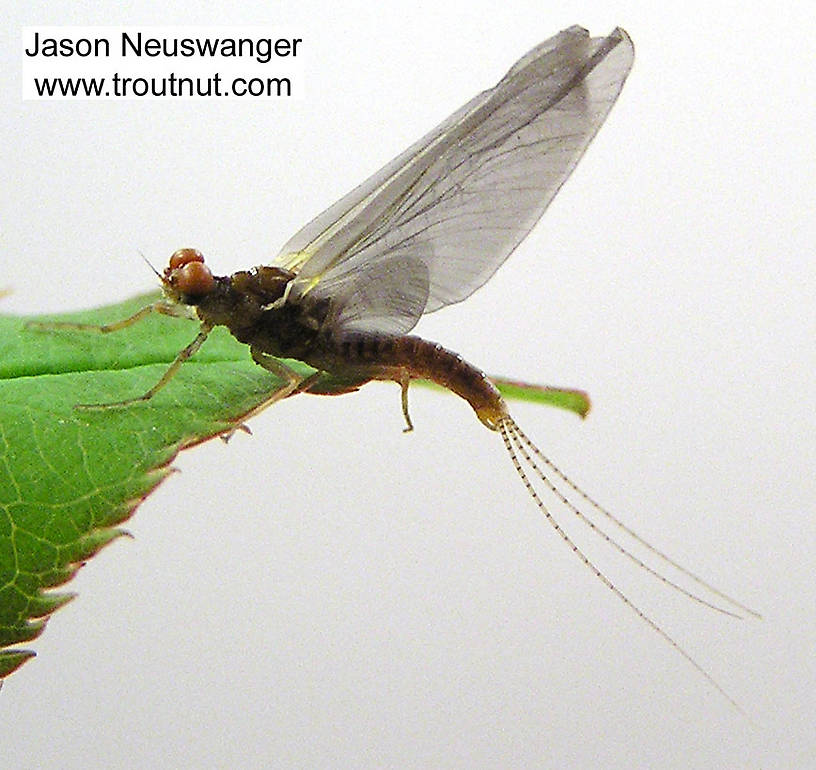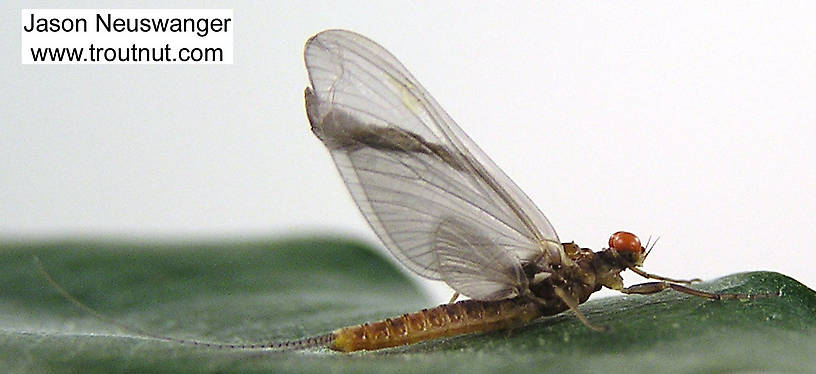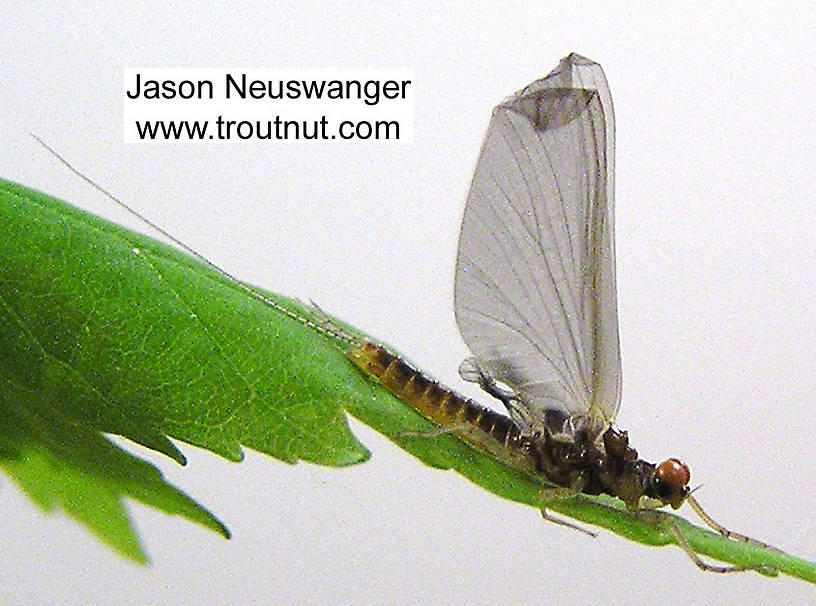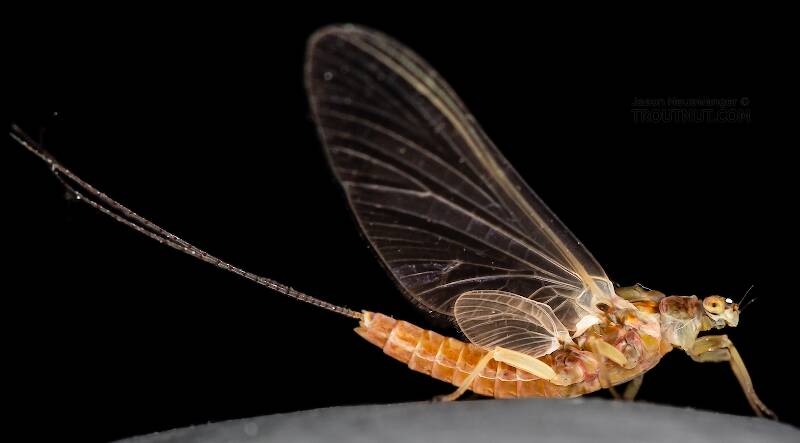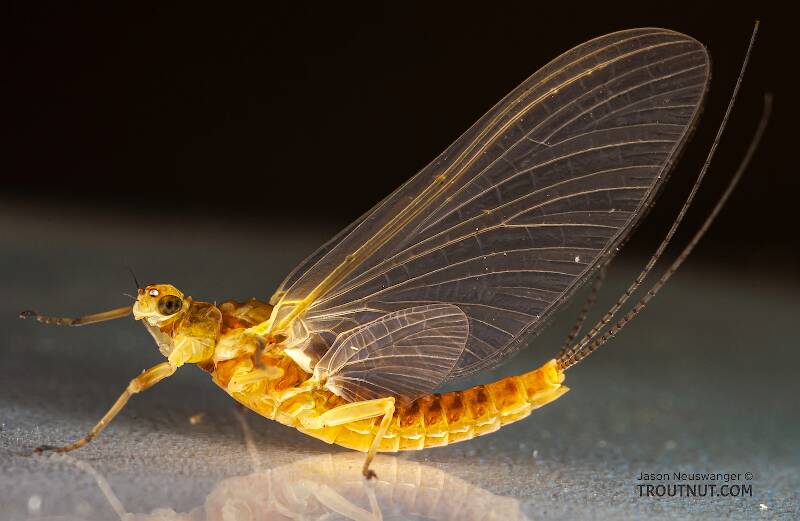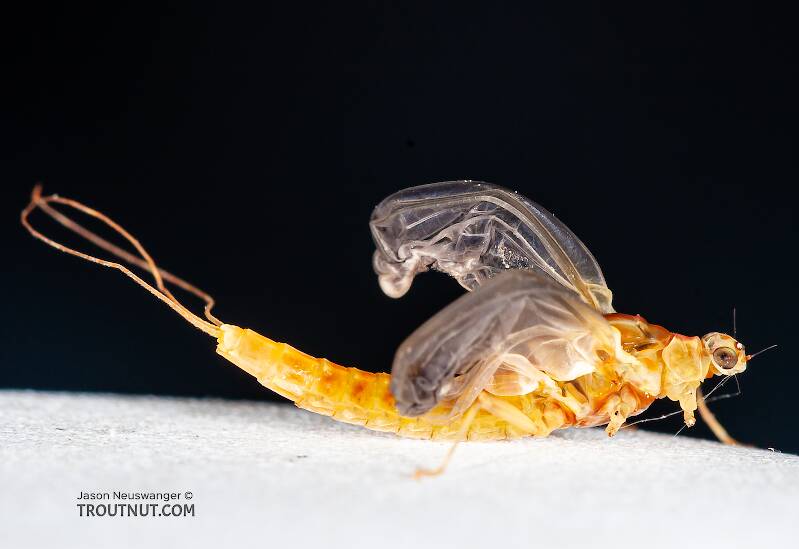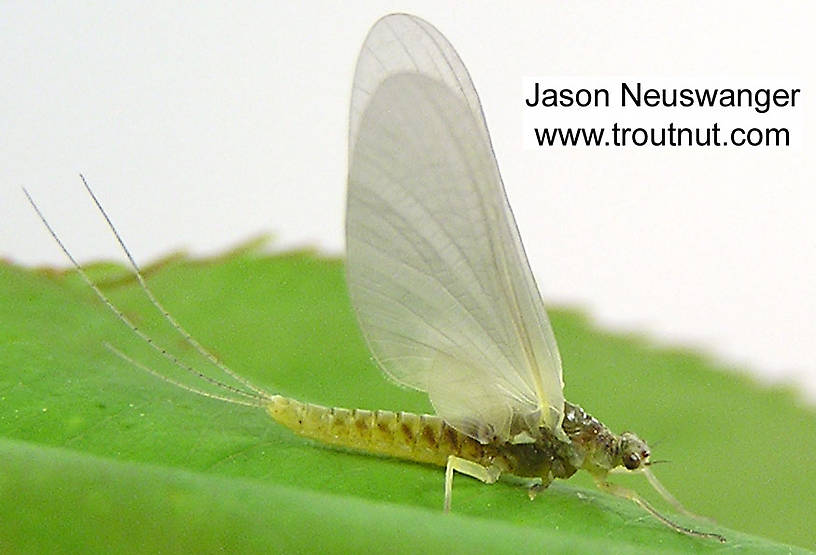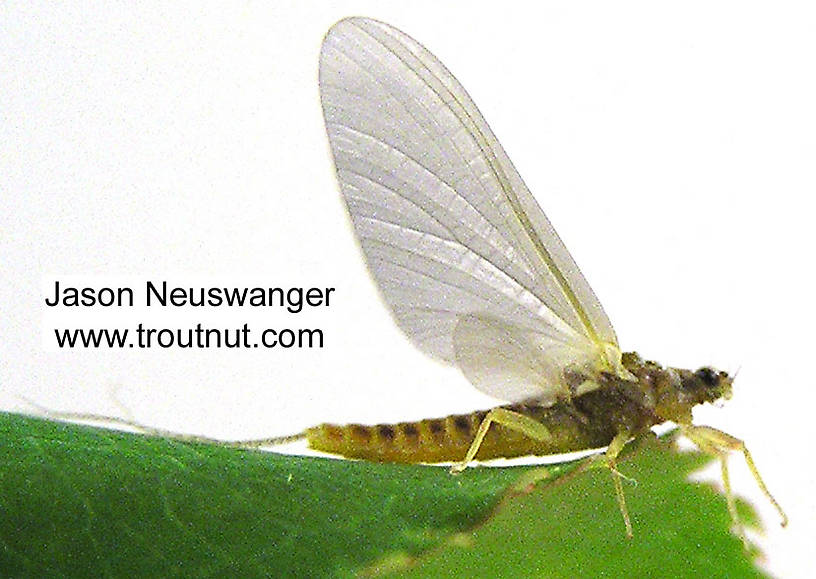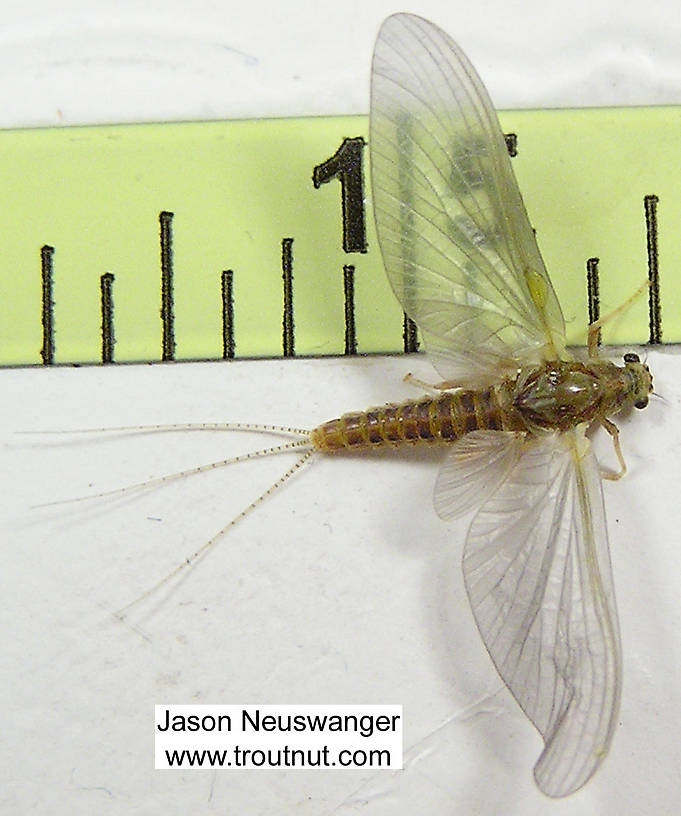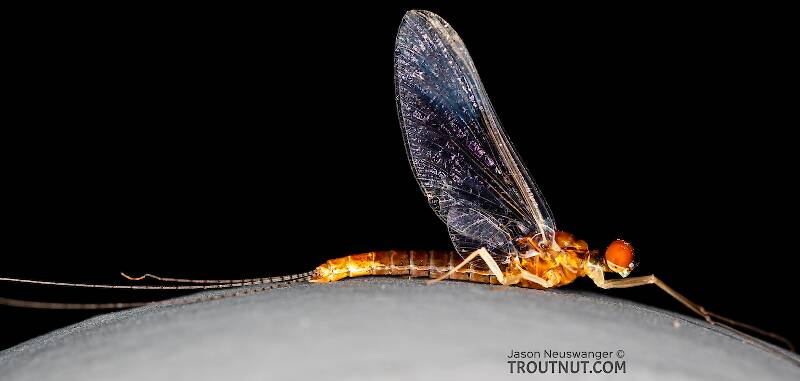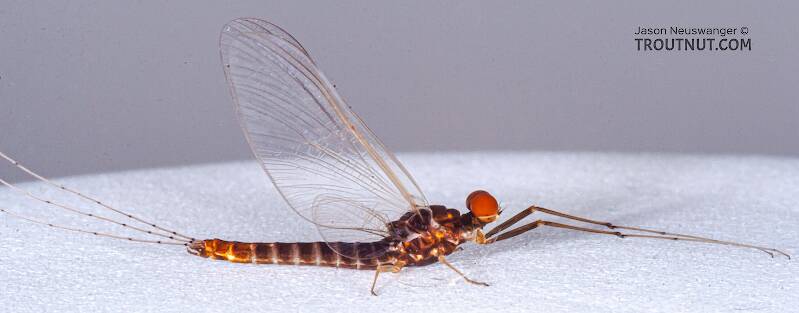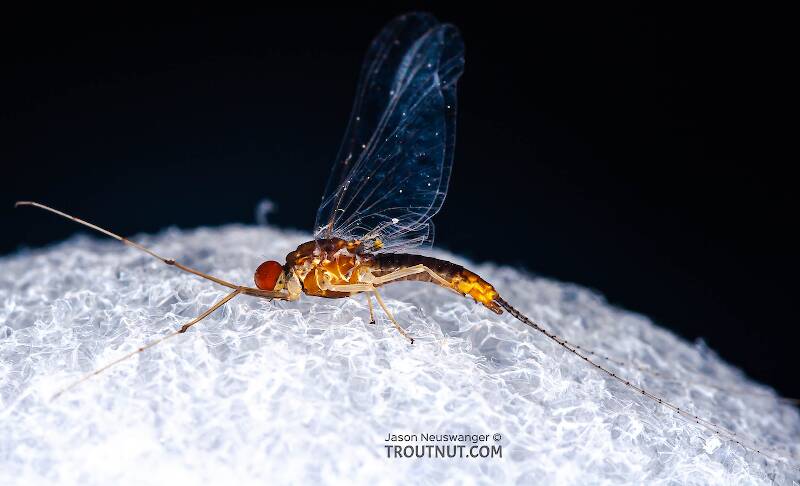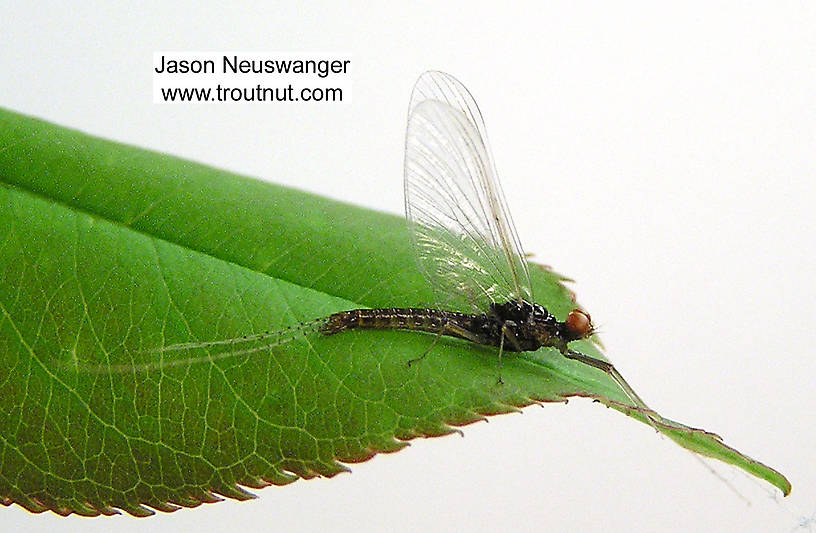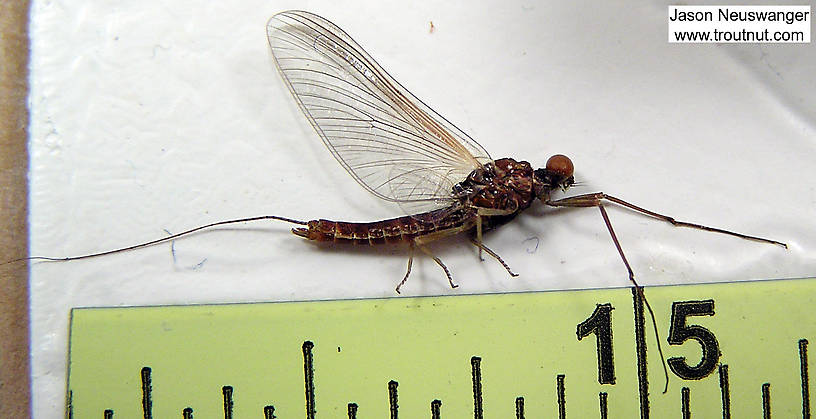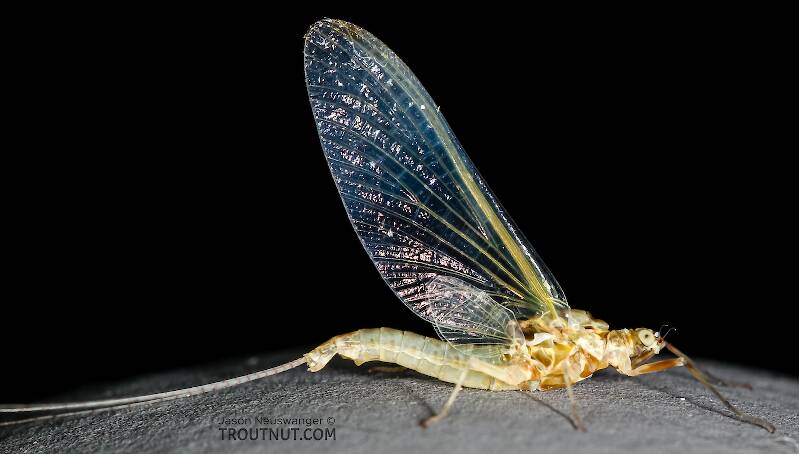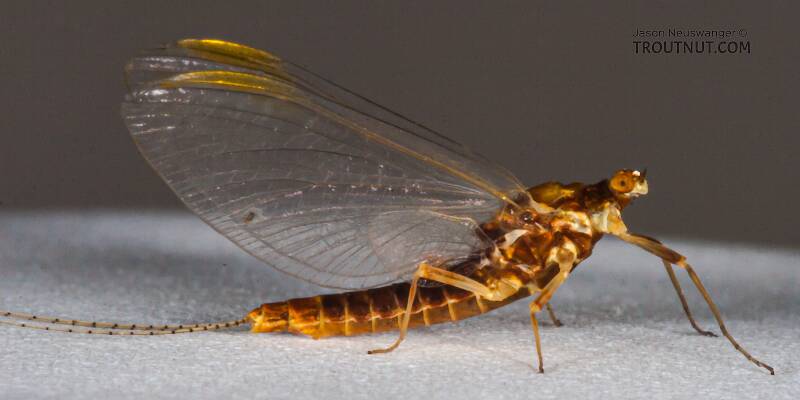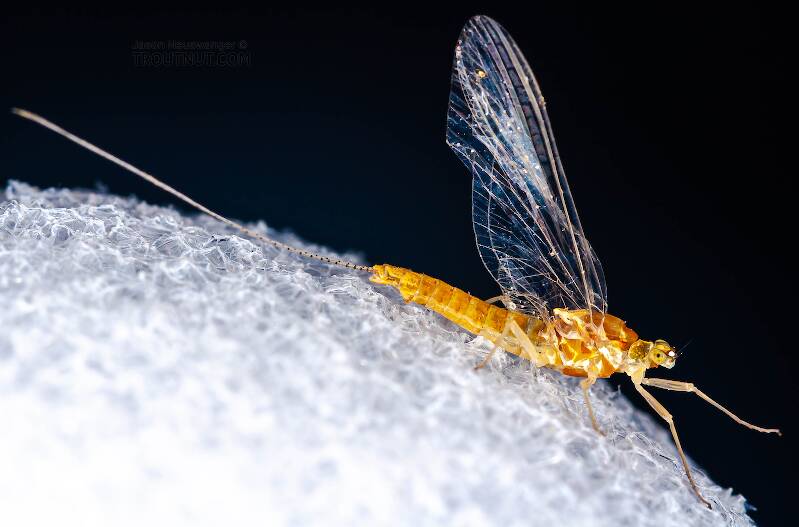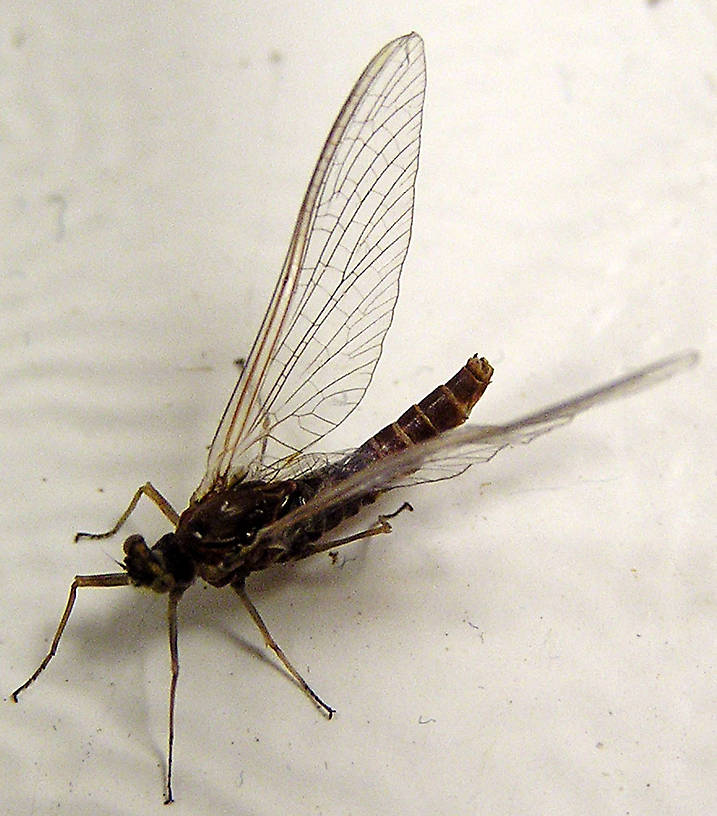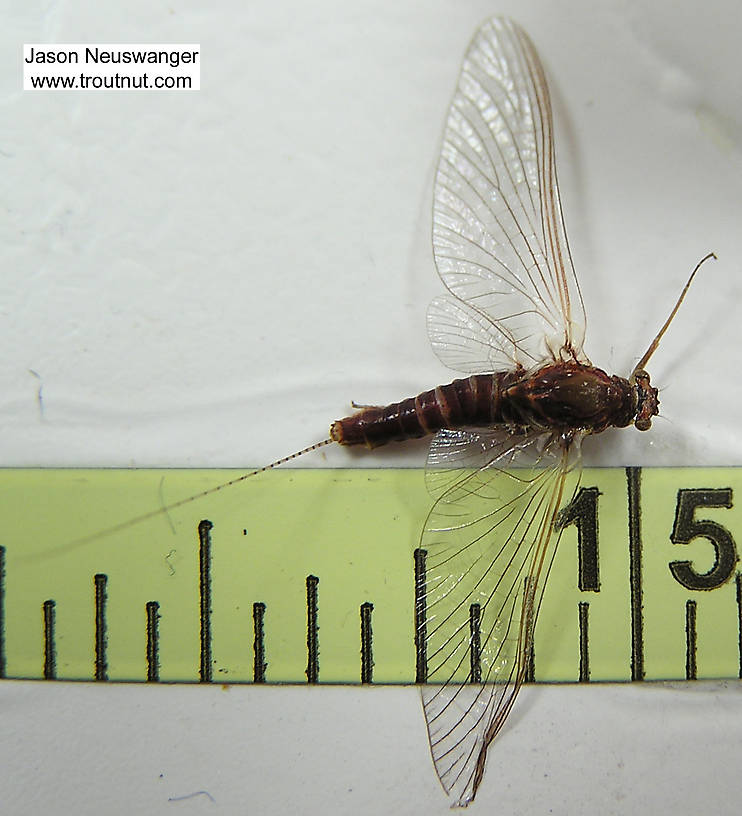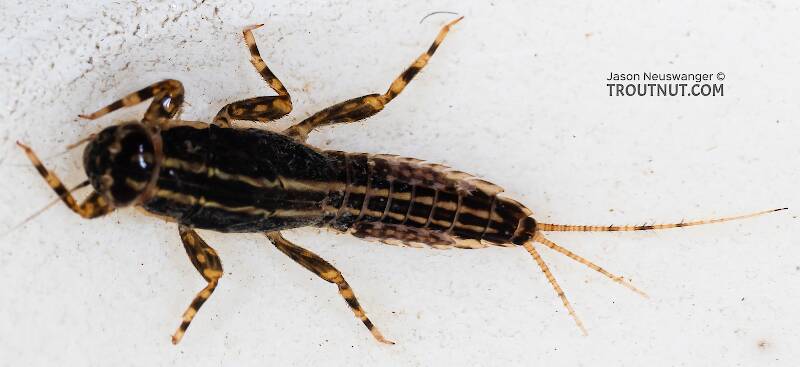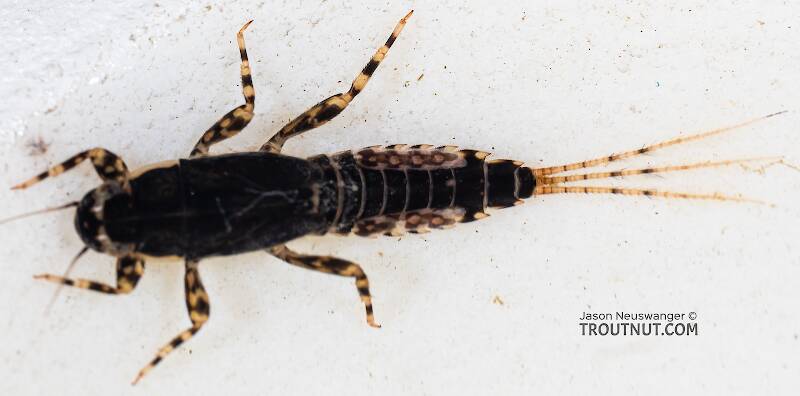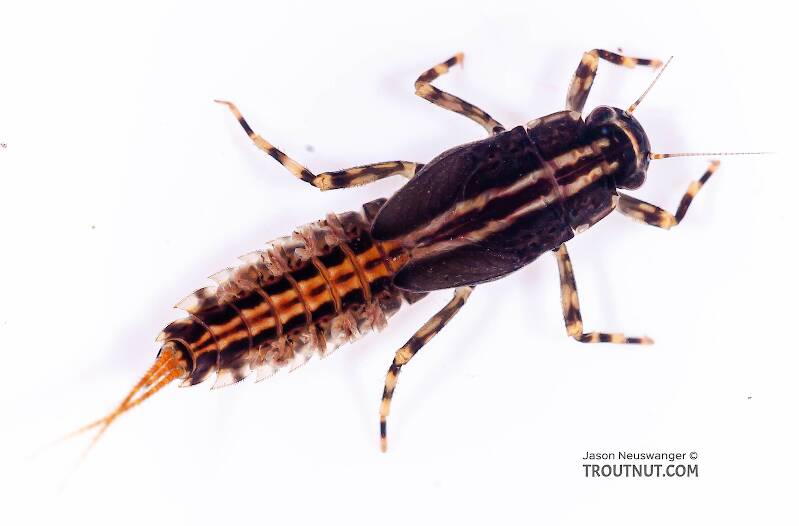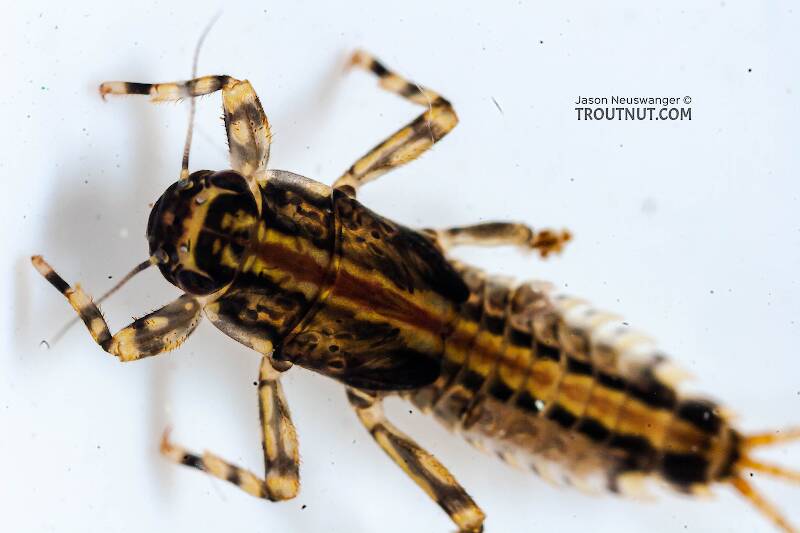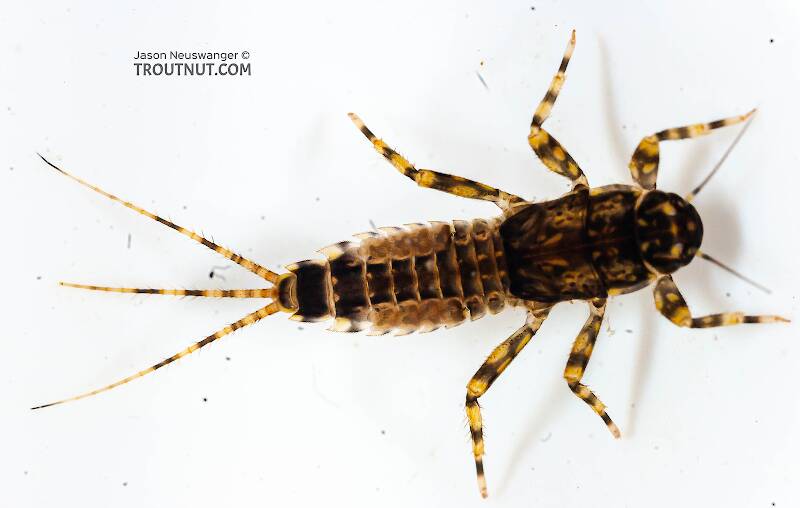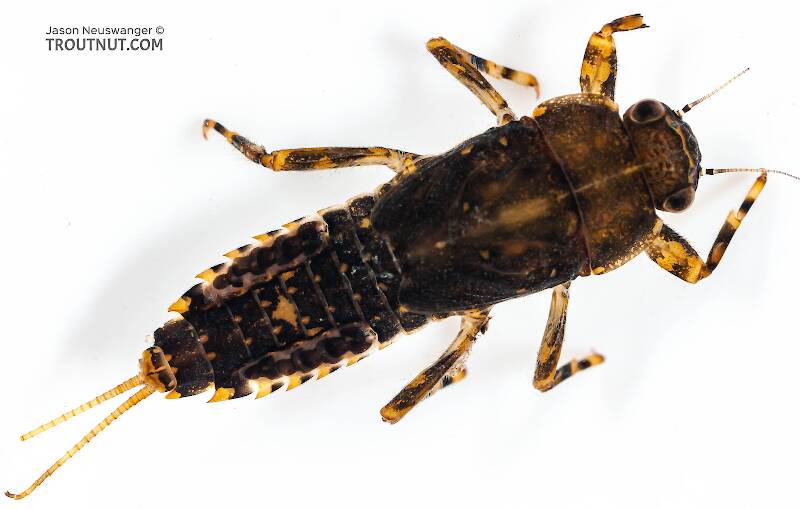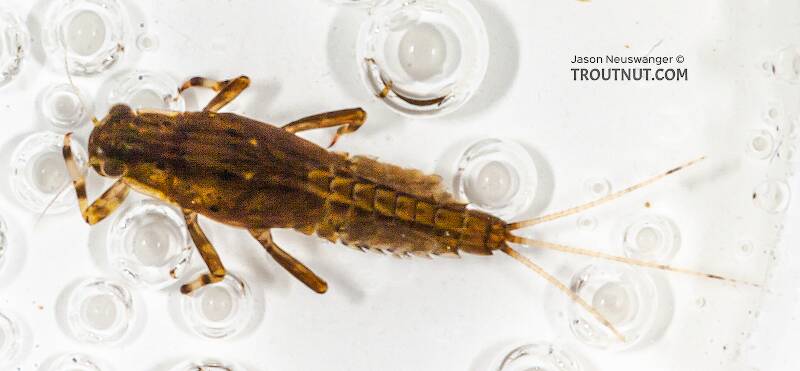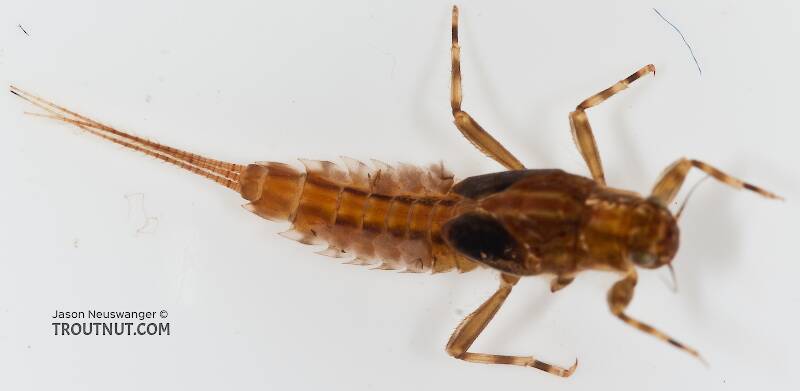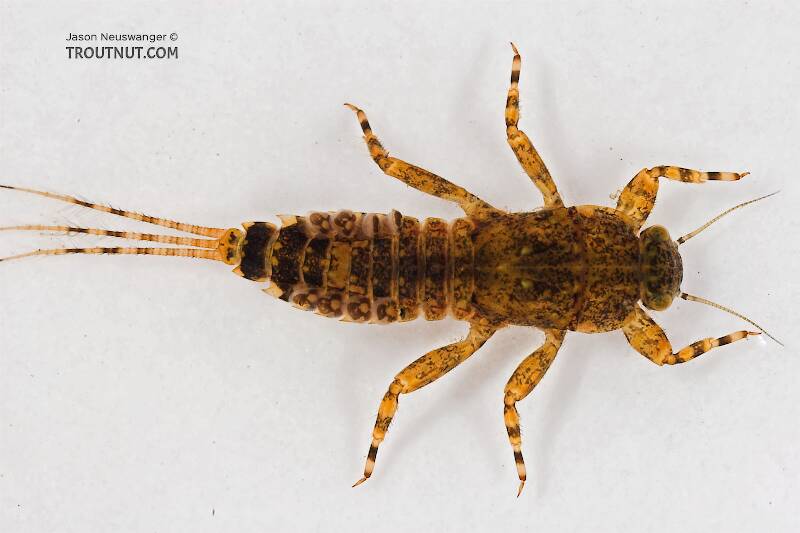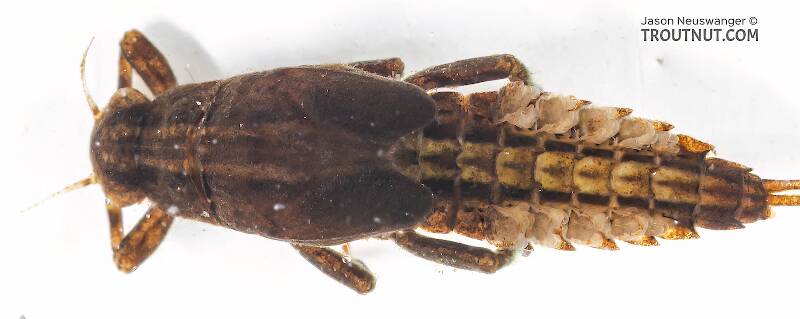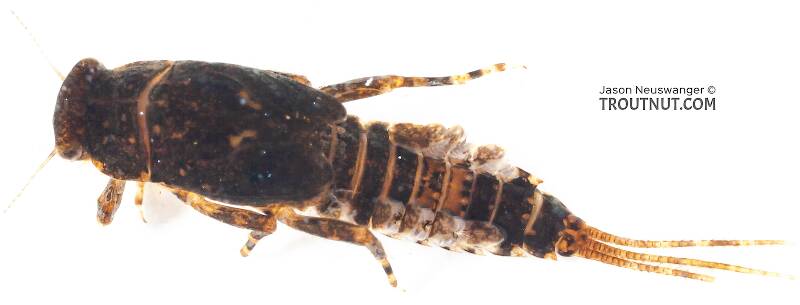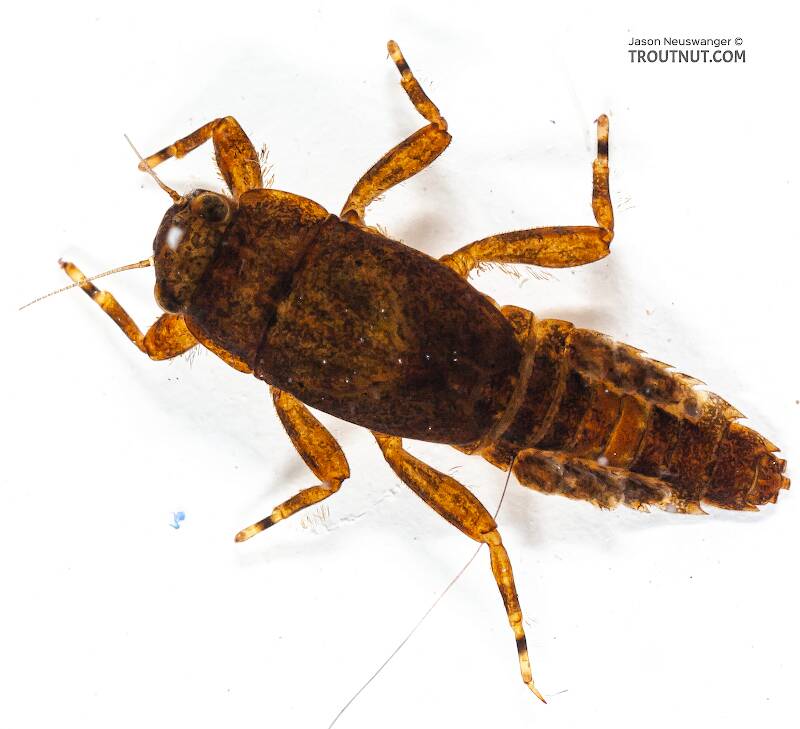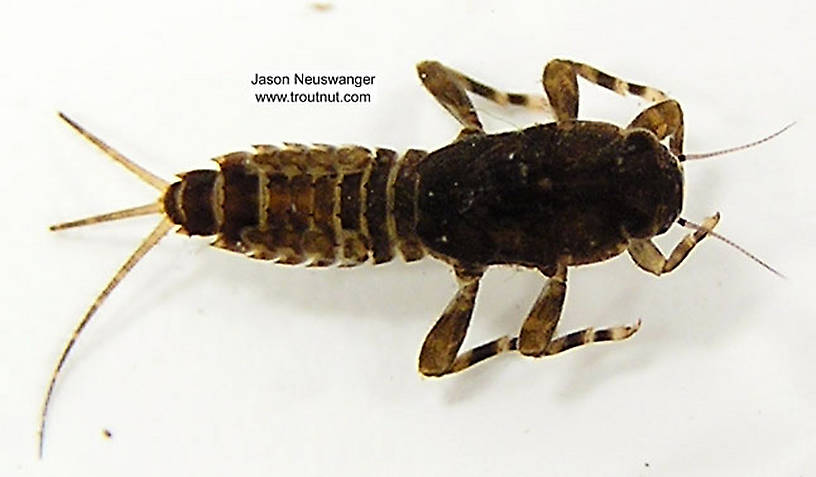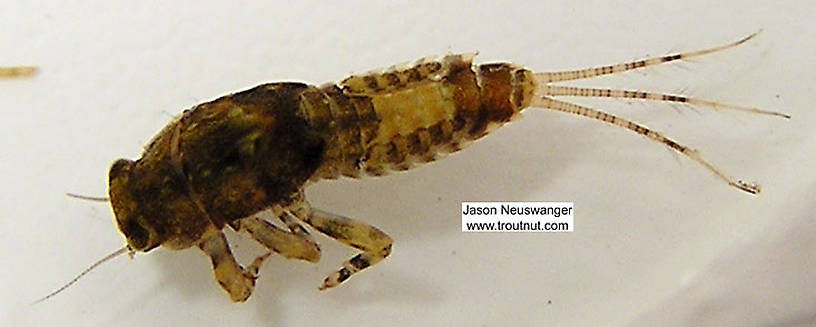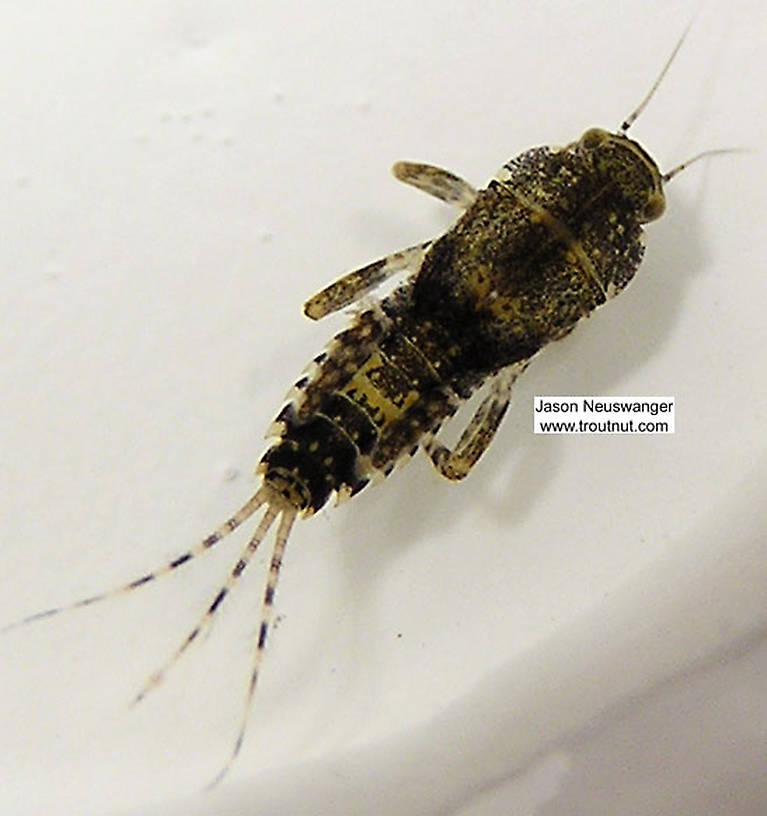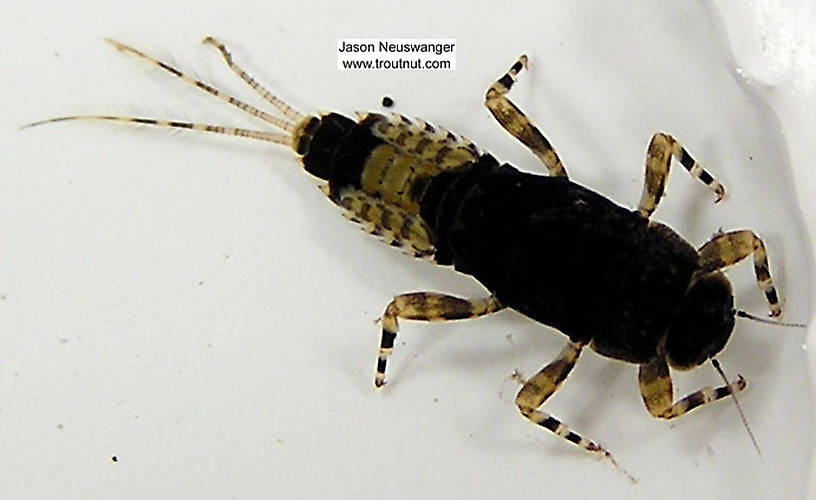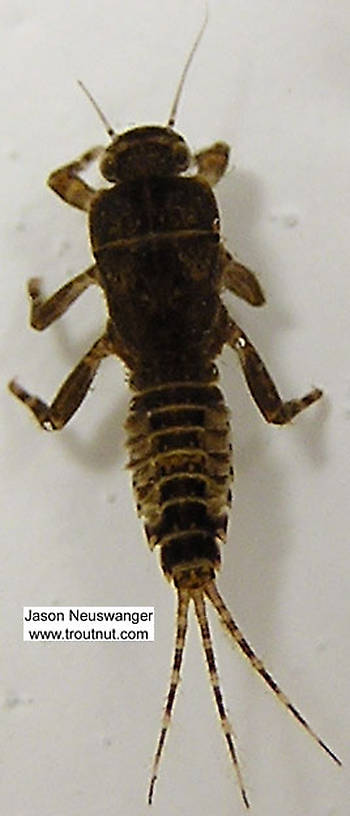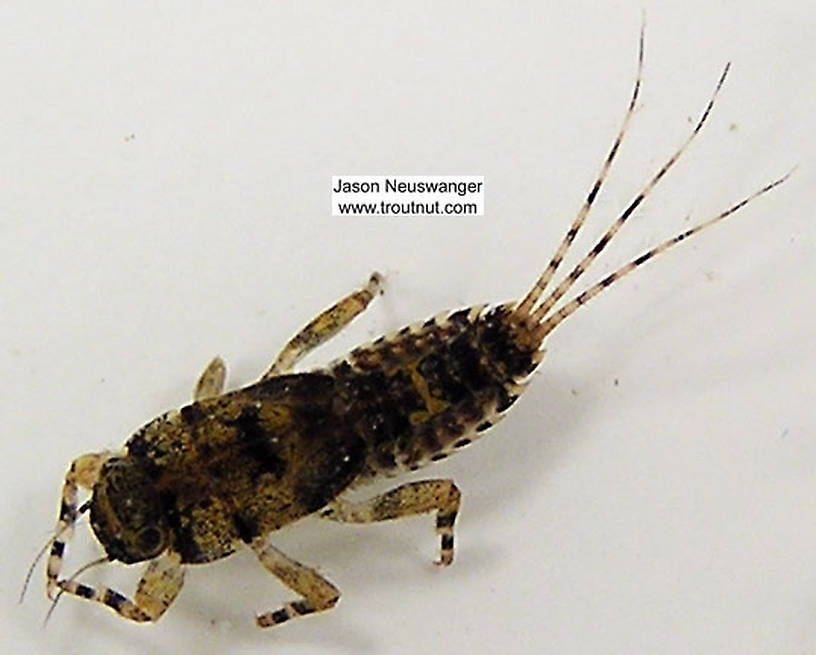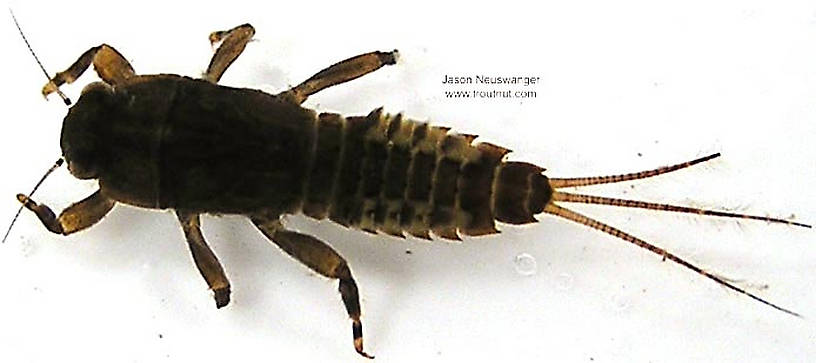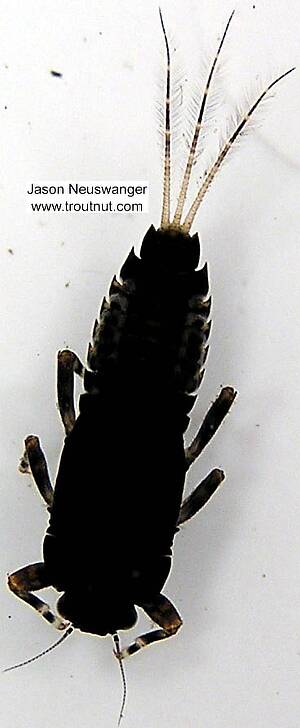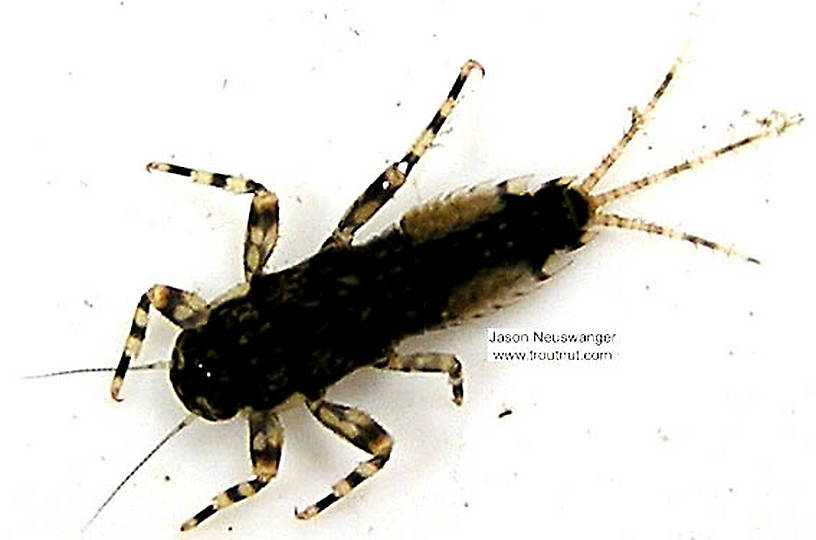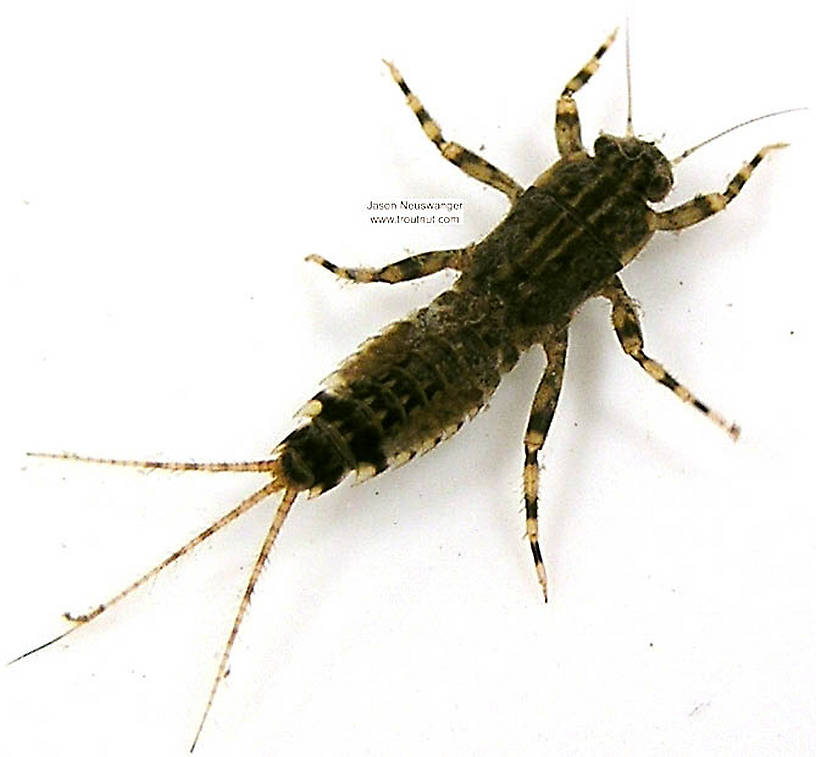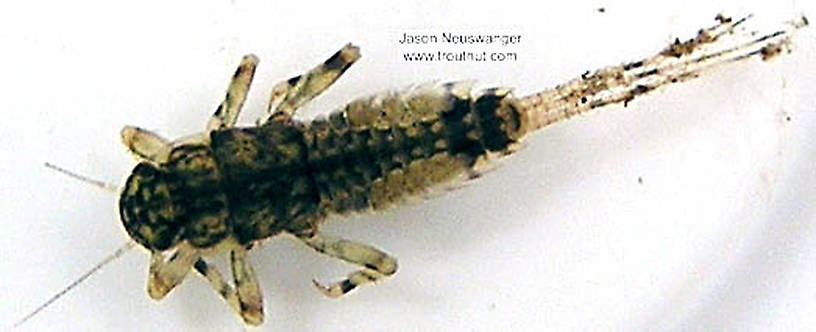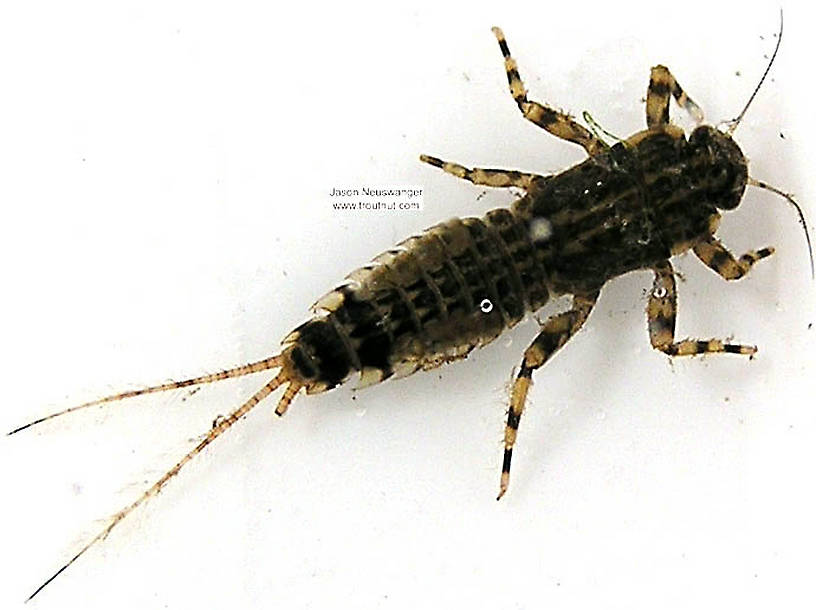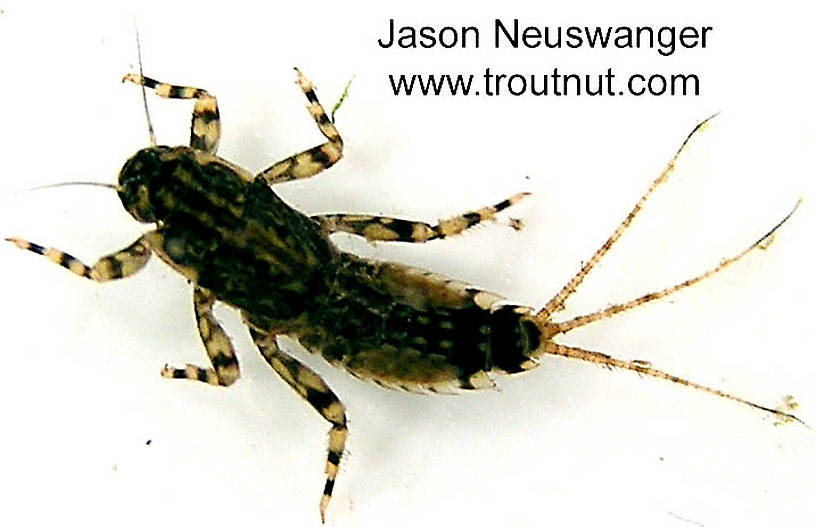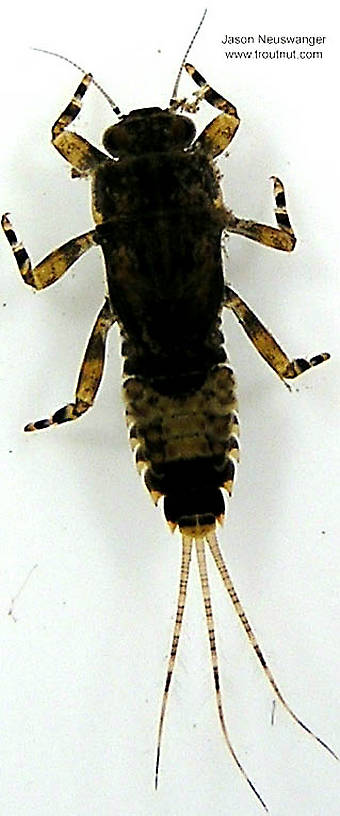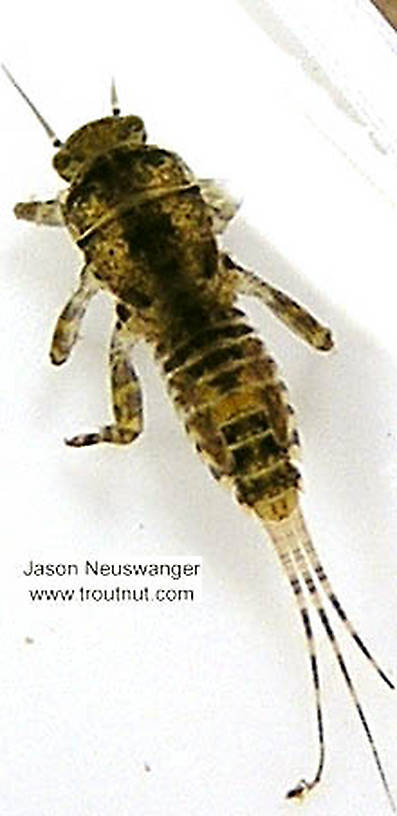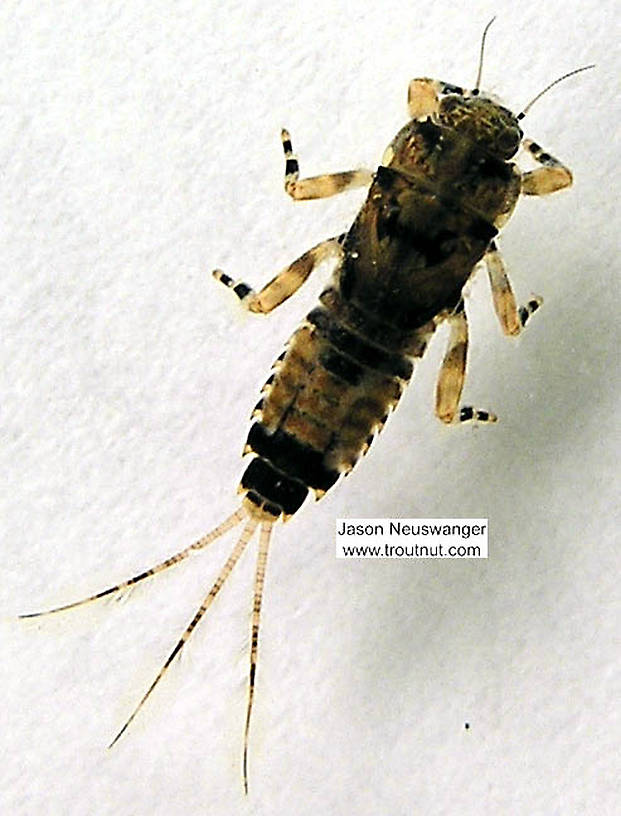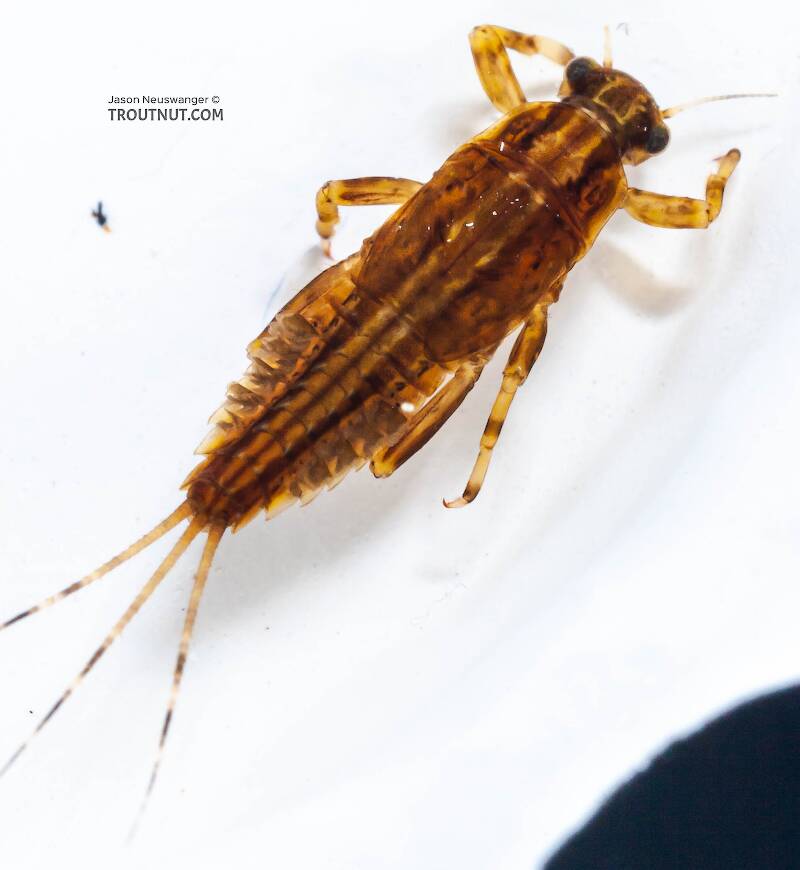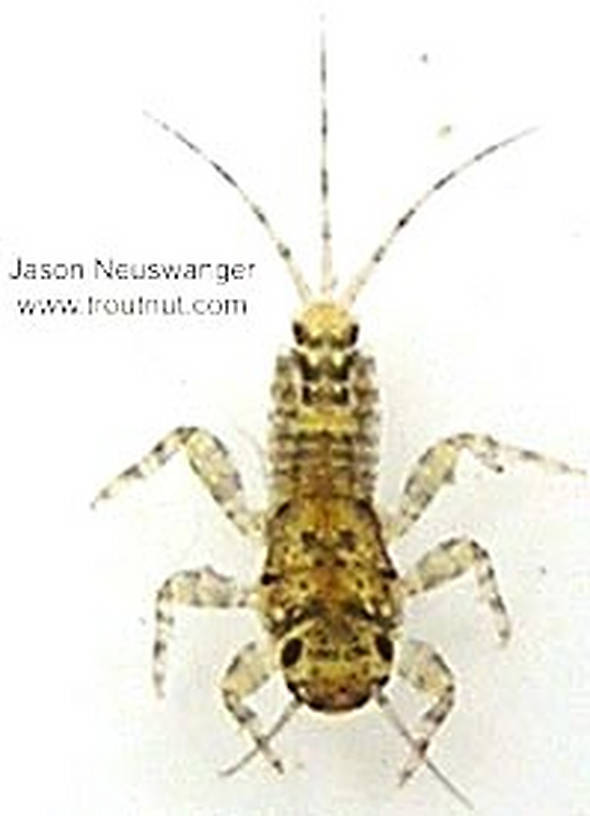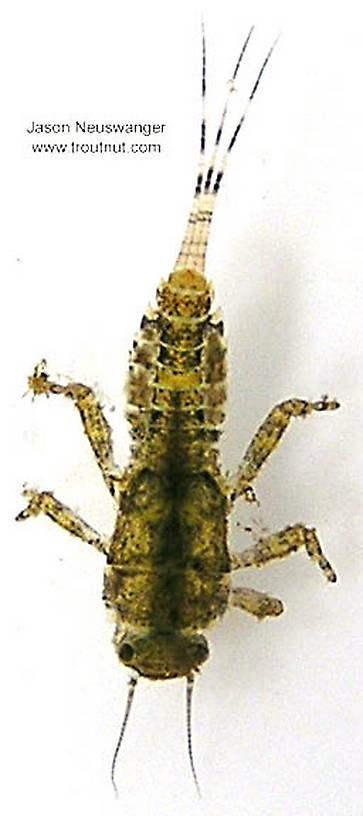
Salmonflies
Pteronarcys californica
The giant Salmonflies of the Western mountains are legendary for their proclivity to elicit consistent dry-fly action and ferocious strikes.
Featured on the forum

This wild-looking little thing completely puzzled me. At first I was thinking beetle or month larva, until I got a look at the pictures on the computer screen. I made a couple of incorrect guesses before entomologist Greg Courtney pointed me in the right direction with Psychodidae. He suggested a possible genus of Thornburghiella, but could not rule out some other members of the tribe Pericomini.

Troutnut is a project started in 2003 by salmonid ecologist Jason "Troutnut" Neuswanger to help anglers and
fly tyers unabashedly embrace the entomological side of the sport. Learn more about Troutnut or
support the project for an enhanced experience here.
Mayfly Genus Ephemerella (Hendricksons, Sulphurs, PMDs)
This page only contains pictures of specimens.To read about Ephemerella, visit Page 1.
Missing Parameter Error: Malformed parameter "%2522http:".
Missing Parameter Error: Malformed parameter "%2522".
Specimens of the Mayfly Genus Ephemerella
23 Male Duns
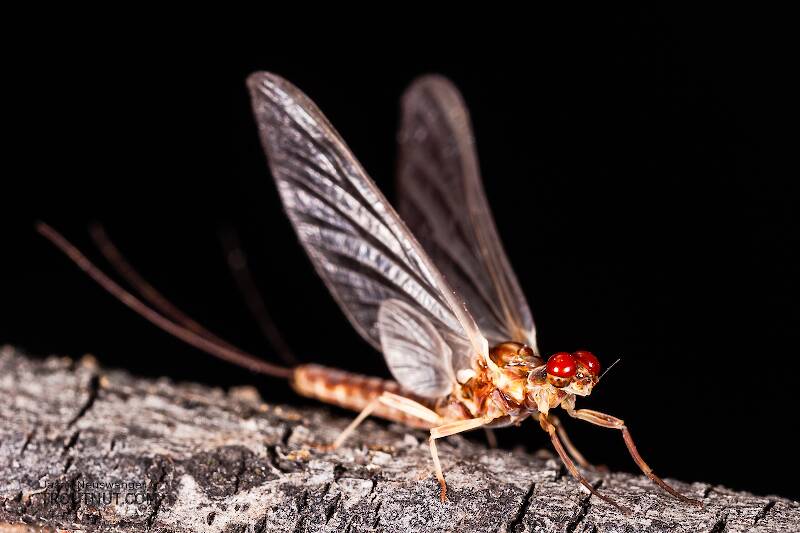
This dun hatched in my aquarium on July 16th from an easily identified nymph collected on July 10th, and it molted into a spinner after I photographed it. The beautiful spinner form is listed as separate specimen. I forgot to photograph the dun with the ruler, but naturally his size is pretty similar to what it was as a spinner.
Added by Troutnut on July 16, 2011
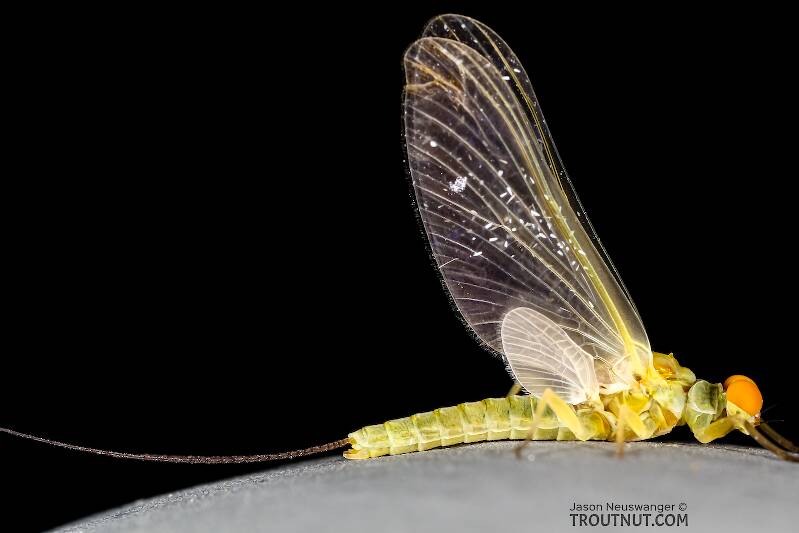
Added by Troutnut on August 17, 2020
Collected July 30, 2020 from the Henry's Fork of the Snake River in Idaho
and added by Troutnut on August 17, 2020
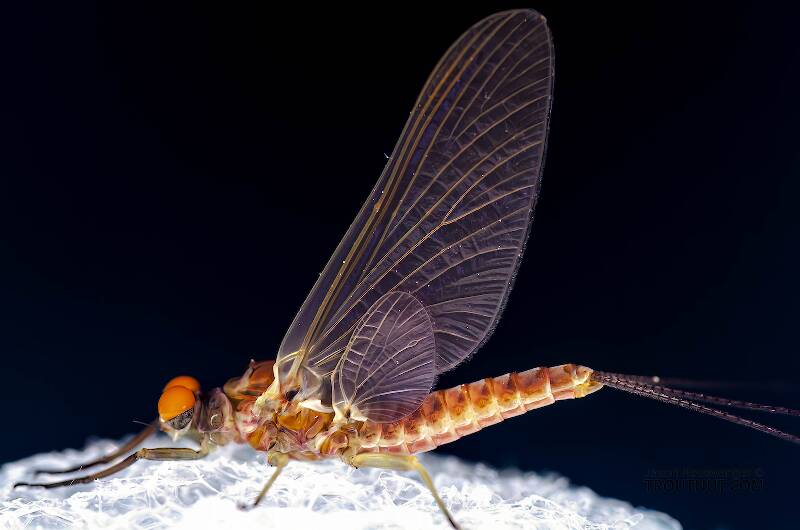
I collected this male Hendrickson dun and a female in the pool on the Beaverkill where the popular Hendrickson pattern was first created. He is descended from mayfly royalty.
Added by Troutnut on April 21, 2006
Collected April 18, 2006 from the Beaverkill River in New York
and added by Troutnut on April 21, 2006
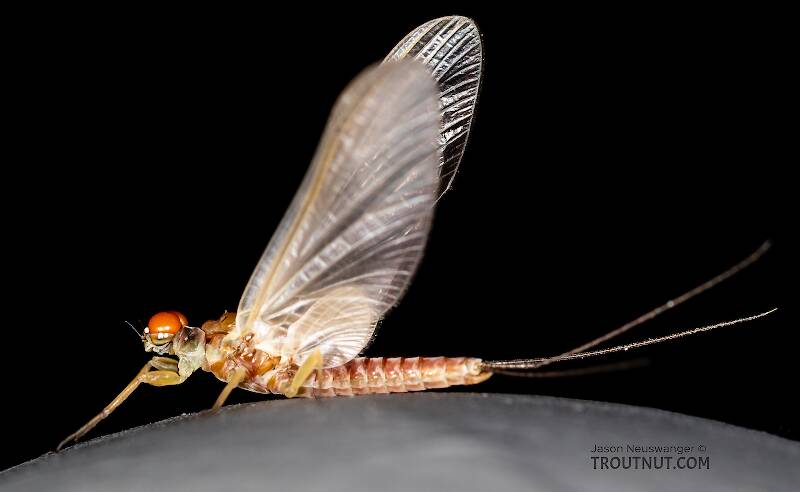
This dun was collected in proximity to this spinner, and to this female that looks like the same species.
Among western species, it most closely resembles Ephemerella aurivillii, of which I reared a specimen from a positively-identified nymph and photographed the male dun previously in Alaska. In the photos, this dun does not seem to have the same evidence of the nymph's dorsal stripe, but that's due to the lighting. A faint stripe is apparent under the microscope, as it is in the female linked above.
They do appear to be a bit short for aurivillii, with the male at 8 mm and the female at 9 mm, but the spinners could be a bit longer.
Among the other Ephemerella mayflies documented in Montana, Ephemerella alleni and Ephemerella mucronata are the only two others that seem to not be ruled out.
Among western species, it most closely resembles Ephemerella aurivillii, of which I reared a specimen from a positively-identified nymph and photographed the male dun previously in Alaska. In the photos, this dun does not seem to have the same evidence of the nymph's dorsal stripe, but that's due to the lighting. A faint stripe is apparent under the microscope, as it is in the female linked above.
They do appear to be a bit short for aurivillii, with the male at 8 mm and the female at 9 mm, but the spinners could be a bit longer.
Among the other Ephemerella mayflies documented in Montana, Ephemerella alleni and Ephemerella mucronata are the only two others that seem to not be ruled out.
Added by Troutnut on July 17, 2019
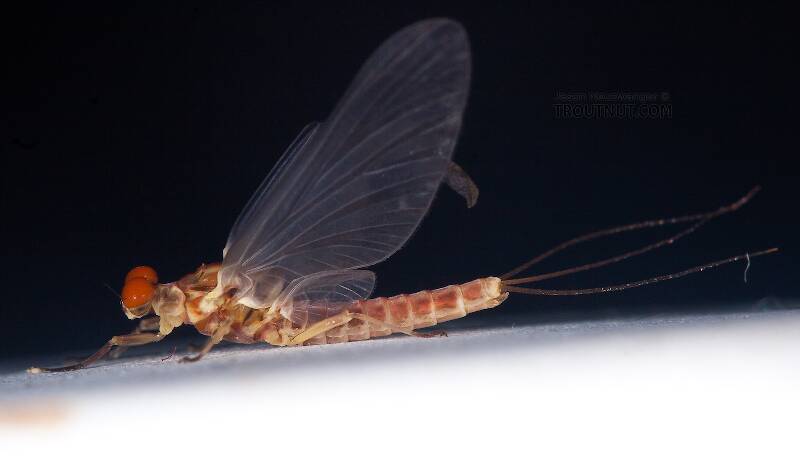
This is the most widespread species of Ephemerella, and also the most abundant in some places, but nobody I've talked to seemed to know what its duns looked like, and there were no pictures of its duns online or in any angling books. That mystery is solved with this male dun, which hatched from a definitively identified nymph.
Added by Troutnut on July 12, 2011
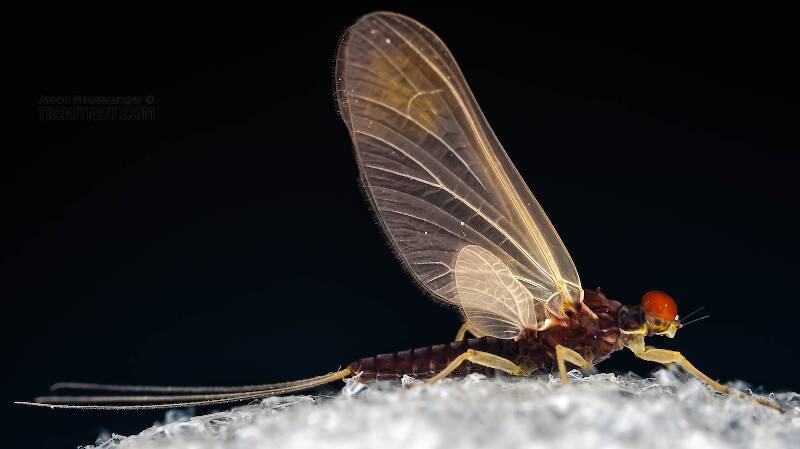
See the comments for an interesting discussion of the identification of this dun.
Added by Troutnut on June 4, 2007
Collected May 31, 2007 from the West Branch of the Delaware River in New York
and added by Troutnut on June 4, 2007
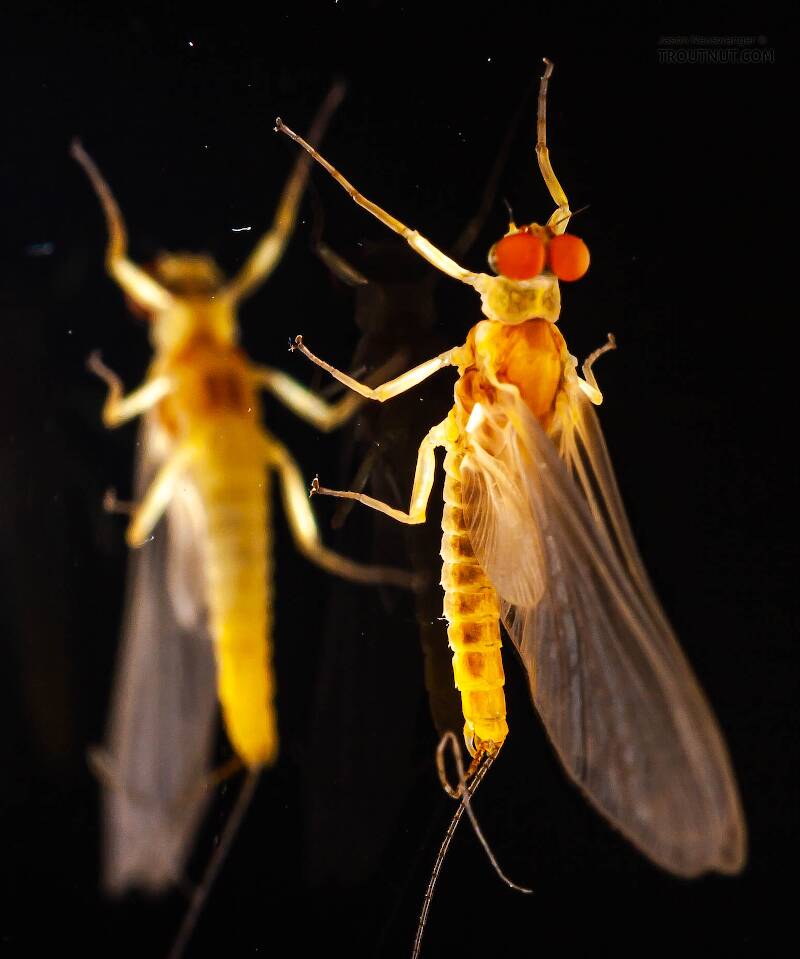
Added by Troutnut on June 4, 2007
Collected May 24, 2007 from the Little Juniata River in Pennsylvania
and added by Troutnut on June 4, 2007
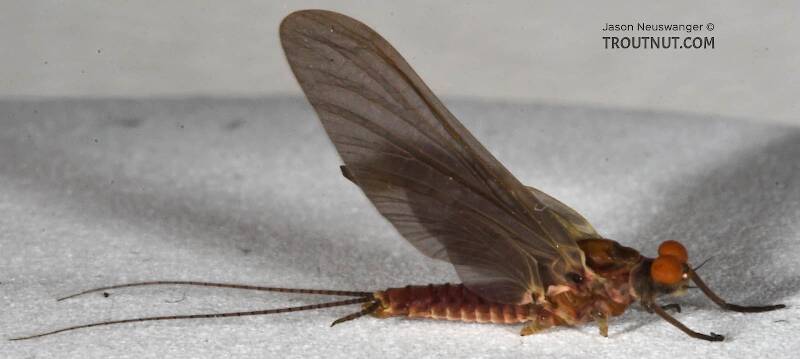
Added by Troutnut on May 16, 2006
Collected May 6, 2005 from the West Branch of the Delaware River in New York
and added by Troutnut on May 16, 2006
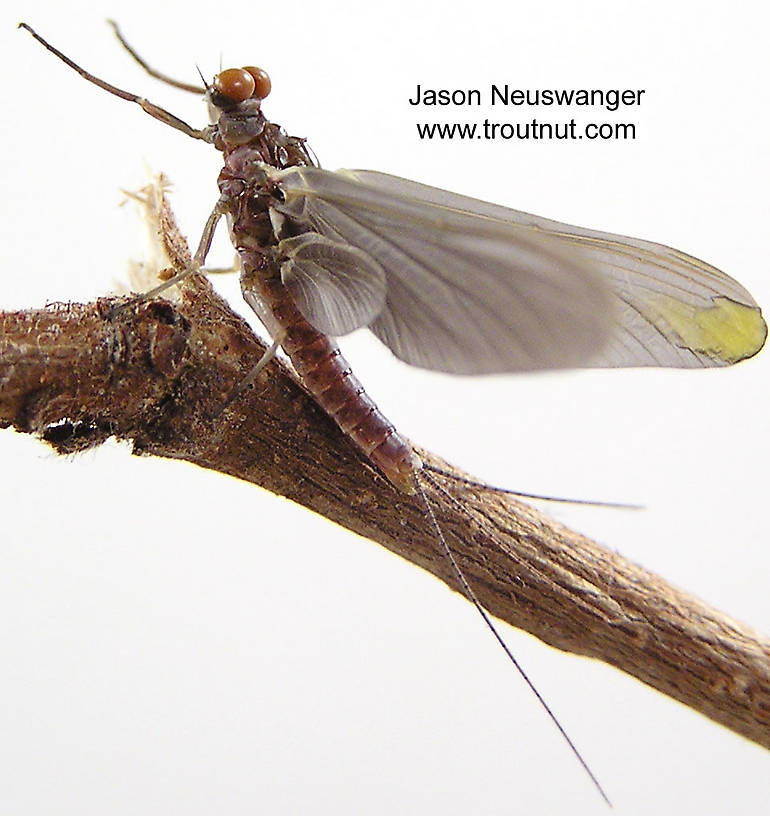
Added by Troutnut on January 25, 2006
Collected April 30, 2004 from the Namekagon River in Wisconsin
and added by Troutnut on January 25, 2006
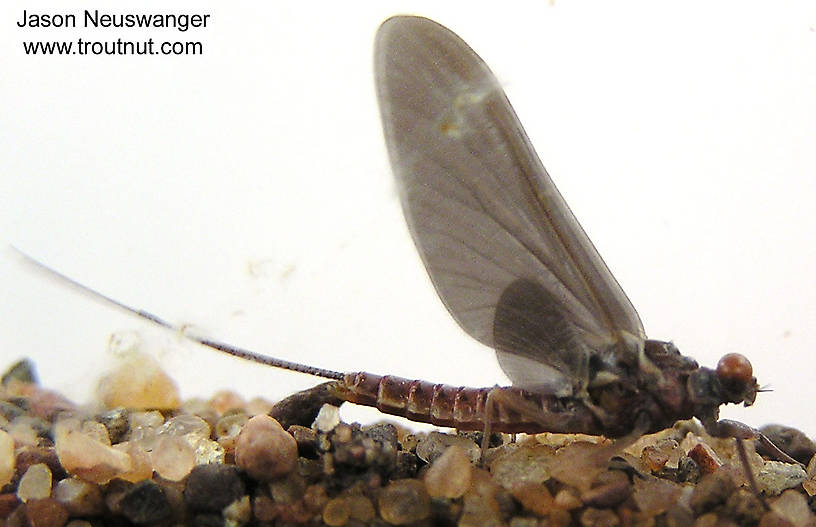
Added by Troutnut on January 25, 2006
Collected April 30, 2004 from the Namekagon River in Wisconsin
and added by Troutnut on January 25, 2006
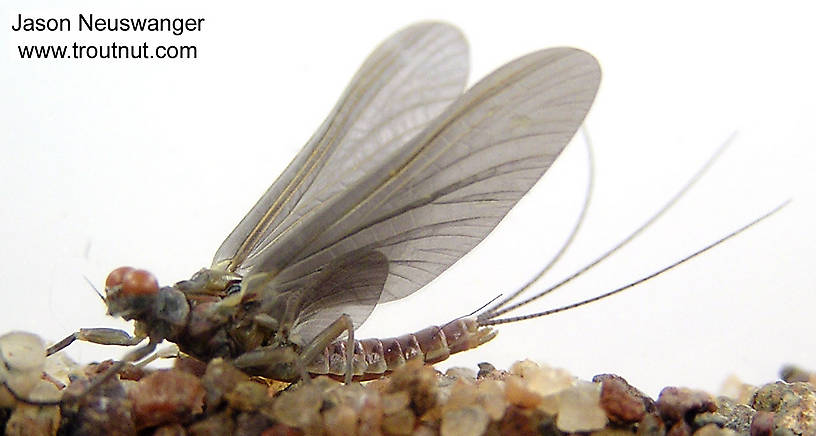
This one hatched around 2 pm on opening day of trout season.
Added by Troutnut on January 25, 2006
Collected April 30, 2004 from the Namekagon River in Wisconsin
and added by Troutnut on January 25, 2006
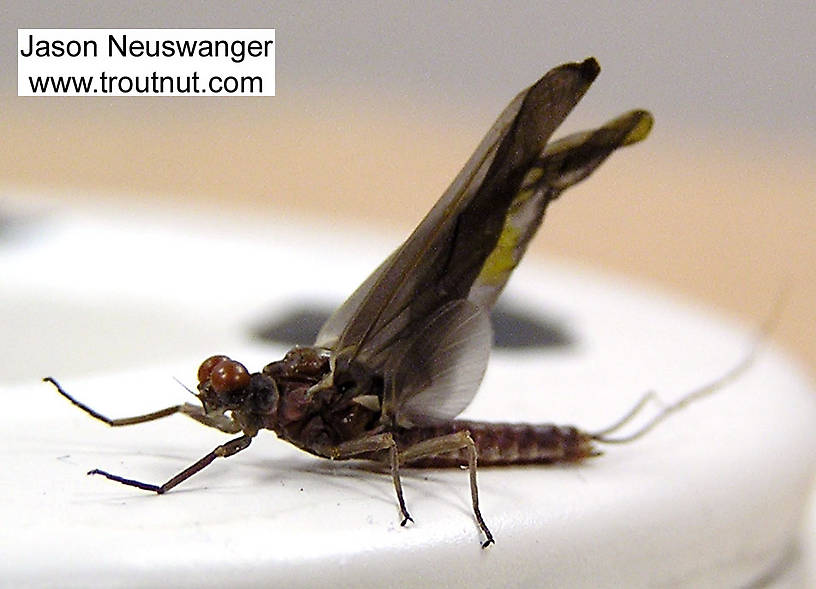
Added by Troutnut on January 25, 2006
Collected April 23, 2004 from the Namekagon River in Wisconsin
and added by Troutnut on January 25, 2006
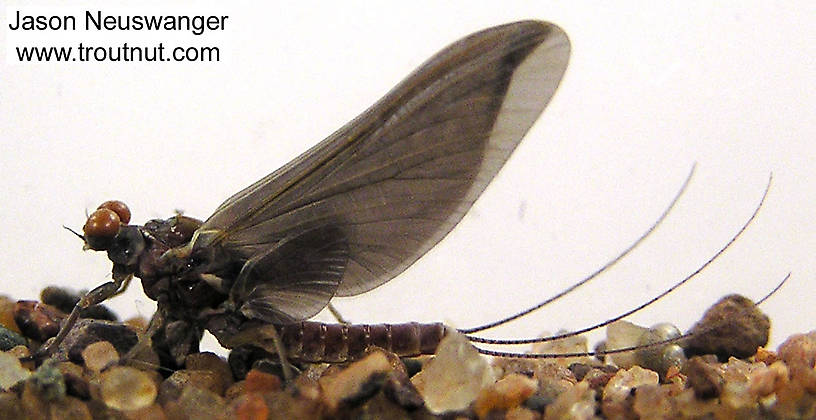
Added by Troutnut on January 25, 2006
Collected April 13, 2004 from the Namekagon River in Wisconsin
and added by Troutnut on January 25, 2006
19 Female Duns
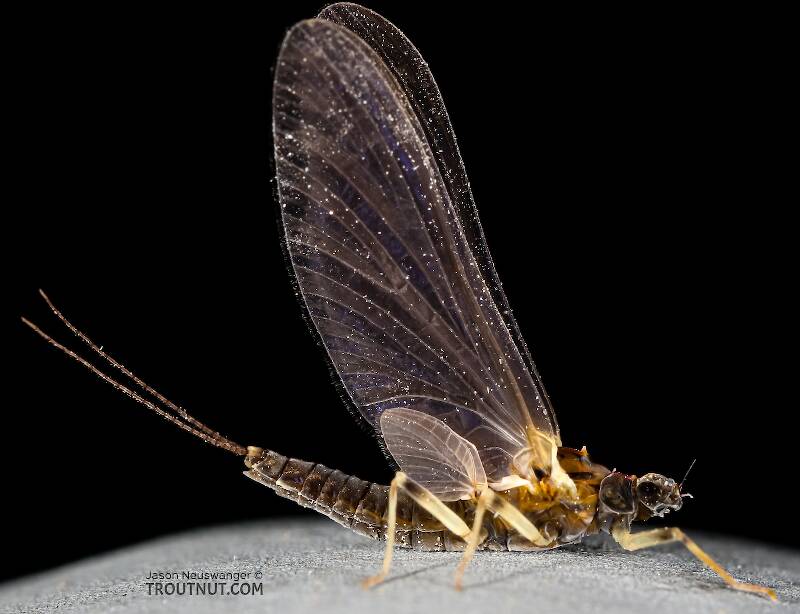
I'm fairly confident calling this dun Ephemerella tibialis because it emerged from one of several similar nymphs in my bucket, which I was able to ID with quite a bit of certainty. However, it looks very different from the other duns I currently have listed, which makes me rethink their IDs.
Added by Troutnut on August 18, 2020
Collected August 2, 2020 from the East Fork Big Lost River in Idaho
and added by Troutnut on August 18, 2020
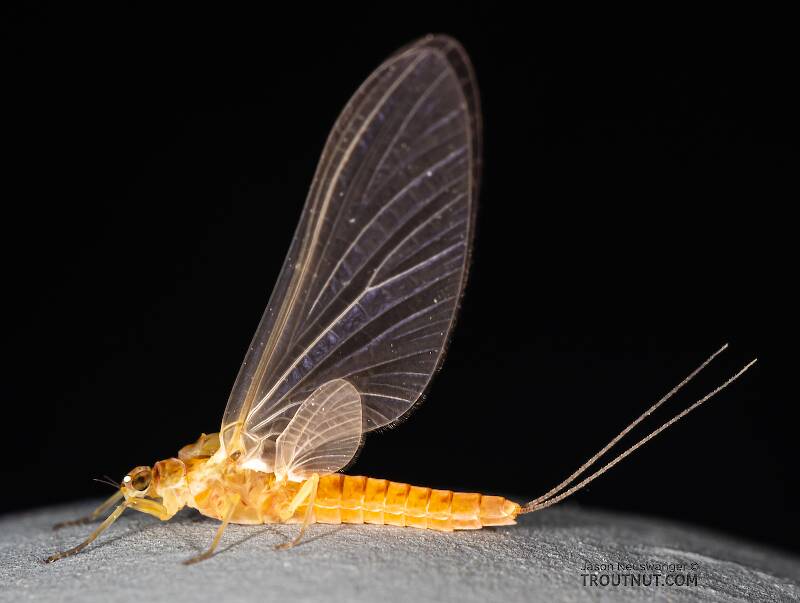
Although there is no key to female duns, I'm calling this dun Ephemerella excrucians because I collected several mature nymphs of that species on the same trip.
Added by Troutnut on July 12, 2020
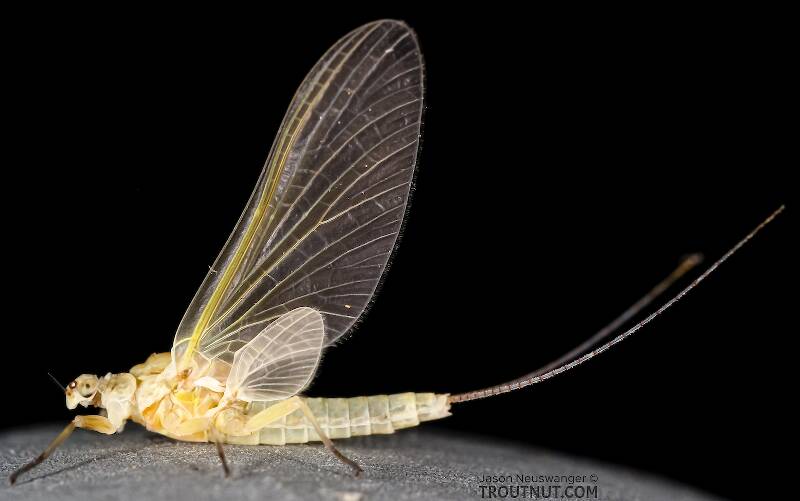
This "specimen" is actually two different duns, one missing the middle front and back left legs, the other missing the terminal filament i.e. middle tail. I added them together by accident, but since they're the same species, stage, and gender, I might as well leave them together.
Added by Troutnut on August 18, 2020
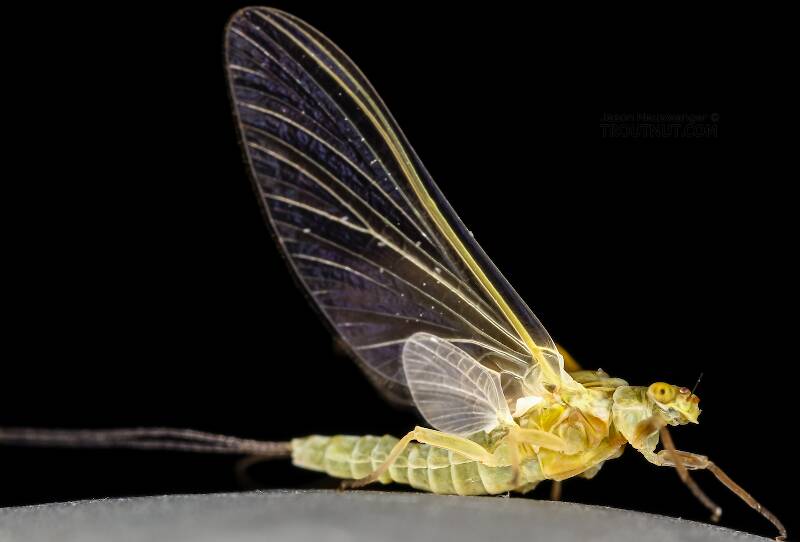
Added by Troutnut on August 17, 2020
Collected July 30, 2020 from the Henry's Fork of the Snake River in Idaho
and added by Troutnut on August 17, 2020
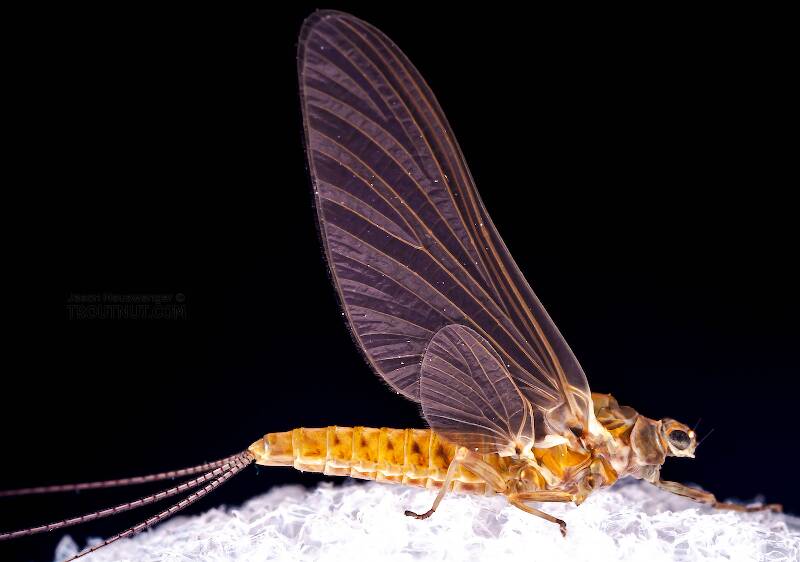
I collected this female Hendrickson dun and a male in the pool on the Beaverkill where the popular Hendrickson pattern was first created. She is descended from mayfly royalty.
Added by Troutnut on April 21, 2006
Collected April 18, 2006 from the Beaverkill River in New York
and added by Troutnut on April 21, 2006
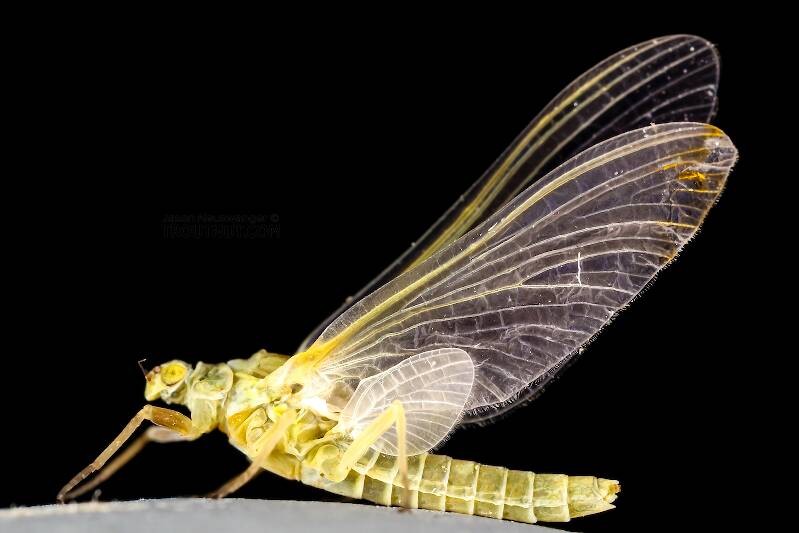
Added by Troutnut on August 17, 2020
Collected July 30, 2020 from the Henry's Fork of the Snake River in Idaho
and added by Troutnut on August 17, 2020
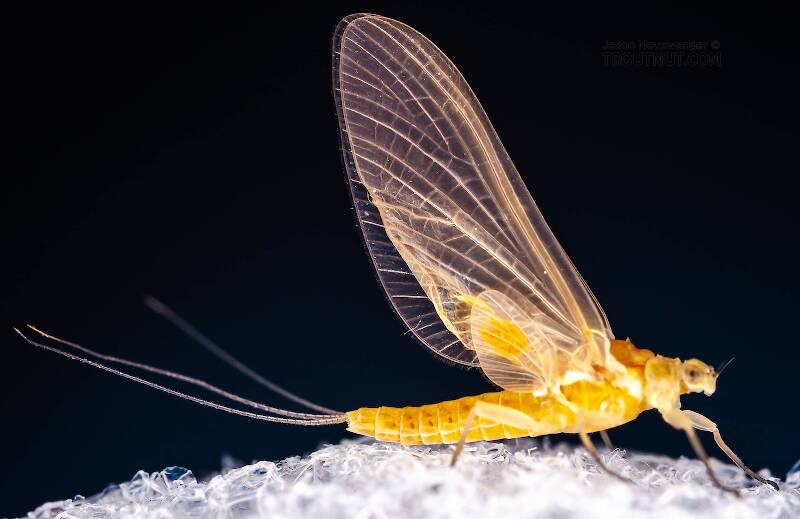
Added by Troutnut on June 4, 2007
Collected May 24, 2007 from the Little Juniata River in Pennsylvania
and added by Troutnut on June 4, 2007
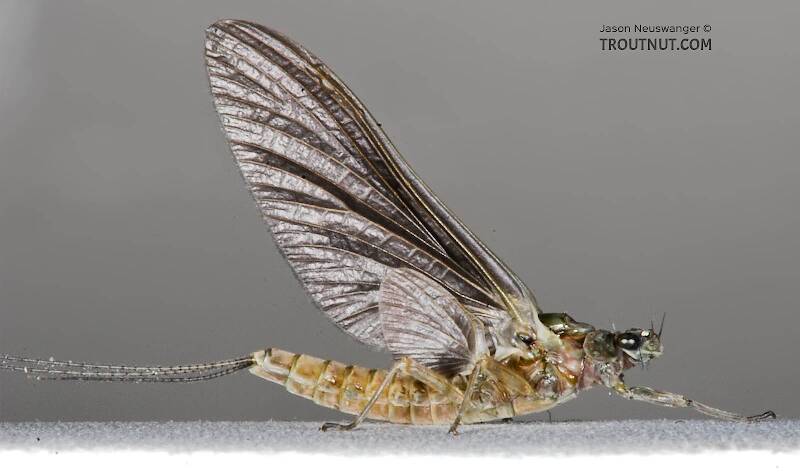
Added by Troutnut on May 16, 2006
Collected May 6, 2005 from the West Branch of the Delaware River in New York
and added by Troutnut on May 16, 2006
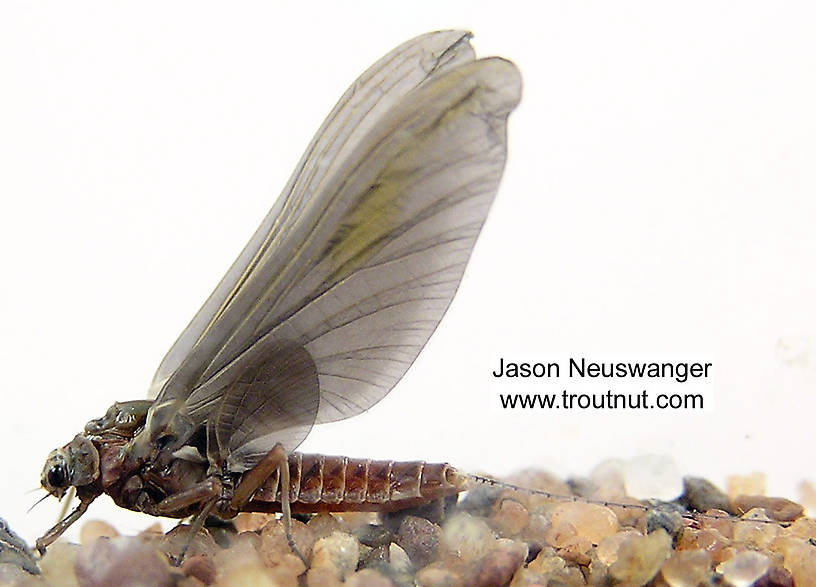
Added by Troutnut on January 25, 2006
Collected April 30, 2004 from the Namekagon River in Wisconsin
and added by Troutnut on January 25, 2006
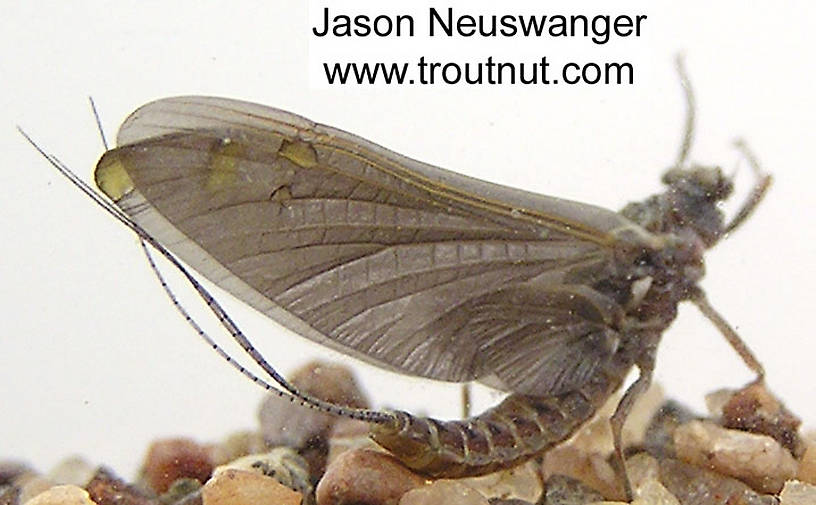
Added by Troutnut on January 25, 2006
Collected April 30, 2004 from the Namekagon River in Wisconsin
and added by Troutnut on January 25, 2006
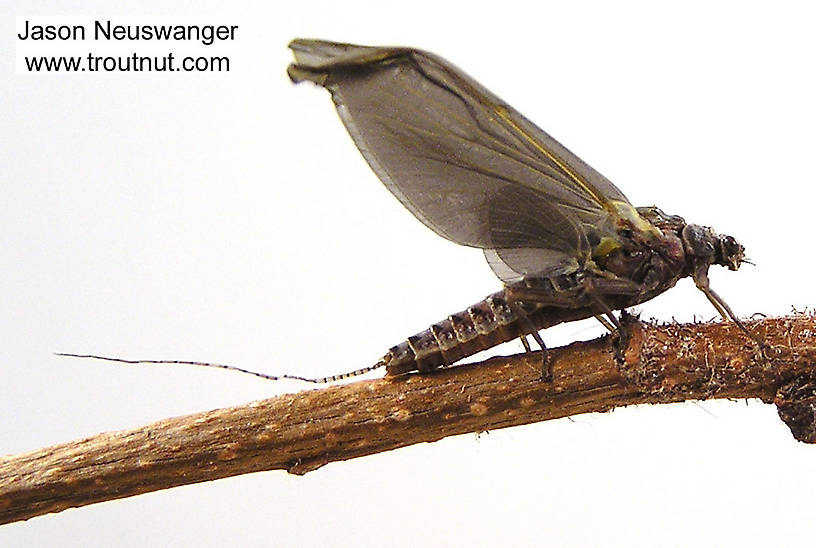
Added by Troutnut on January 25, 2006
Collected April 23, 2004 from the Namekagon River in Wisconsin
and added by Troutnut on January 25, 2006
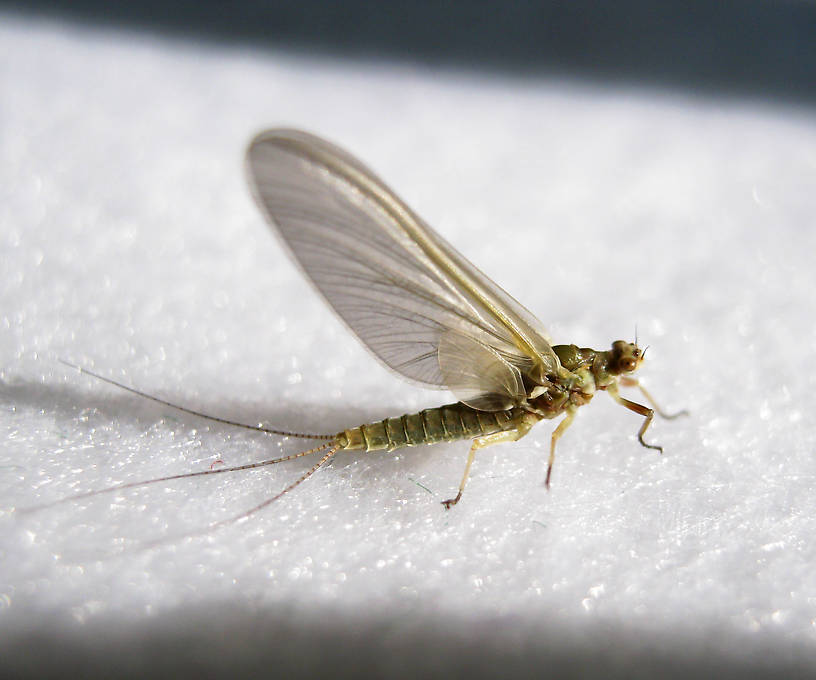
Size: 10mm. At emergence the specimen was a fairly bright olive green and there was obvious difference in color between the forewing (med. dun) and the hind-wing (pale cream). It was really noticeable as they floated by. You can just make these features out in the second photo, but not so much in the first that was taken 24 hours after capture. Total time from emergence to molting - approx. 48 hours.
Entoman
Edit 2/25/13 - This specimen was originally posted to E. d. infrequens because of its size. It turns out large size doesn't hold up as a way to tell these two apart. This is because excrucians has much greater variability than previously understood. The assumption by anglers that excrucians is always the smaller of the two is apparently not supported by science. There is a lot left to sort out with western Ephemerella species. This may include new discoveries and/or synonyms as well as reportage on new intraspecific variations broadening the descriptions of recognized species. Based on this specimen's Fall maturity, the best guess is that it is an unusual form of excrucians.
As to color, both species duns (nymphs too) demonstrate a tremendous amount of intraspecific variability from pale yellow to bright green with a multitude of sulfur shadings in between, ranging from pale amber, through orange to cinnamon and even dark brown. I've seen wings from pale cream through tannish and almost every shade of dun except the dark shades. Some have pigment stained leading edges matching their bodies, some don't. Most of these variations are undocumented except in angler references and periodicals. It seems a rare year that a new variation doesn't pop up to the notice of anglers.
Bottom line - size is only reliable if the specimens are smaller than size 16, pointing to excrucians. Otherwise, the only fairly dependable way to tell them apart (especially the females) is by timing as infrequens is the first of the two to appear, rarely lasting longer than a couple of weeks or later than the end of June most years. The problem with using timing for determination is it requires knowledge of the hatch sequences as they actually occurred for a given year on a given piece of water. Obviously, this kind of information is seldom available. Without it, determining between the two duns if they are larger than size 18 is speculative at best - at least until very late in the Summer.
Entoman
Edit 2/25/13 - This specimen was originally posted to E. d. infrequens because of its size. It turns out large size doesn't hold up as a way to tell these two apart. This is because excrucians has much greater variability than previously understood. The assumption by anglers that excrucians is always the smaller of the two is apparently not supported by science. There is a lot left to sort out with western Ephemerella species. This may include new discoveries and/or synonyms as well as reportage on new intraspecific variations broadening the descriptions of recognized species. Based on this specimen's Fall maturity, the best guess is that it is an unusual form of excrucians.
As to color, both species duns (nymphs too) demonstrate a tremendous amount of intraspecific variability from pale yellow to bright green with a multitude of sulfur shadings in between, ranging from pale amber, through orange to cinnamon and even dark brown. I've seen wings from pale cream through tannish and almost every shade of dun except the dark shades. Some have pigment stained leading edges matching their bodies, some don't. Most of these variations are undocumented except in angler references and periodicals. It seems a rare year that a new variation doesn't pop up to the notice of anglers.
Bottom line - size is only reliable if the specimens are smaller than size 16, pointing to excrucians. Otherwise, the only fairly dependable way to tell them apart (especially the females) is by timing as infrequens is the first of the two to appear, rarely lasting longer than a couple of weeks or later than the end of June most years. The problem with using timing for determination is it requires knowledge of the hatch sequences as they actually occurred for a given year on a given piece of water. Obviously, this kind of information is seldom available. Without it, determining between the two duns if they are larger than size 18 is speculative at best - at least until very late in the Summer.
Added by Entoman on October 21, 2011
Collected October 15, 2011 from the Fall River in California
and added by Entoman on October 21, 2011
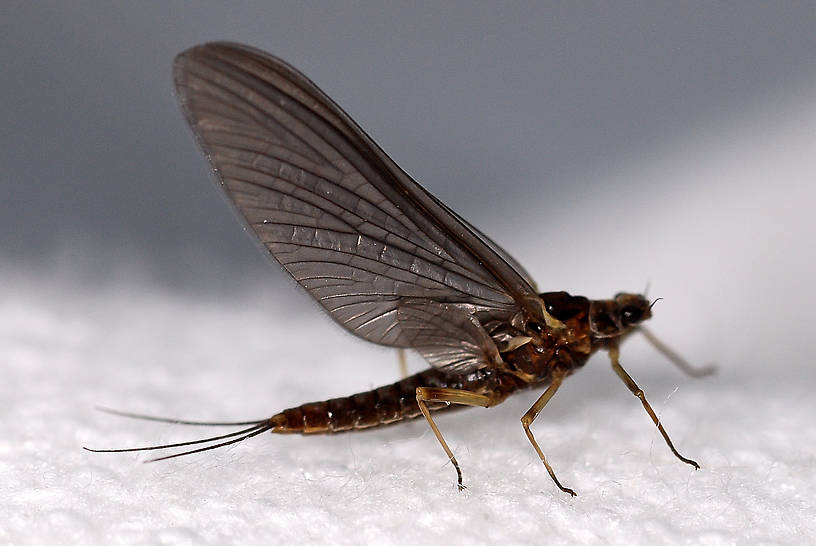
Added by Bnewell on July 2, 2011
Collected September 6, 2007 from Crazy Beaver Spring in Montana
and added by Bnewell on July 2, 2011
13 Male Spinners
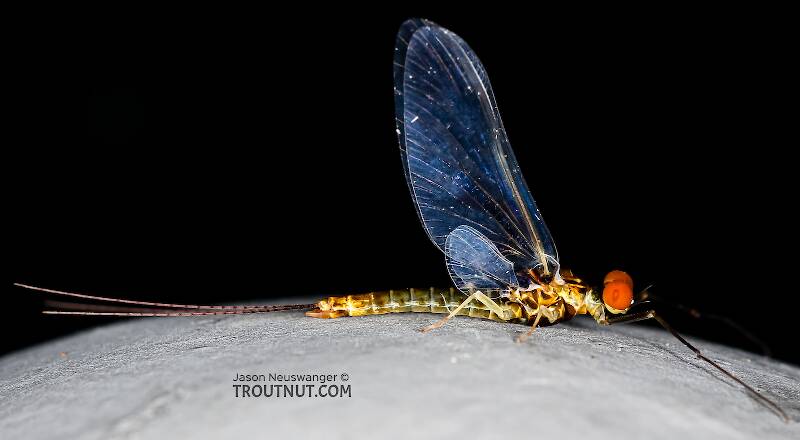
Added by Troutnut on August 18, 2020
Collected July 31, 2020 from the Henry's Fork of the Snake River in Idaho
and added by Troutnut on August 18, 2020
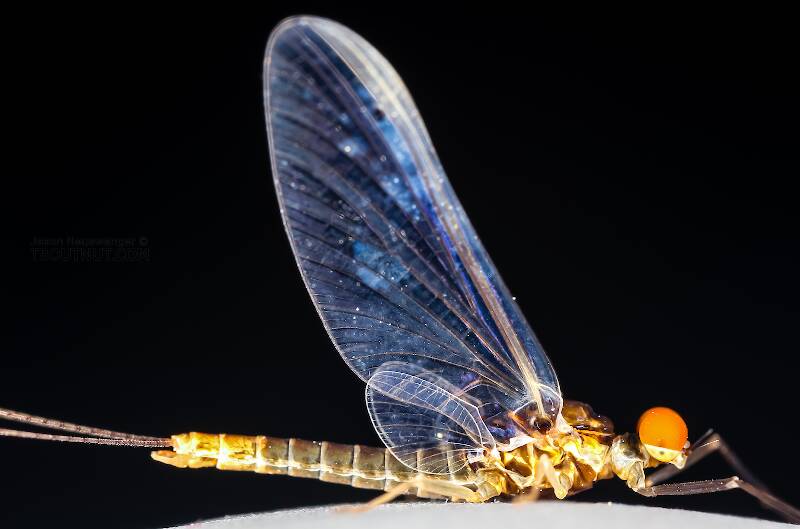
Added by Troutnut on August 16, 2020
Collected July 30, 2020 from the Henry's Fork of the Snake River in Idaho
and added by Troutnut on August 16, 2020
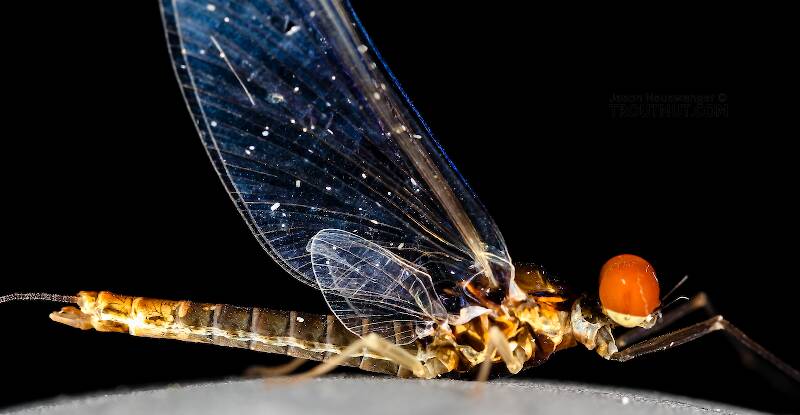
Added by Troutnut on August 16, 2020
Collected July 30, 2020 from the Henry's Fork of the Snake River in Idaho
and added by Troutnut on August 16, 2020
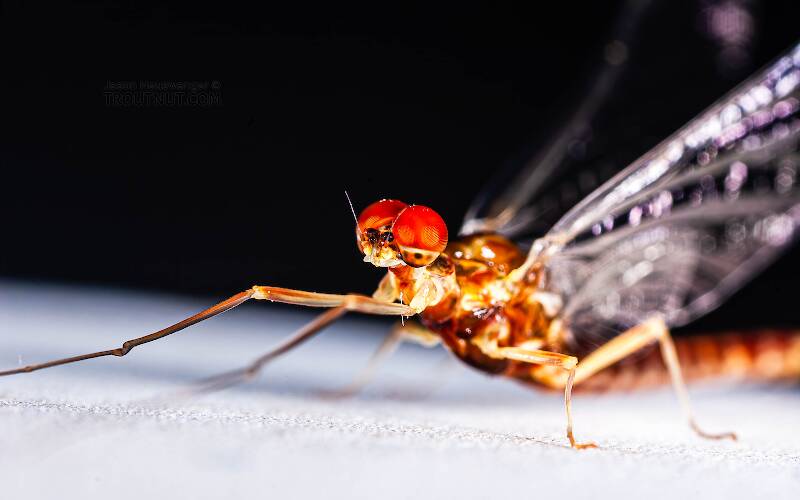
This spinner molted from a dun after being photographed, and the dun form is listed here as a separate specimen. I've rarely found a more cooperative and photogenic mayfly.
Added by Troutnut on July 16, 2011
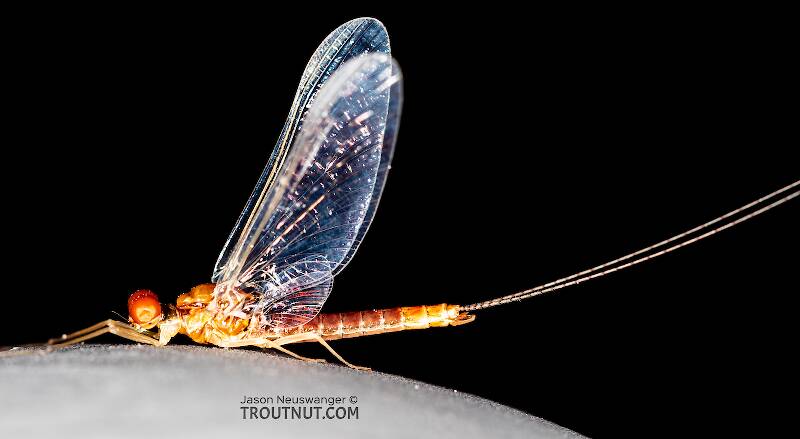
This spinner was collected in proximity to this dun and this other dun, so one of them is likely the same species. Note for ID purposes that this one is missing one of its cerci.
Added by Troutnut on July 17, 2019
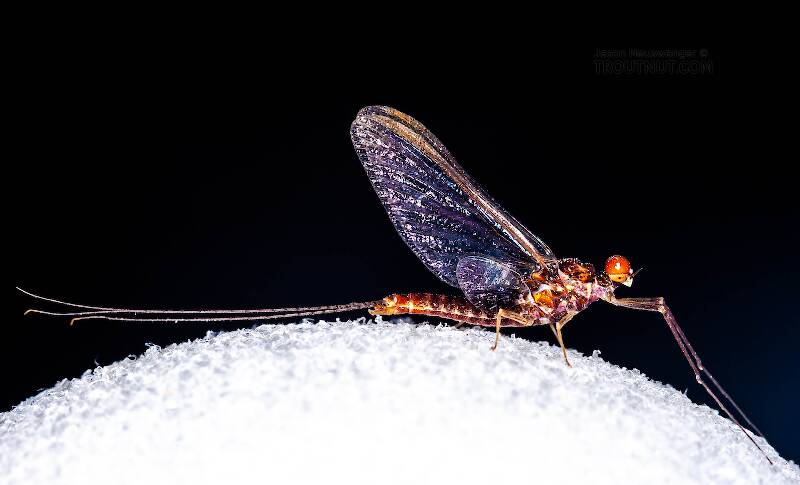
I collected this beautiful male Hendrickson specimen as a dun, along with a female Hendrickson from the same hatch. Both molted into spinners in my house within a couple of days.
Added by Troutnut on April 25, 2007
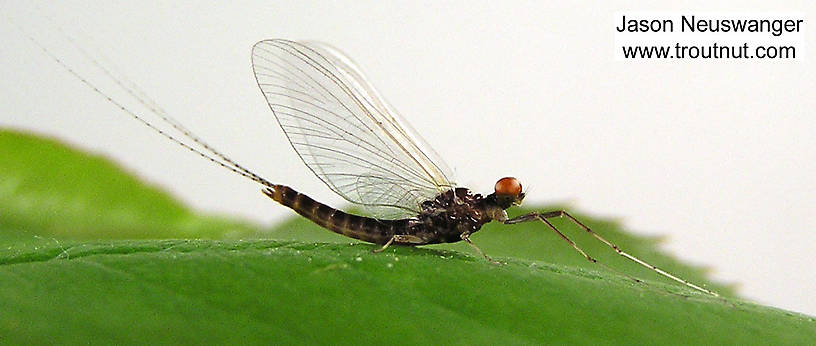
I caught this one as a dun and he molted into a spinner in my room.
Added by Troutnut on January 25, 2006
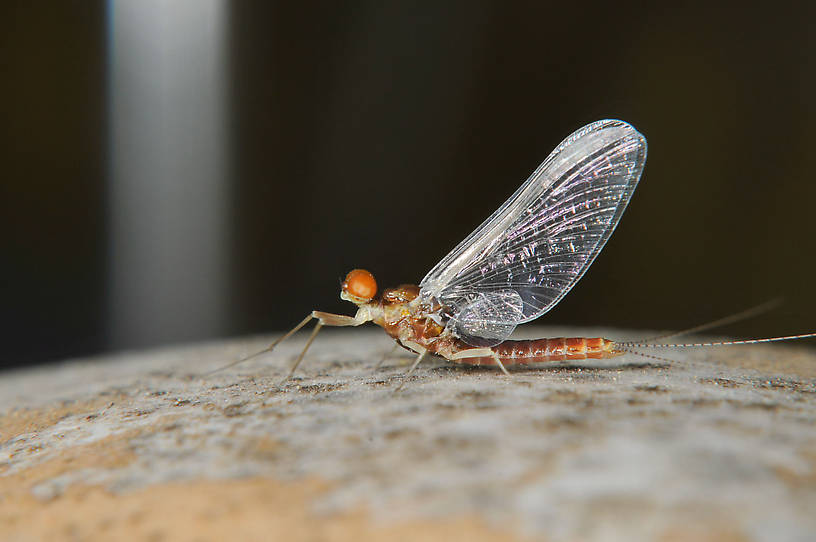
This PMD spinner belongs to the subspecies Ephemerella dorothea infrequens.
Added by Bnewell on June 24, 2011
13 Female Spinners
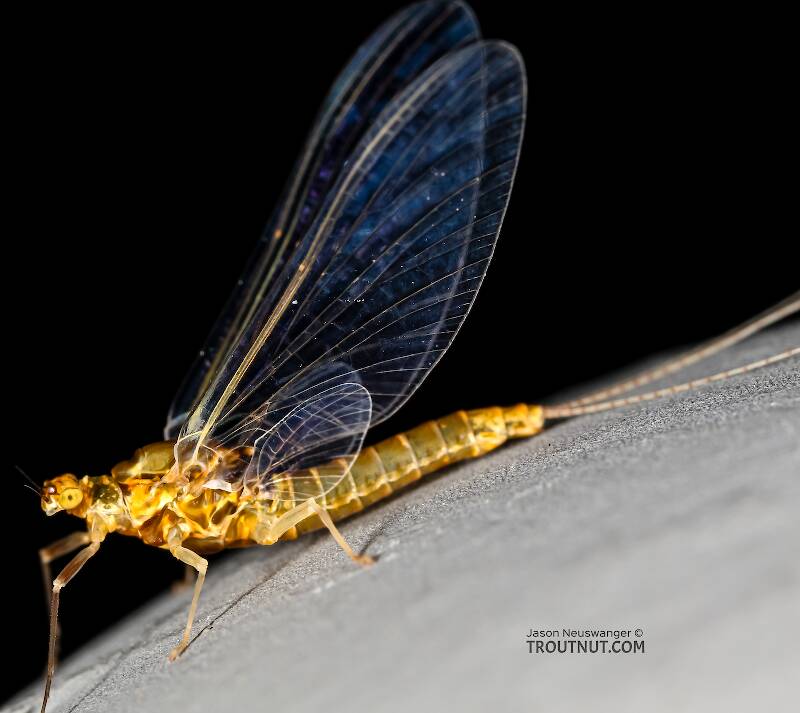
Added by Troutnut on August 17, 2020
Collected July 30, 2020 from the Henry's Fork of the Snake River in Idaho
and added by Troutnut on August 17, 2020
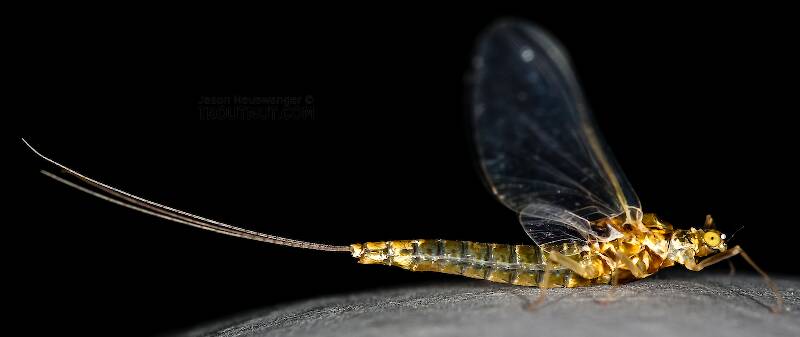
Added by Troutnut on August 16, 2020
Collected July 30, 2020 from the Henry's Fork of the Snake River in Idaho
and added by Troutnut on August 16, 2020
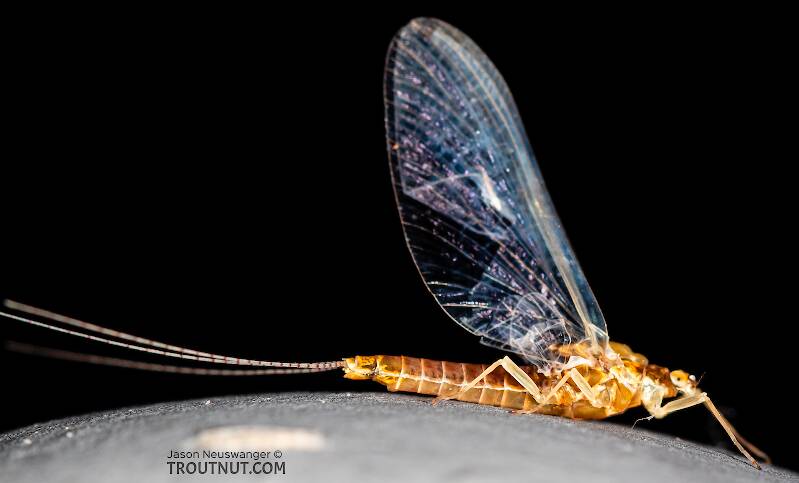
I'm calling this one Ephemerella dorothea infrequens because it was collected along with two males that positively ID to that species.
Added by Troutnut on July 18, 2019
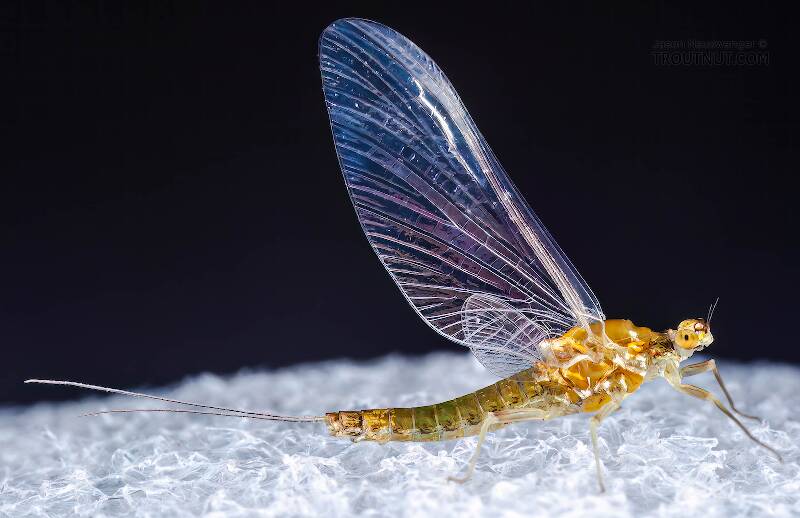
Added by Troutnut on April 22, 2006
Collected June 30, 2005 from the Bois Brule River in Wisconsin
and added by Troutnut on April 22, 2006
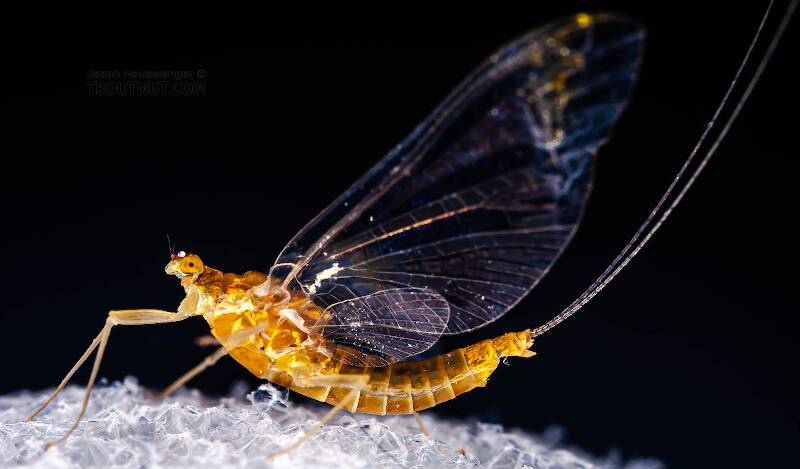
I've seen Ephemerella invaria with green egg sacs and Ephemerella subvaria with yellow one. This one seems too large for dorothea. So what is it? I'm not sure.
Many females of this species were gathered in tight clouds to lay their eggs over the riffles in a mid-sized Pocono stream right at dusk. It would have been a fishable spinner fall if I'd stuck around to wait for them.
Many females of this species were gathered in tight clouds to lay their eggs over the riffles in a mid-sized Pocono stream right at dusk. It would have been a fishable spinner fall if I'd stuck around to wait for them.
Added by Troutnut on June 4, 2007
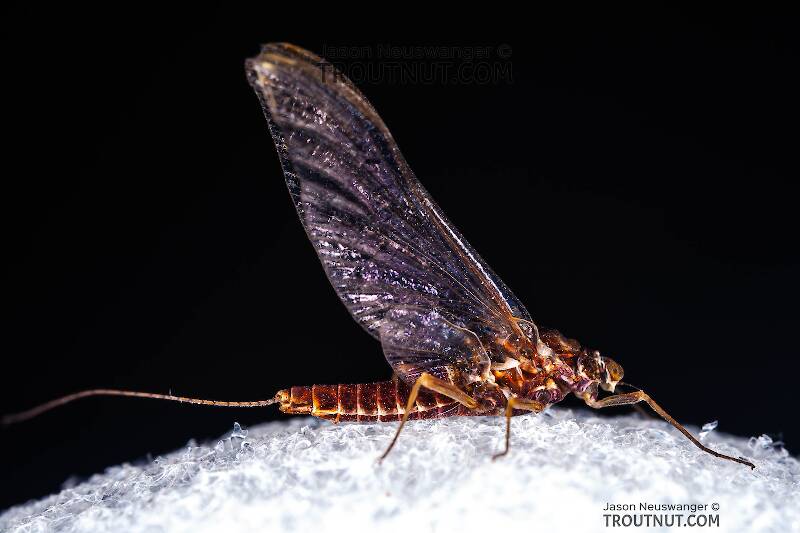
This female Hendrickson spinner is in kind of bad shape, but at least now I've got some good closeup photos of one. I collected her and a male Hendrickson as duns from the same hatch, and both molted into spinners in my house within a couple of days.
Added by Troutnut on April 25, 2007
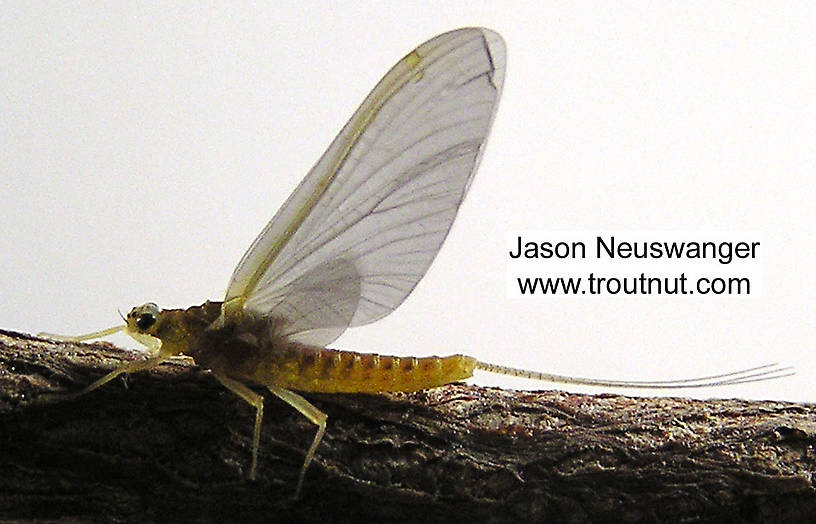
Here's the first sulphur dun I found in the 2004 season.
Added by Troutnut on January 25, 2006
Collected May 17, 2004 from the Namekagon River in Wisconsin
and added by Troutnut on January 25, 2006
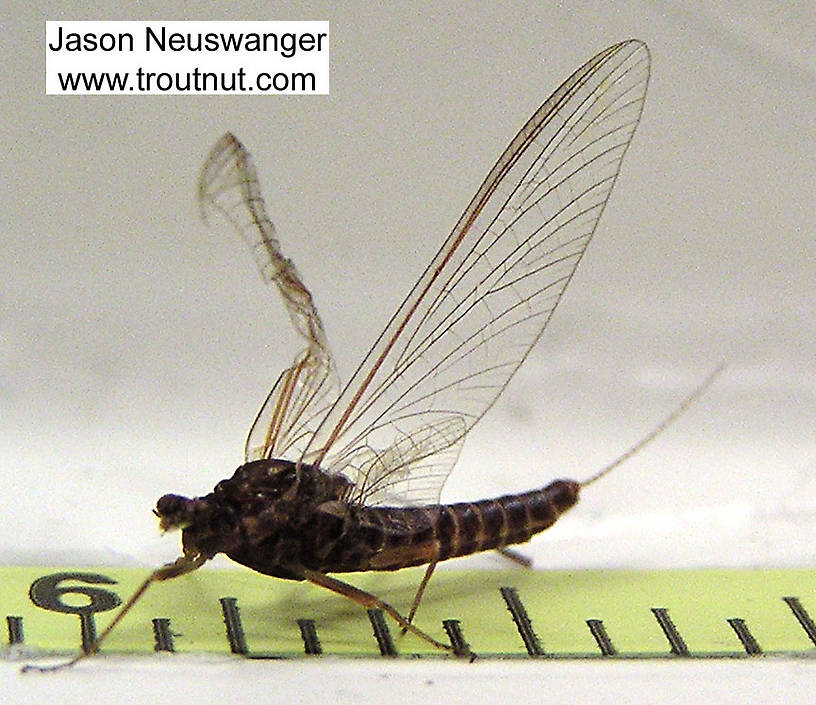
This one's a bit bedraggled because it was rainy and I had a hard time keeping anything dry, including the container I was putting mayflies in. I was practically juggling up there balanced on a rock trying to catch mayflies and trout at the same time.
Added by Troutnut on January 25, 2006
Collected May 18, 2004 from the Bois Brule River in Wisconsin
and added by Troutnut on January 25, 2006
91 Nymphs

This is an interesting one. Following the keys in Merritt R.W., Cummins, K.W., and Berg, M.B. (2019) and Jacobus et al. (2014), it keys clearly to Ephemerella. Jacobus et al provide a key to species, but some of the characteristics are tricky to interpret without illustrations. If I didn't make any mistakes, this one keys to Ephemerella mucronata, which has not previously been reported any closer to here than Montana and Alberta. The main character seems to fit well: "Abdominal terga with prominent, paired, subparallel, spiculate ridges." Several illustrations or descriptions of this holarctic species from the US and Europe seem to match, including the body length, tarsal claws and denticles, labial palp, and gill shapes. These sources include including Richard Allen's original description of this species in North America under the now-defunct name E. moffatae in Allen RK (1977) and the figures in this description of the species in Italy.
Added by Troutnut on February 20, 2023
Collected February 17, 2023 from the Yakima River in Washington
and added by Troutnut on February 20, 2023
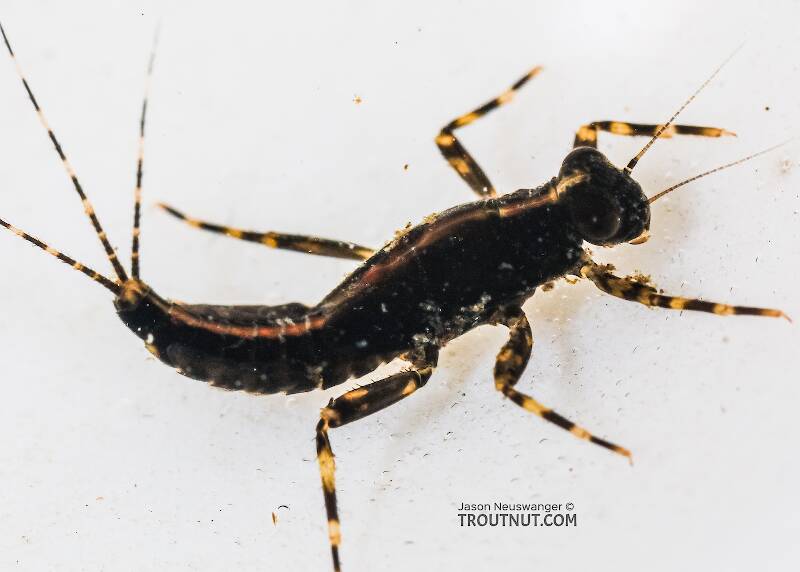
Added by Troutnut on August 18, 2020
Collected August 2, 2020 from the East Fork Big Lost River in Idaho
and added by Troutnut on August 18, 2020
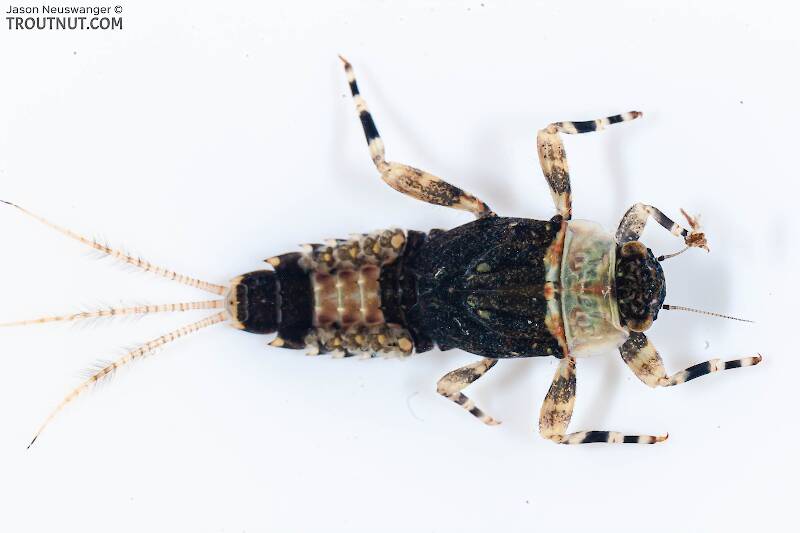
I've never seen this strange coloration on any Ephemerella subvaria nymph in a book before, but it's similar to several other specimens I collected on the same outing, including a smaller one that I photographed. They were outnumbered by the "normal" Ephemerella subvaria nymphs in the sample.
Added by Troutnut on April 7, 2006
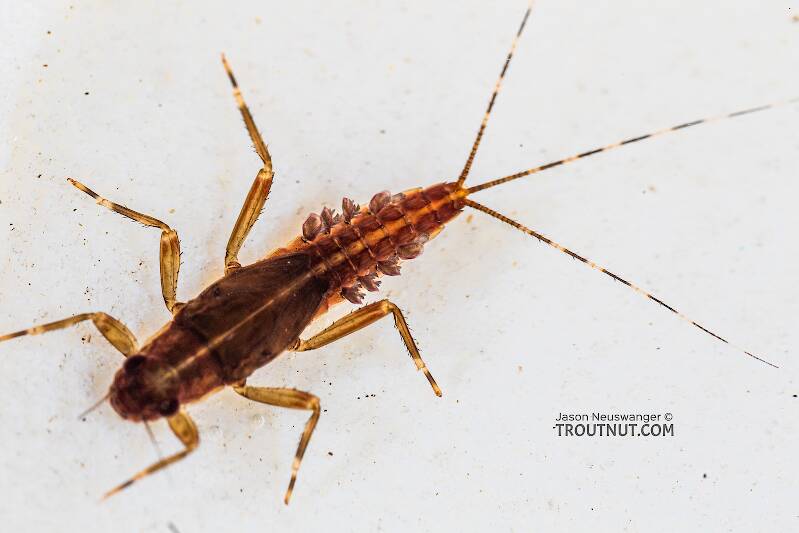
This is a puzzling one to identify and I'm not sure about the species. The maxillary palp is present and segmented, and the maxillary canines are not strongly serrate laterally. I think it's Ephemerella, not Serratella. The ventral lamellae of the gills on abdominal segment 6 have a clear median notch with a depth at least half the length of the lamellae, which points toward a couple of uncommon species (most likely Ephemerella alleni), but the abdominal tubercles and coloration don't fit that species. To add to the confusion, none of the above species are expected to emerge in the fall, as far as I know. I'm going to call this one Ephemerella aurivillii for now, but that's highly uncertain.
Added by Troutnut on September 18, 2020
Collected September 9, 2020 from the Foss River in Washington
and added by Troutnut on September 18, 2020
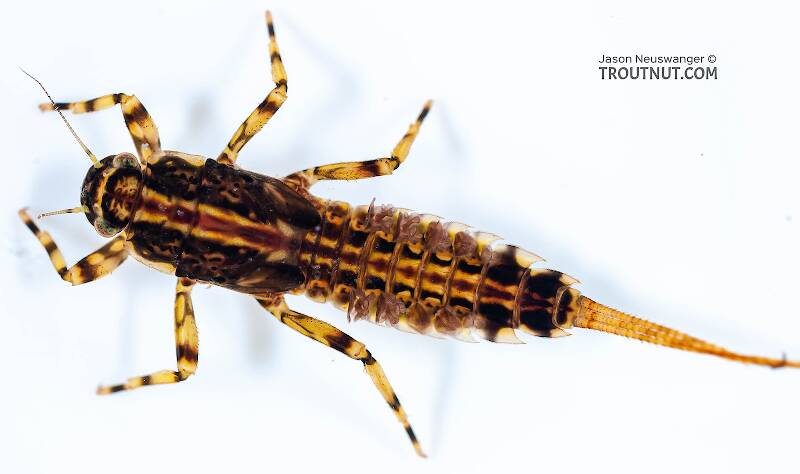
This specimen was collected together with a lighter one of the same species.
It resembles another specimen from about 1300 miles away in Wisconsin, which I tentatively called Ephemerella needhami. This one has much less prominent abdominal tubercles. It may be that they're both the same species and I don't have my identifications straight.
It resembles another specimen from about 1300 miles away in Wisconsin, which I tentatively called Ephemerella needhami. This one has much less prominent abdominal tubercles. It may be that they're both the same species and I don't have my identifications straight.
Added by Troutnut on April 21, 2006
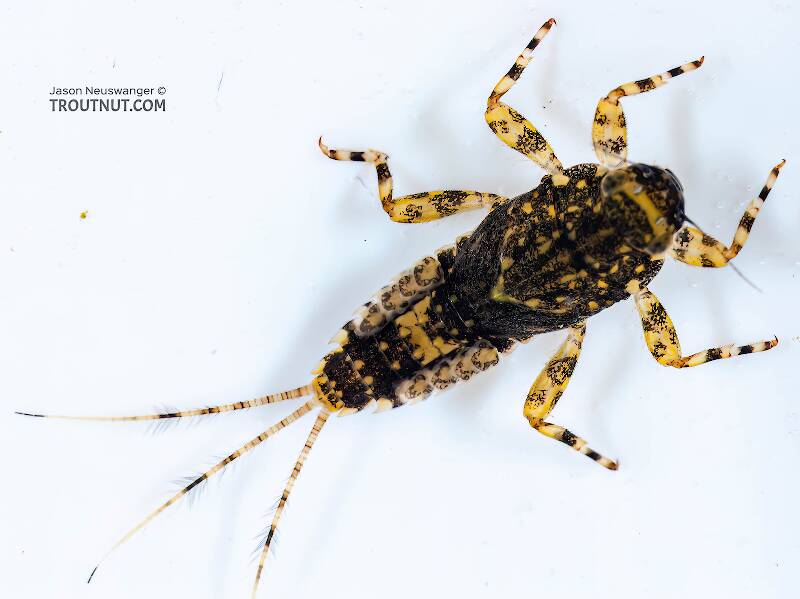
This small Ephemerella invaria nymph was at least a month away from emergence.
Added by Troutnut on April 21, 2006
Collected April 18, 2006 from the Beaverkill River in New York
and added by Troutnut on April 21, 2006
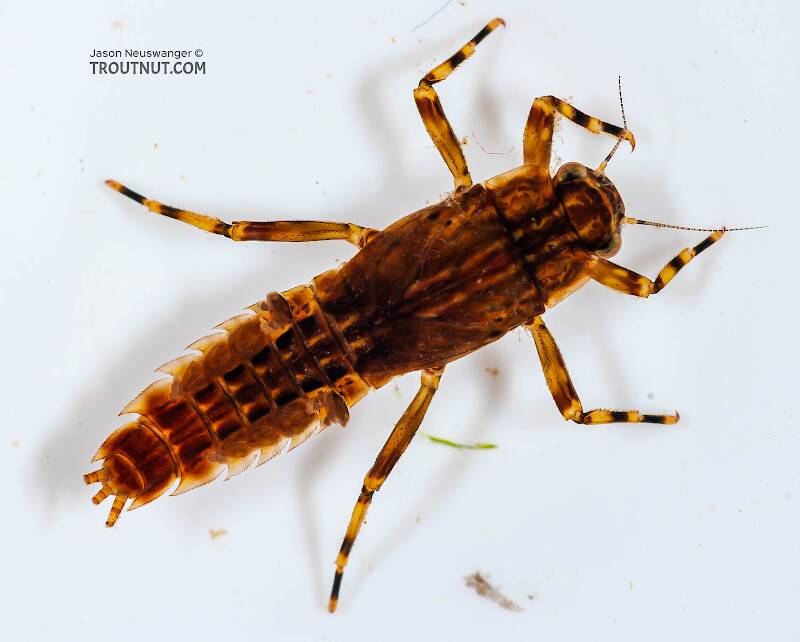
This specimen isn't in the best of shape, as it's missing all three tails, but it's the only one of its species I captured in this sample.
Added by Troutnut on May 18, 2007
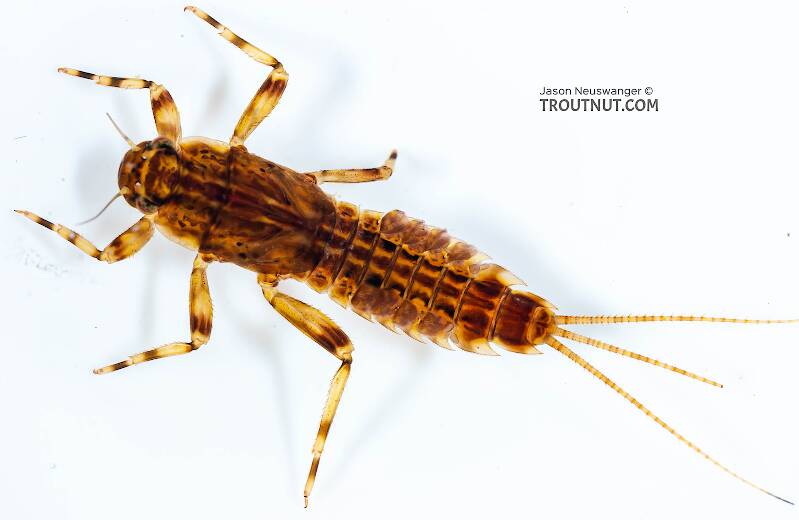
This specimen was collected together with a darker one of the same species.
Added by Troutnut on April 21, 2006
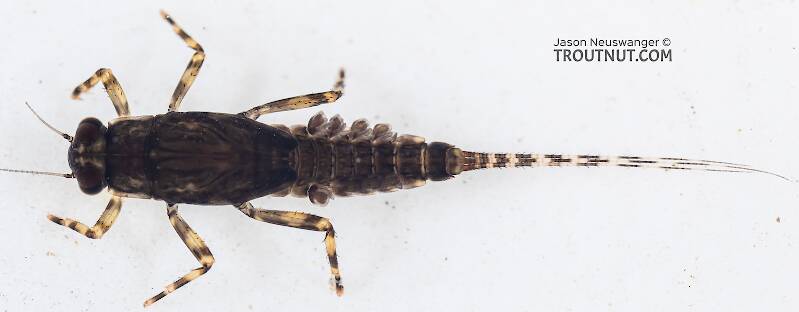
Added by Troutnut on July 26, 2019
Collected July 24, 2019 from Mystery Creek #249 in Washington
and added by Troutnut on July 26, 2019
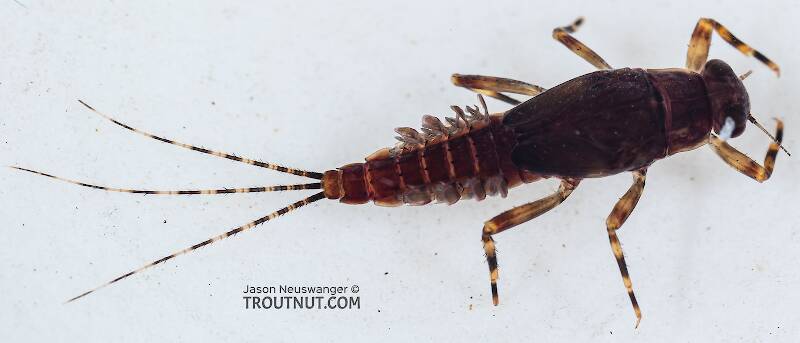
Added by Troutnut on July 26, 2019
Collected July 24, 2019 from Mystery Creek #249 in Washington
and added by Troutnut on July 26, 2019
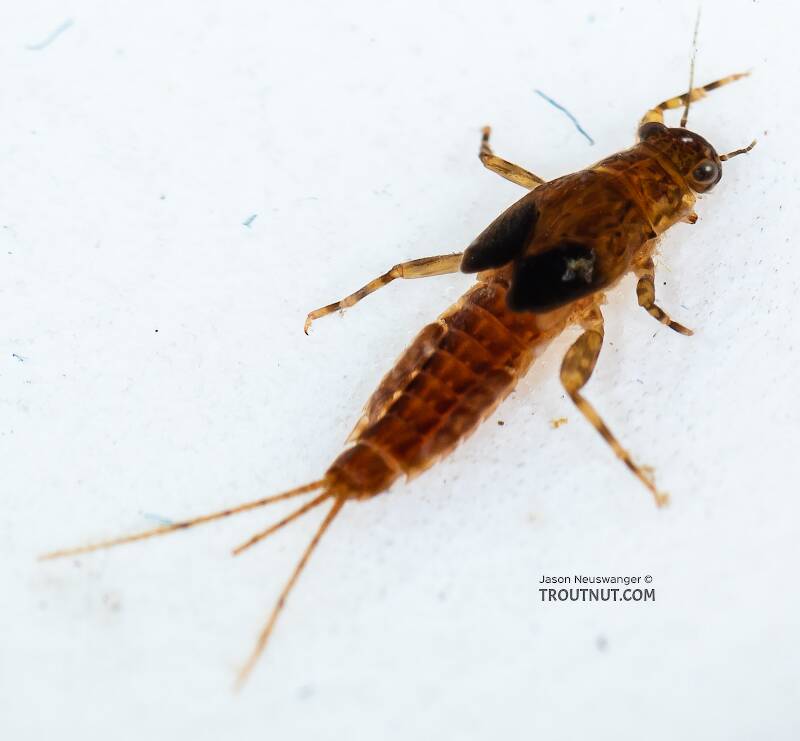
Added by Troutnut on June 14, 2019
Collected June 12, 2019 from the South Fork Snoqualmie River in Washington
and added by Troutnut on June 14, 2019
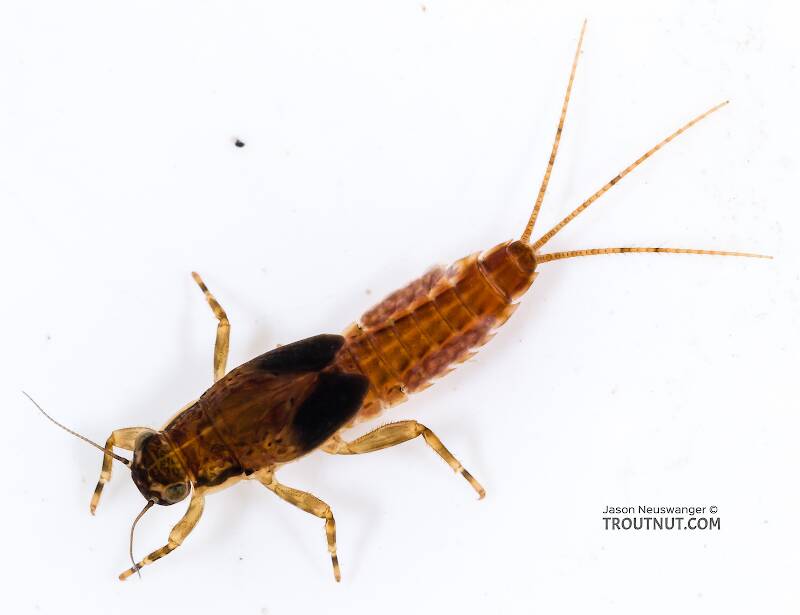
Added by Troutnut on June 18, 2018
Collected June 15, 2018 from the South Fork Snoqualmie River in Washington
and added by Troutnut on June 18, 2018
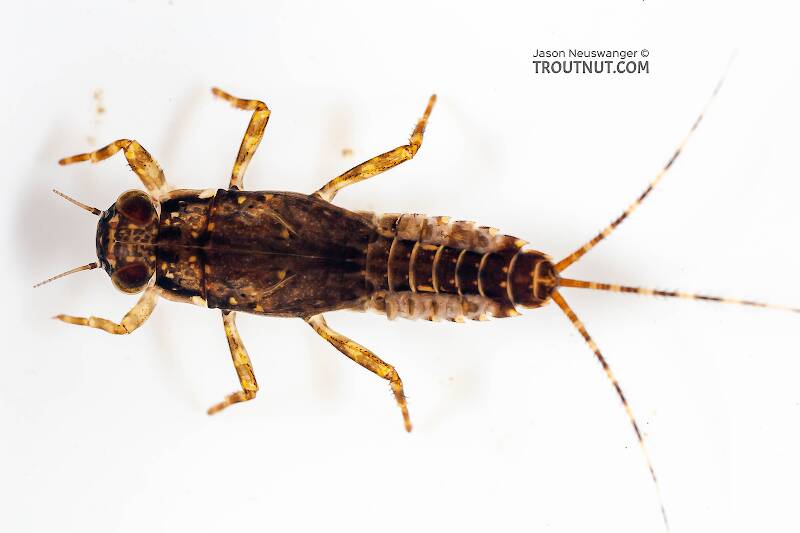
I keyed this nymph carefully under a microscope to check that it's Ephemerella dorothea.
Added by Troutnut on June 4, 2007
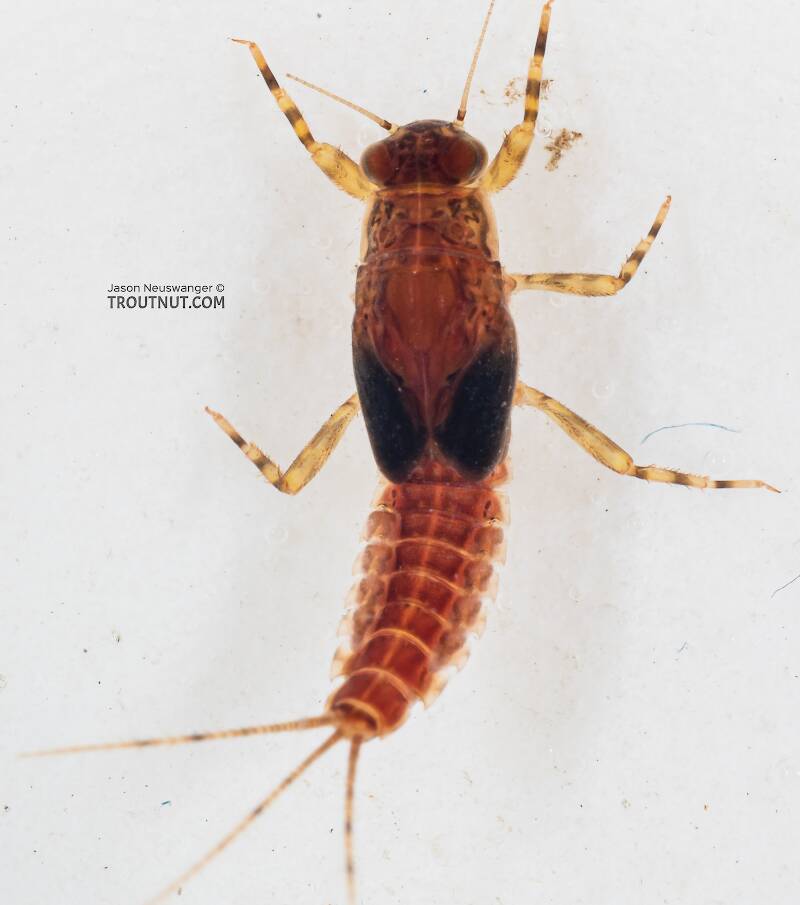
I used the ID of this nymph (and some others like it) to infer the identity of a female dun collected on the same trip.
Added by Troutnut on July 12, 2020
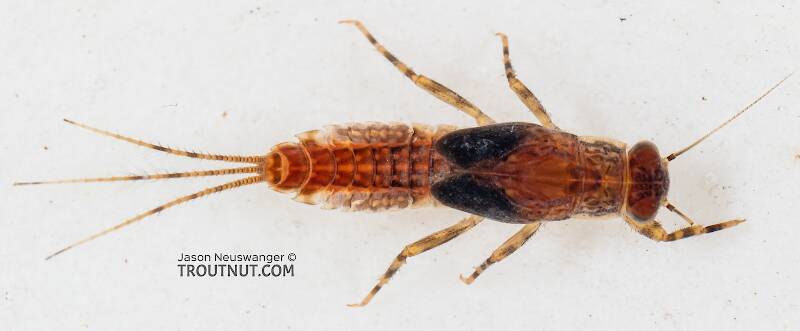
Added by Troutnut on July 12, 2020
Collected July 5, 2020 from the Dosewallips River in Washington
and added by Troutnut on July 12, 2020
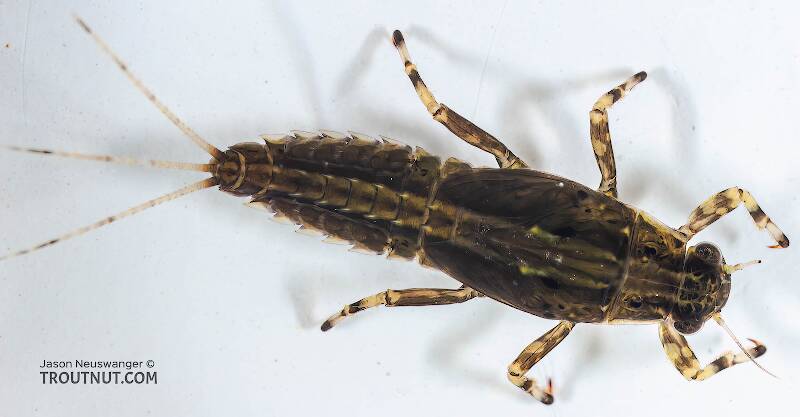
I photographed three strange striped Ephemerella nymphs from the same trip on the same river: this one, a brown one, and a very very striped one. I have tentatively put them all in Ephemerella needhami for now.
Added by Troutnut on May 26, 2006
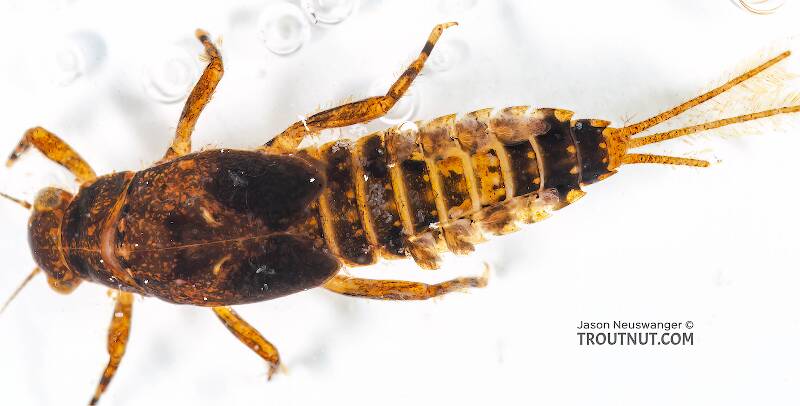
I spent a while with a microscope to fairly positively identify this specimen as Ephemerella excrucians.
Added by Troutnut on May 26, 2006
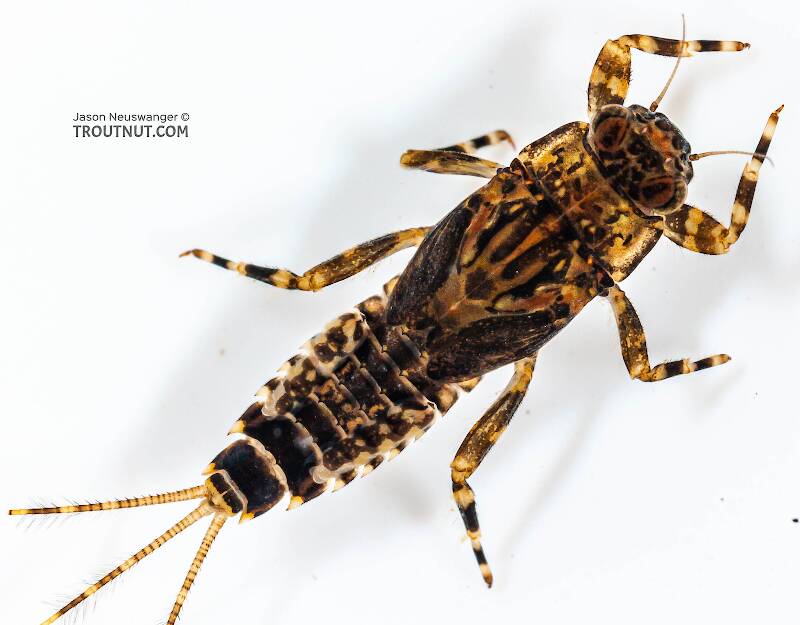
The striking coloration of this Ephemerella nymph earned it a turn under the camera lens. It has a different look than others I've collected, but I still might tentatively guess it belongs to the widely variable (and ironically named) invaria species.
Added by Troutnut on April 22, 2007
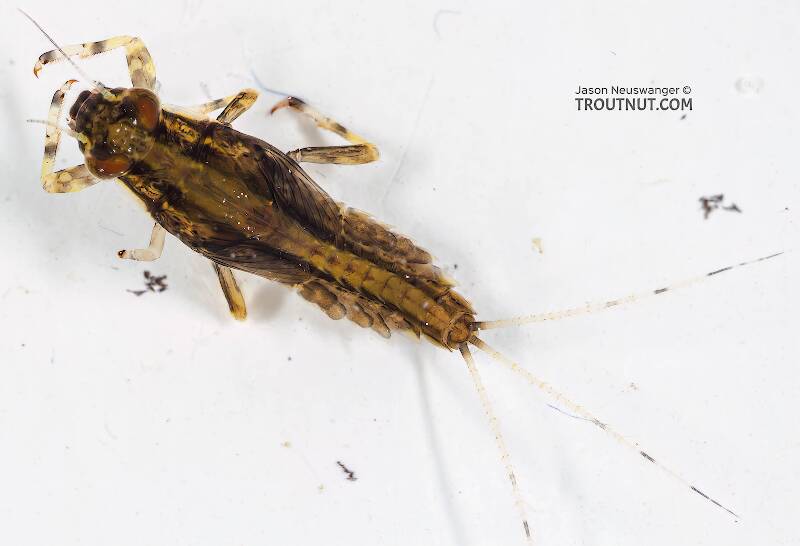
I photographed three strange striped Ephemerella nymphs from the same trip on the same river: a black and olive one, a brown one, and this one. I have tentatively put them all in Ephemerella needhami for now.
Added by Troutnut on May 26, 2006
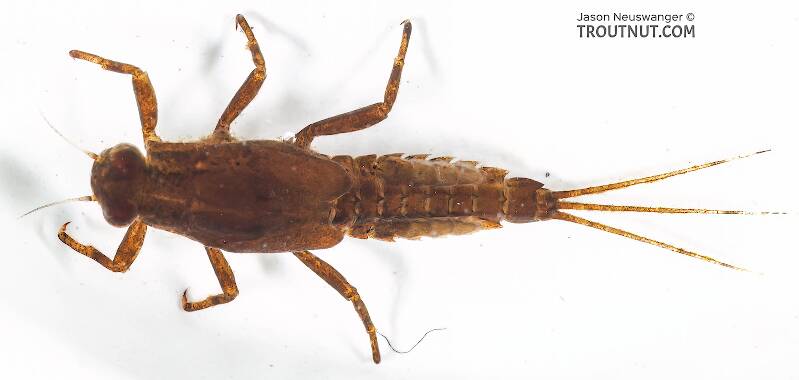
I took quite a few notes at the microscope when I collected this specimen. They're attached to the appropriate pictures.
I found this specimen in the same collection as a similar one. Since I only have strange views of this one, it's possible that they're actually the same specimen and I somehow confused my picture-ordering and got the impression that they're different nymphs.
I found this specimen in the same collection as a similar one. Since I only have strange views of this one, it's possible that they're actually the same specimen and I somehow confused my picture-ordering and got the impression that they're different nymphs.
Added by Troutnut on May 26, 2006
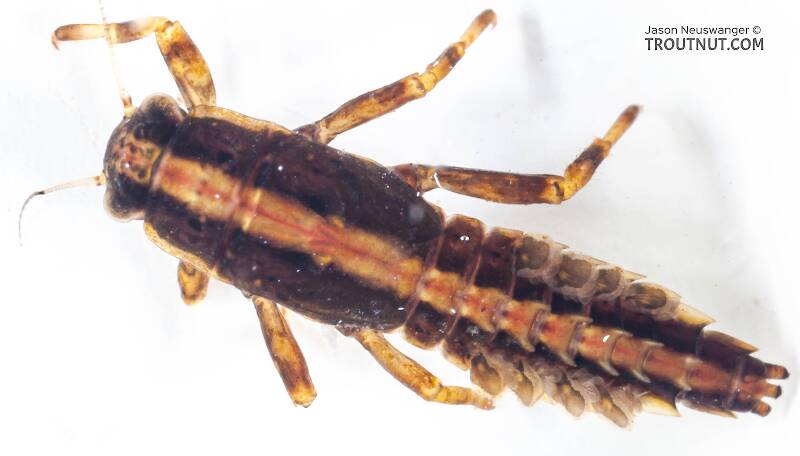
This specimen strikingly resembles another specimen from about 1300 miles away in the Catskills, which I tentatively called Ephemerella aurivillii. This one has much more prominent abdominal tubercles. It may be that they're both the same species and I don't have my identifications straight.
Added by Troutnut on May 24, 2006
Collected June 4, 2005 from the Long Lake Branch of the White River in Wisconsin
and added by Troutnut on May 24, 2006
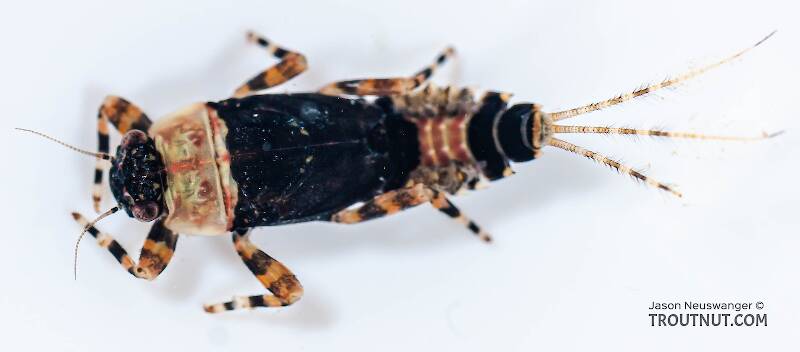
I've never seen this strange coloration on any Ephemerella subvaria nymph in a book before, but it's similar to several other specimens I collected on the same outing, including a larger one that I photographed. They were outnumbered by the "normal" Ephemerella subvaria nymphs in the sample.
Added by Troutnut on April 7, 2006
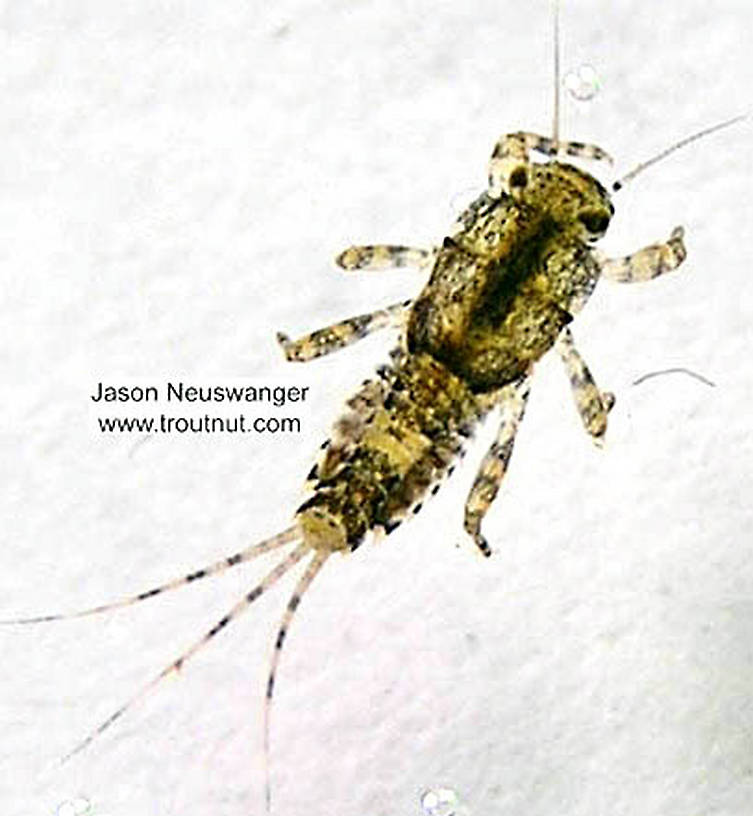
Added by Troutnut on January 25, 2006
Collected January 12, 2004 from the Namekagon River in Wisconsin
and added by Troutnut on January 25, 2006
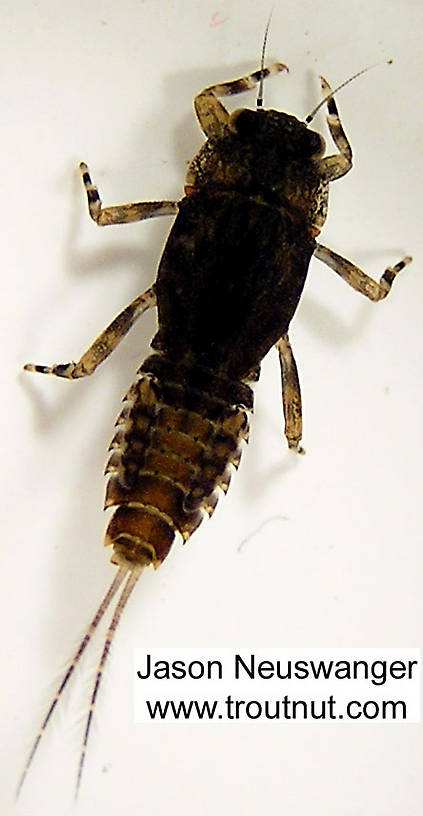
This is one of the nymphs I collected doing something very, very strange on March 17th 2004. In the middle of the day, around 2 pm, in the water right around my feet I watched lots of Ephemerella nymphs clumsily swimming up all the way to the surface and then just kind of drifting and wiggling around in the water column. None hatched. They seemed to do it more intensely when the sun was out. It wasn't the time of day for the normal invertebrate drift phenomenon, and as far as I know invertebrate drift doesn't involve this kind of clear effort to swim all the way to the surface. I didn't need a net to catch them, I just reached down into the water and grabbed them with my fingers just below the surface.
The prominent abdominal tubercles aren't quite black, though, and the general color is a dark brown, though I saw nymphs with all Hendrickson color stages behaving strangely.
The prominent abdominal tubercles aren't quite black, though, and the general color is a dark brown, though I saw nymphs with all Hendrickson color stages behaving strangely.
Added by Troutnut on January 25, 2006
Collected March 16, 2004 from the Namekagon River in Wisconsin
and added by Troutnut on January 25, 2006
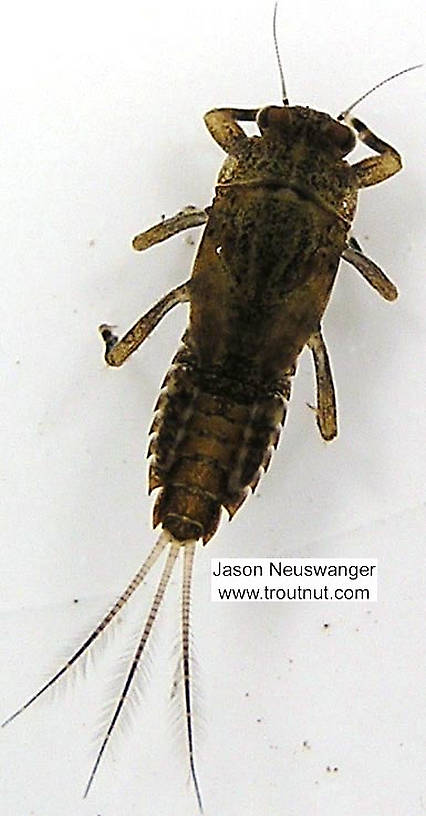
This is another unusual brown Ephemerella nymph. The "fan-tail" which defines the Ephemerella genus is particularly evident on this specimen.
Added by Troutnut on January 25, 2006
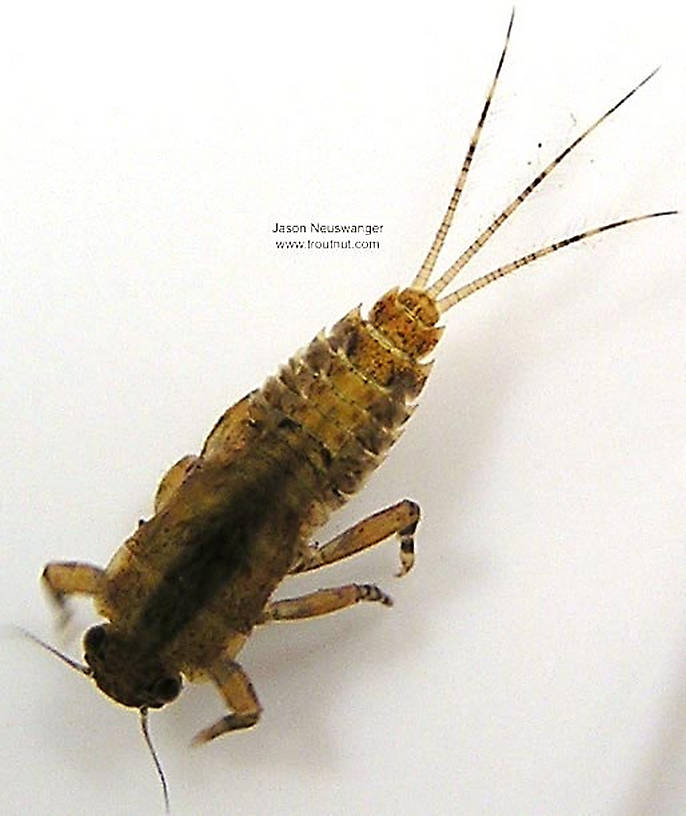
This is another peculiar brownish Ephemerella. It has double-banded tibiae and prominent black-fringed tubercles.
Added by Troutnut on January 25, 2006
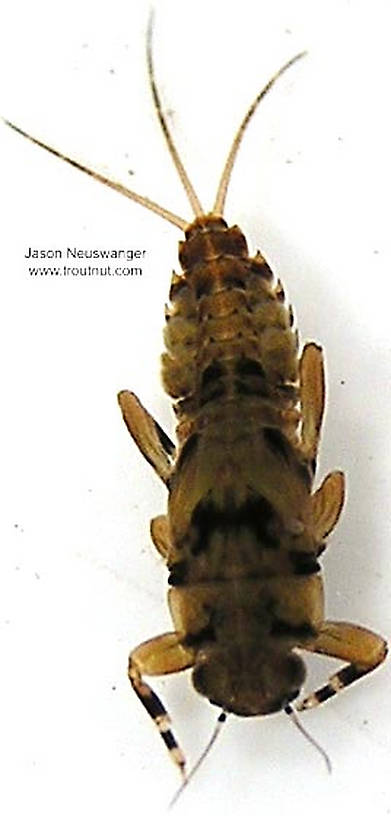
This pretty Ephemerella nymph has really weird markings. It has one band on the tibiae and a thin but distinct dorsal stripe faded in the center which looks very different from the stripes on Ephemerella needhami and Ephemerella aurivillii. It definitely has the fan tail characteristic of the Ephemerella genus.
Added by Troutnut on January 25, 2006
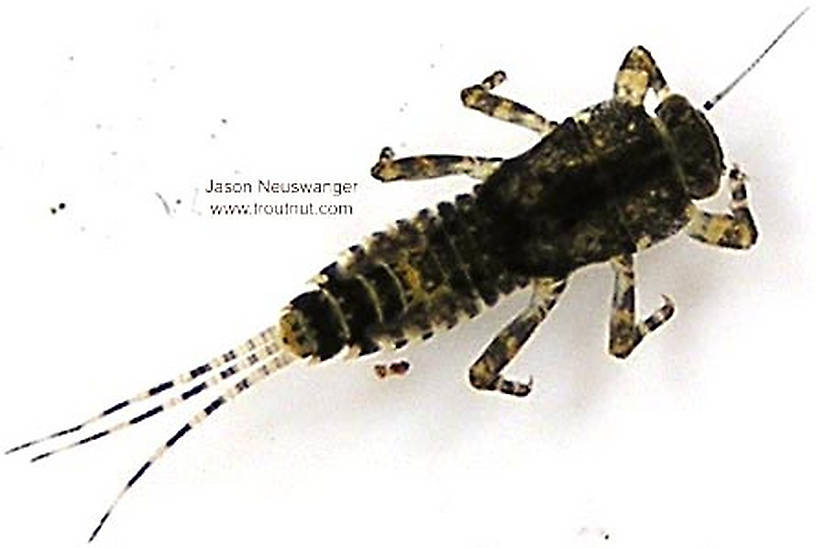
I looked at this nymph closely under a microscope to ascertain some key features I was wondering about in previous photographs of similar specimens. It definitely does have the fan-tail characteristic of the Ephemerella genus. It also has strongly 2-banded tibiae and definite tiny abdominal tubercles.
Added by Troutnut on January 25, 2006
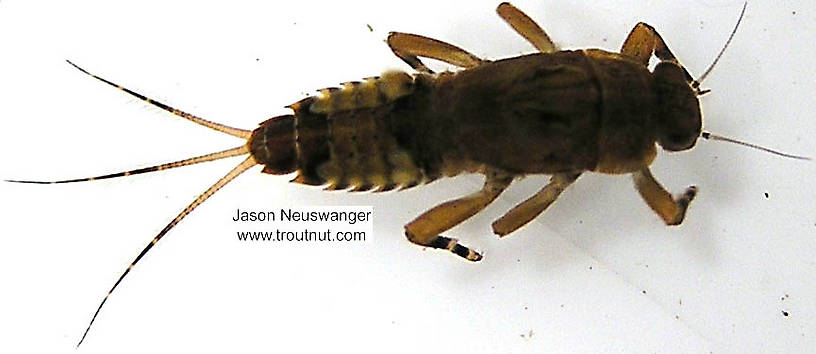
Here's another nymph with strange markings subvaria. I suspect it's the same species and it's just wide individual variation.
Added by Troutnut on January 25, 2006
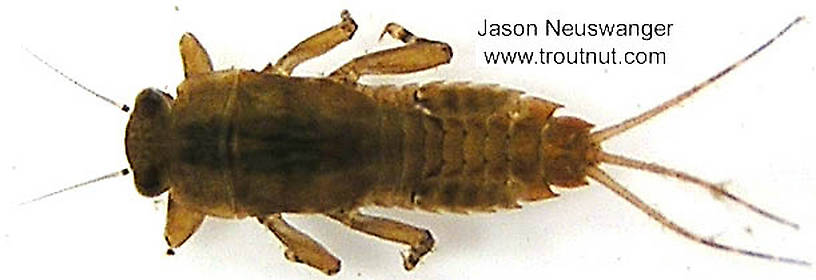
Here's another nymph with the strange brownish coloring rather than the olive I usually see for subvaria. I suspect it's the same species and it's just wide individual variation.
Added by Troutnut on January 25, 2006
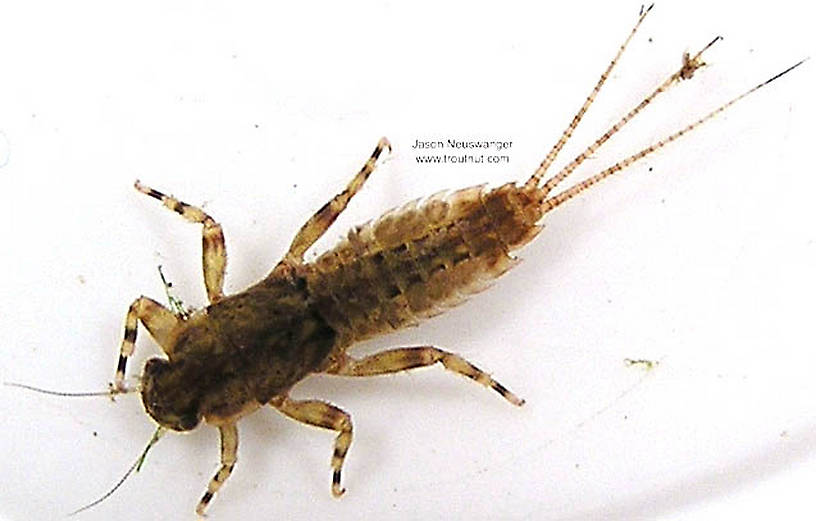
This specimen seems to be morphologically identical to the darker specimens of its species, but it's a very distinctly different color. I'm guessing this is a gender difference, just as I've guessed for the similar E. subvaria nymphs.
Added by Troutnut on January 25, 2006
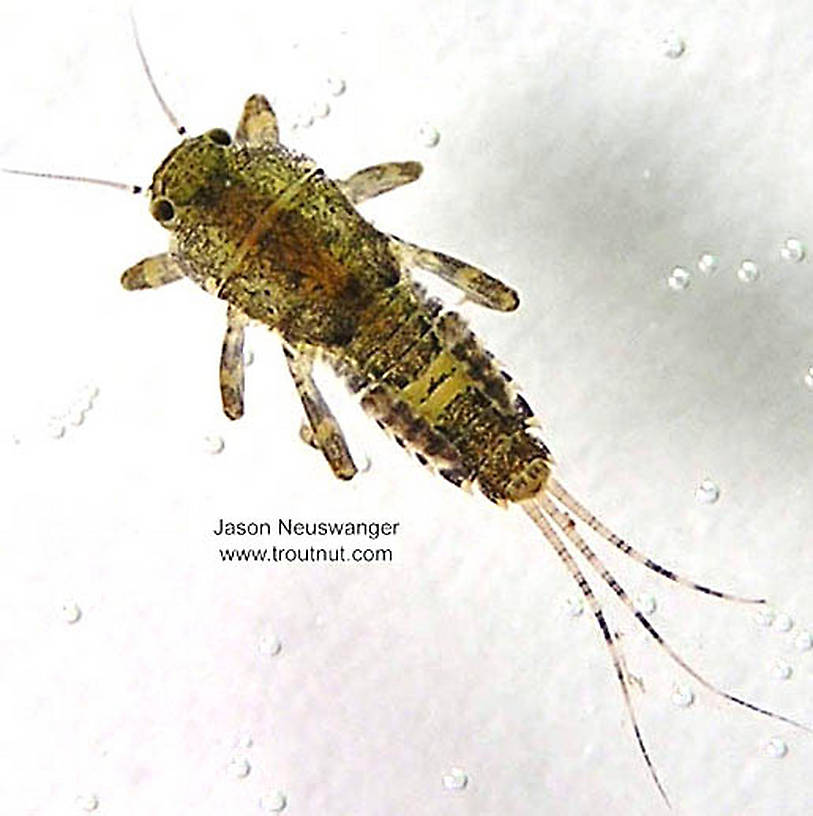
Added by Troutnut on January 25, 2006
Collected January 12, 2004 from the Namekagon River in Wisconsin
and added by Troutnut on January 25, 2006
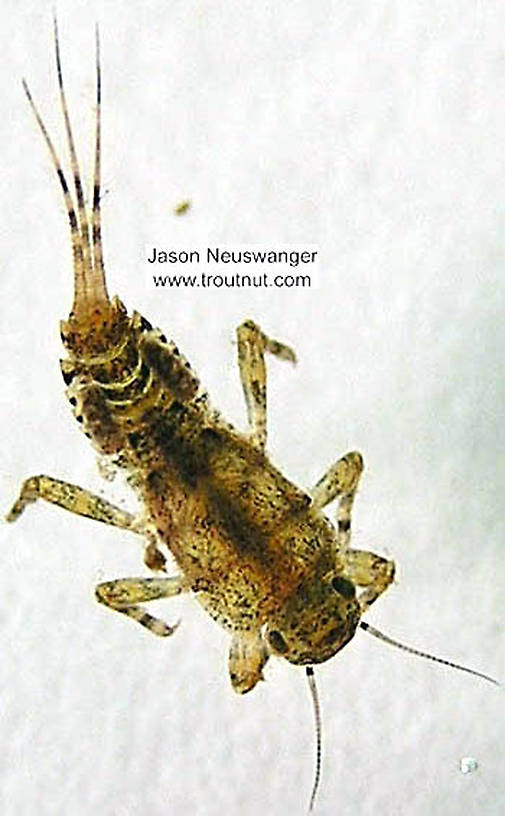
Added by Troutnut on January 25, 2006
Collected January 12, 2004 from the Namekagon River in Wisconsin
and added by Troutnut on January 25, 2006
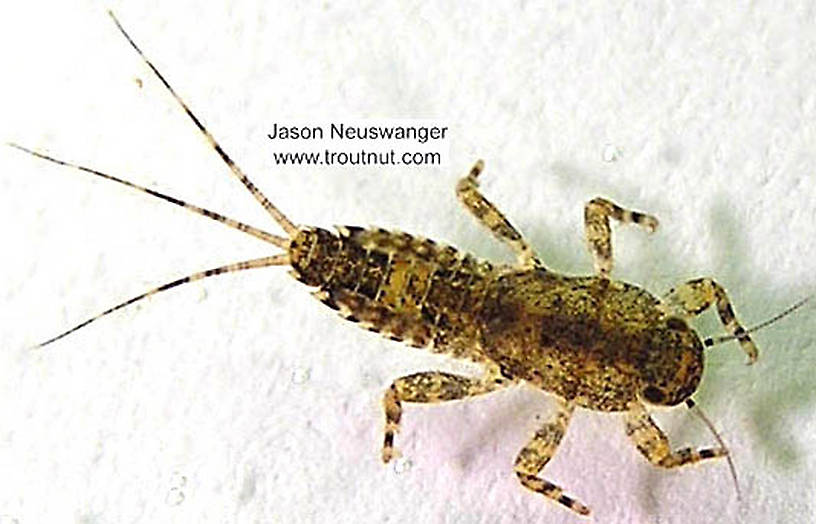
Added by Troutnut on January 25, 2006
Collected January 12, 2004 from the Namekagon River in Wisconsin
and added by Troutnut on January 25, 2006
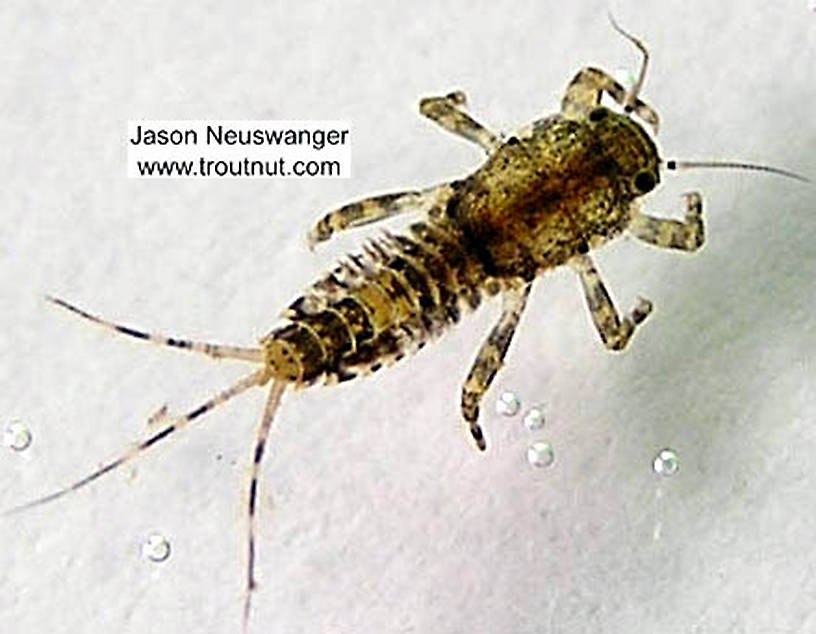
Added by Troutnut on January 25, 2006
Collected January 12, 2004 from the Namekagon River in Wisconsin
and added by Troutnut on January 25, 2006
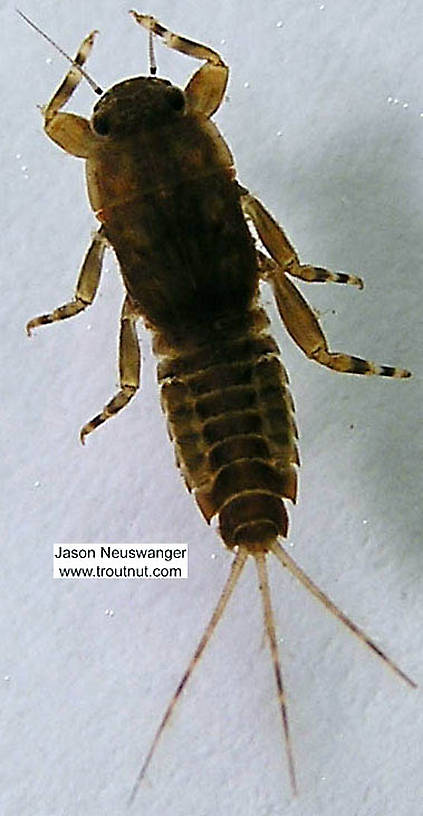
Morphologically this one looks a lot like subvaria but the color is really different.
Added by Troutnut on January 25, 2006
Collected January 12, 2004 from the Namekagon River in Wisconsin
and added by Troutnut on January 25, 2006
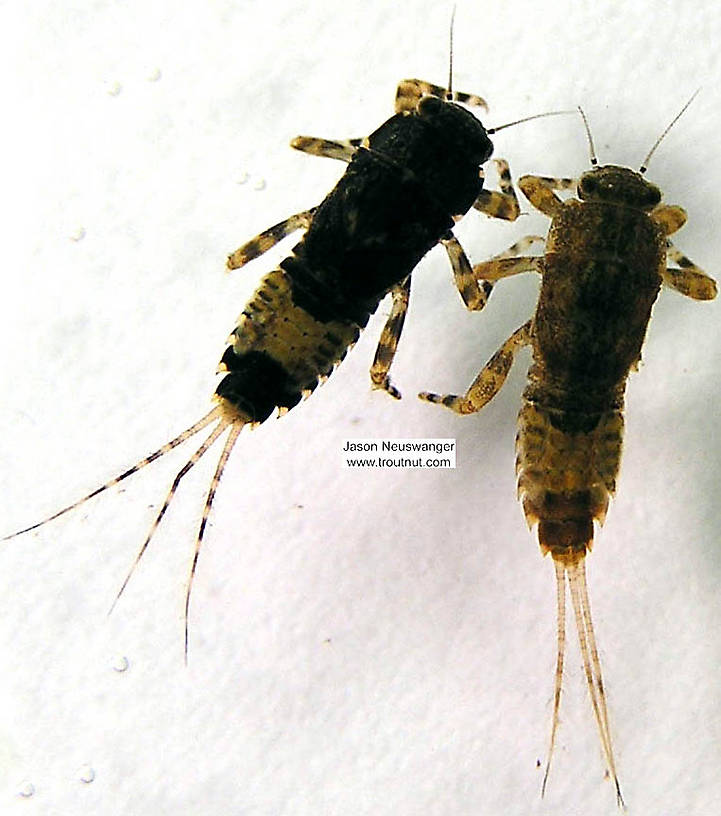
These are two common color patterns on Hendrickson nymphs. I suspect that one is male and the other female, but I don't know for sure.
Added by Troutnut on January 25, 2006
Collected January 12, 2004 from the Namekagon River in Wisconsin
and added by Troutnut on January 25, 2006
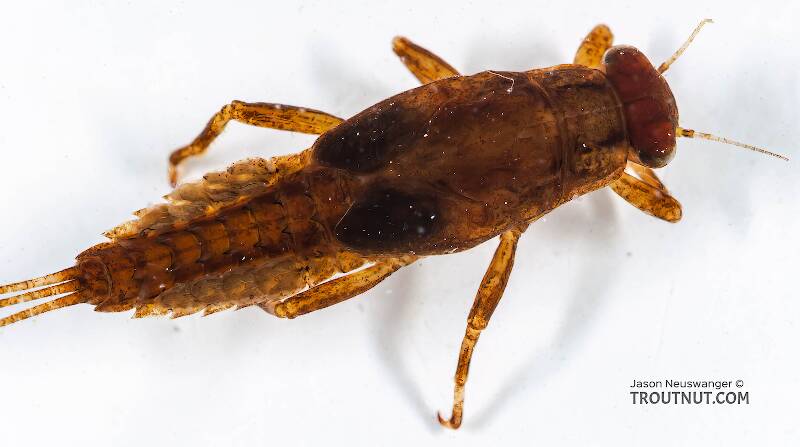
I photographed three strange striped Ephemerella nymphs from the same trip on the same river: a black and olive one, this one, and a very very striped one. I have tentatively put them all in Ephemerella needhami for now.
Added by Troutnut on May 26, 2006
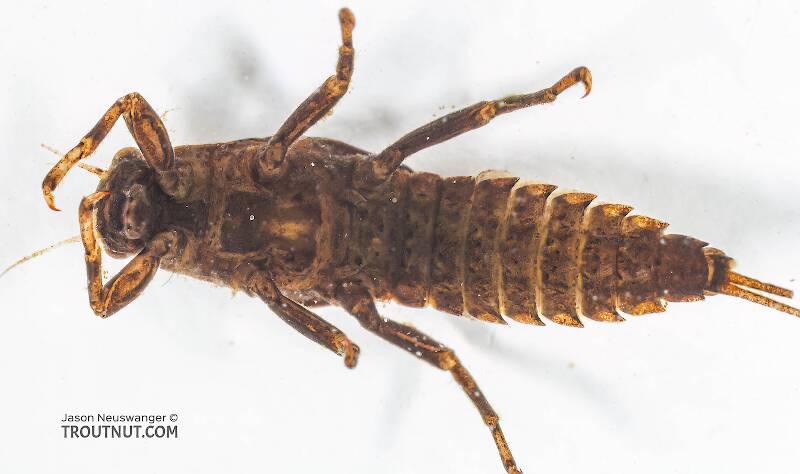
I found this specimen in the same collection as a similar one. Since I only have strange views of this one, it's possible that they're actually the same specimen and I somehow confused my picture-ordering and got the impression that they're different nymphs.
Added by Troutnut on May 26, 2006
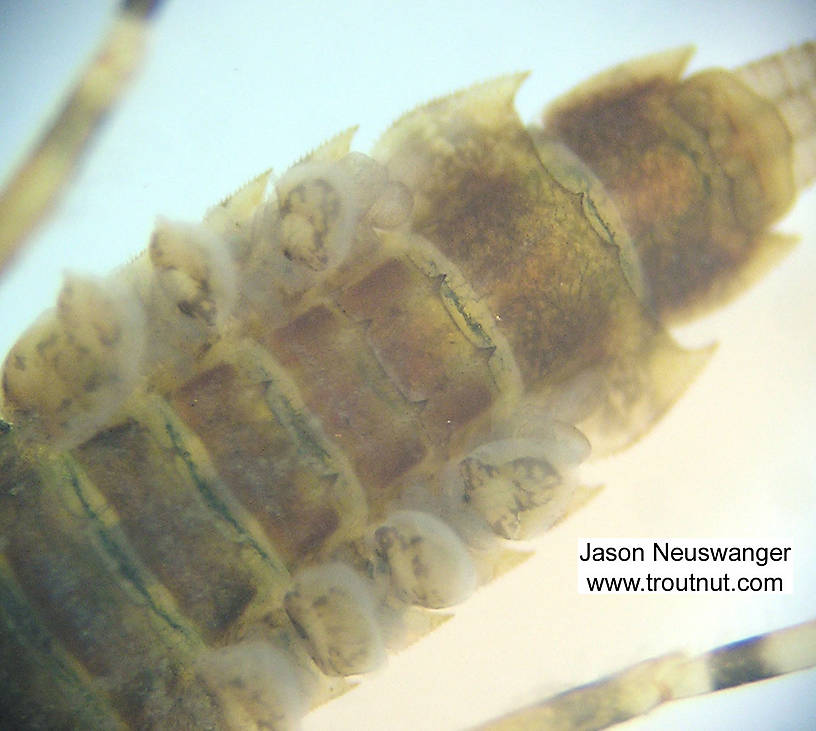
I only took two partial pictures of this specimen to test out one of my microscopes.
Added by Troutnut on April 12, 2006
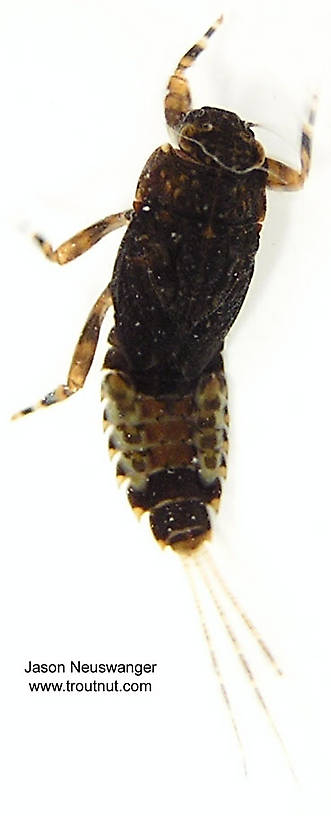
Here's another of the nymphs I collected behaving strangely, as described for this specimen.
Added by Troutnut on January 25, 2006
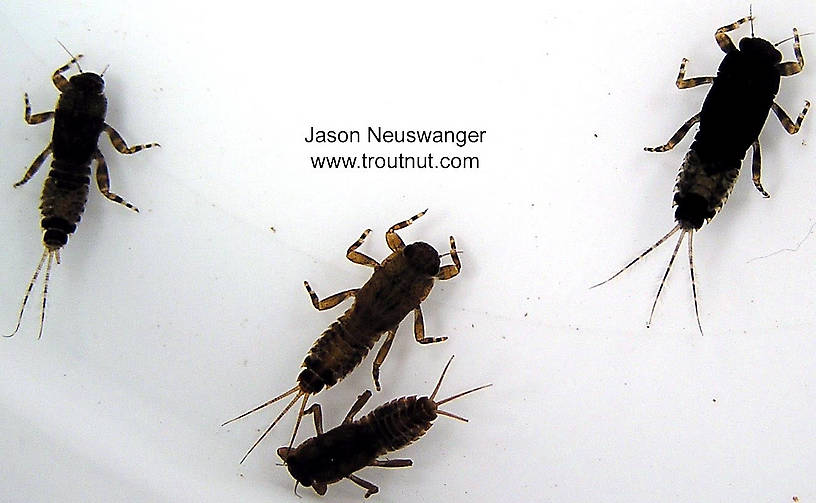
Here are the 4 main color variations I've found that I'm considering to be E. subvaria.
Added by Troutnut on January 25, 2006
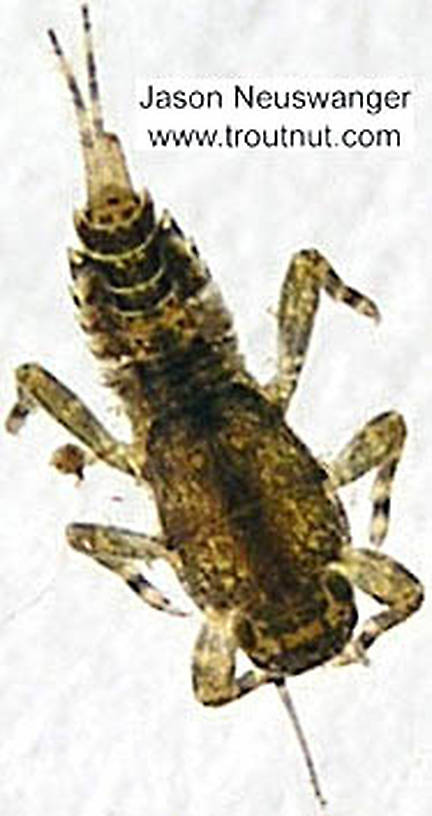
Added by Troutnut on January 25, 2006
Collected January 12, 2004 from the Namekagon River in Wisconsin
and added by Troutnut on January 25, 2006
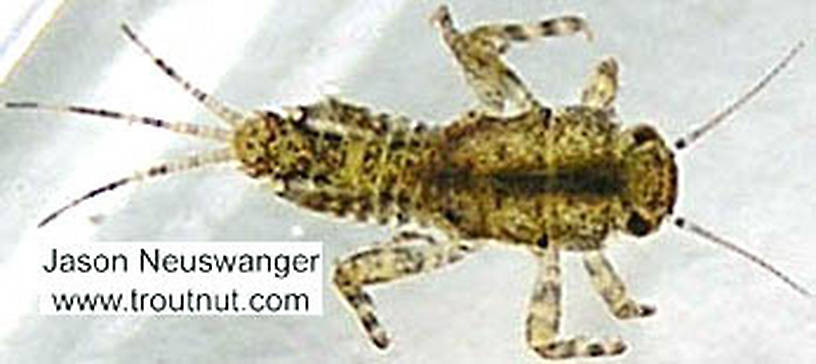
Added by Troutnut on January 25, 2006
Collected January 12, 2004 from the Namekagon River in Wisconsin
and added by Troutnut on January 25, 2006
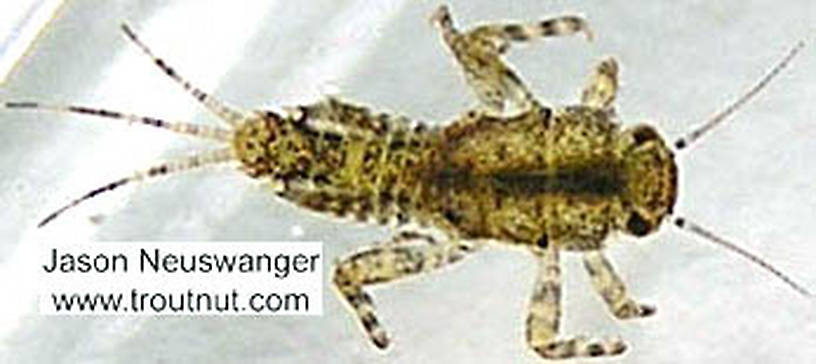
Added by Troutnut on January 25, 2006
Collected January 12, 2004 from the Namekagon River in Wisconsin
and added by Troutnut on January 25, 2006
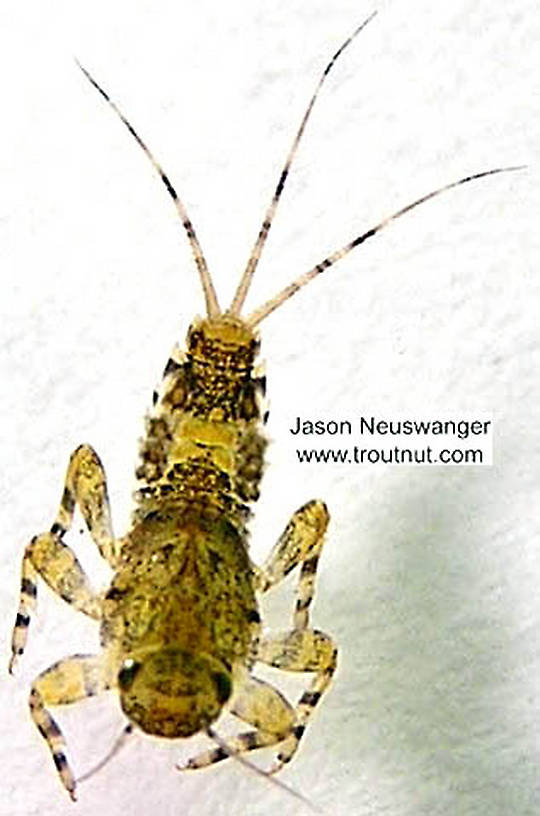
Added by Troutnut on January 25, 2006
Collected January 12, 2004 from the Namekagon River in Wisconsin
and added by Troutnut on January 25, 2006
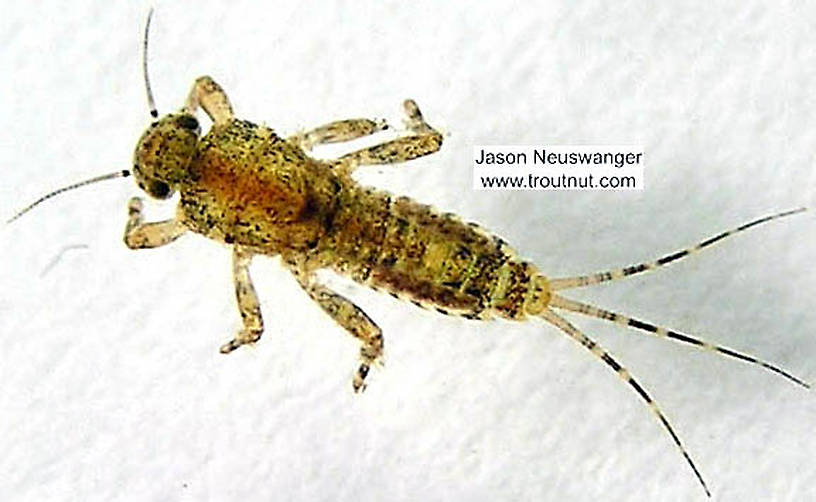
Added by Troutnut on January 25, 2006
Collected January 12, 2004 from the Namekagon River in Wisconsin
and added by Troutnut on January 25, 2006
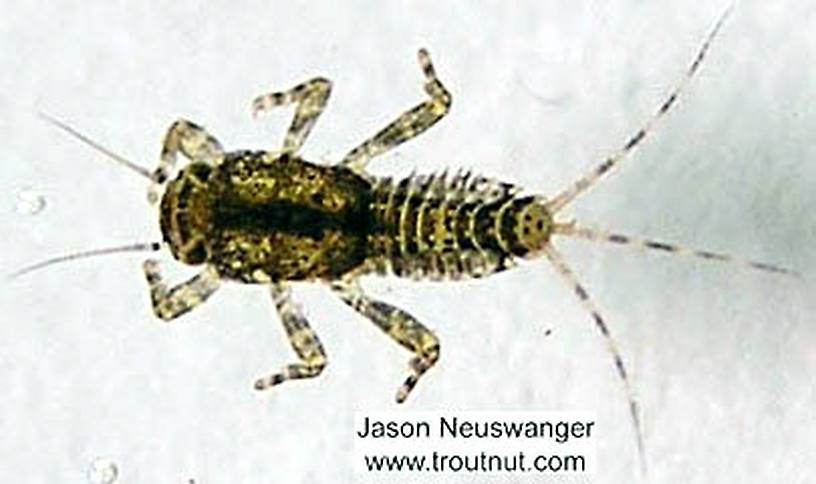
Added by Troutnut on January 25, 2006
Collected January 12, 2004 from the Namekagon River in Wisconsin
and added by Troutnut on January 25, 2006
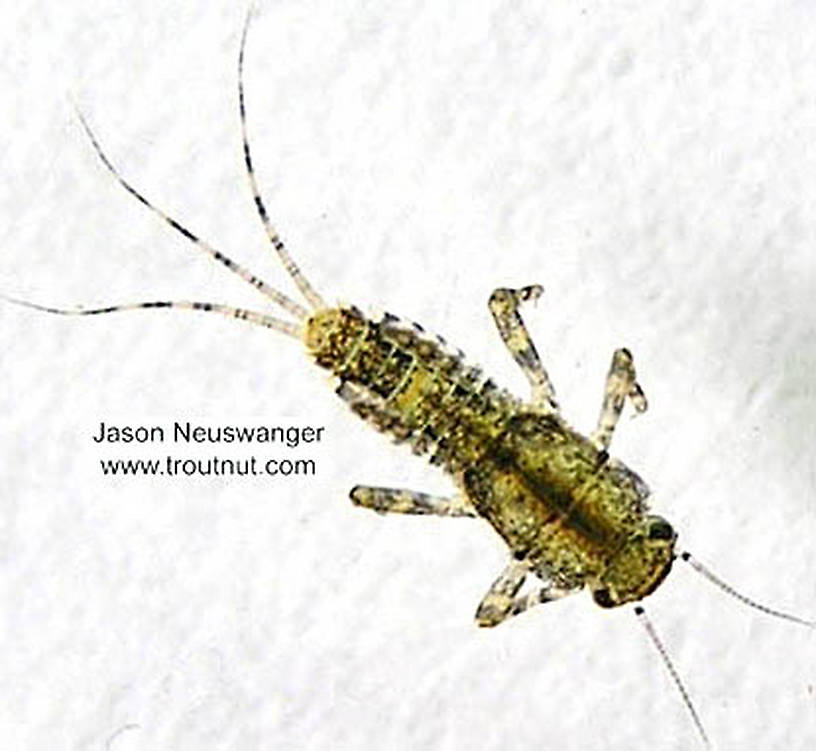
Added by Troutnut on January 25, 2006
Collected January 12, 2004 from the Namekagon River in Wisconsin
and added by Troutnut on January 25, 2006
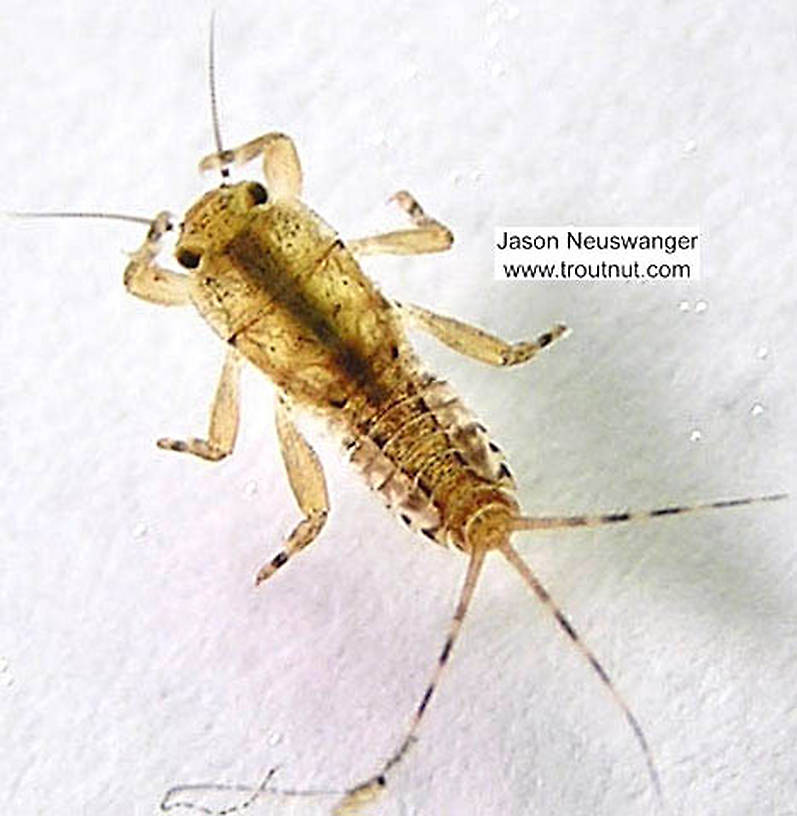
Added by Troutnut on January 25, 2006
Collected January 12, 2004 from the Namekagon River in Wisconsin
and added by Troutnut on January 25, 2006
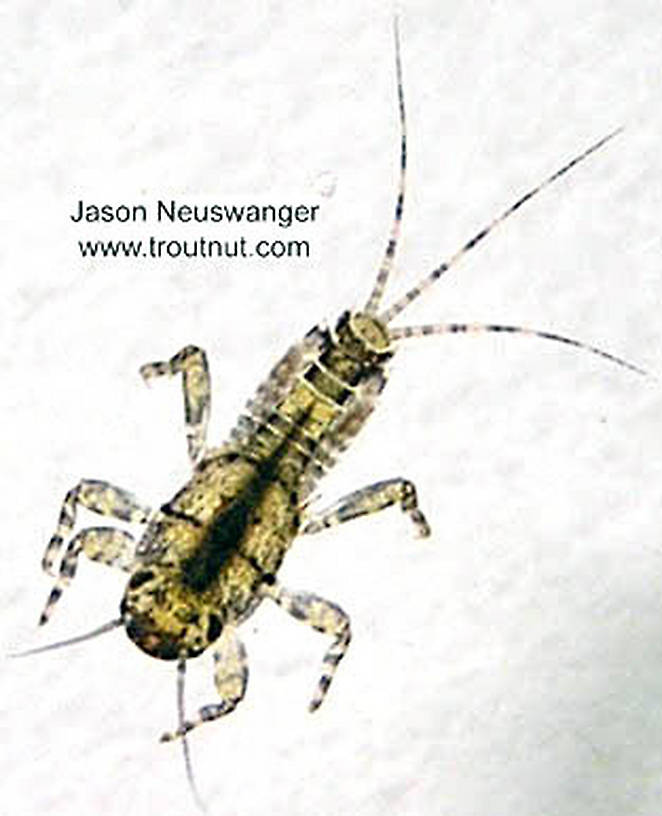
Added by Troutnut on January 25, 2006
Collected January 12, 2004 from the Namekagon River in Wisconsin
and added by Troutnut on January 25, 2006
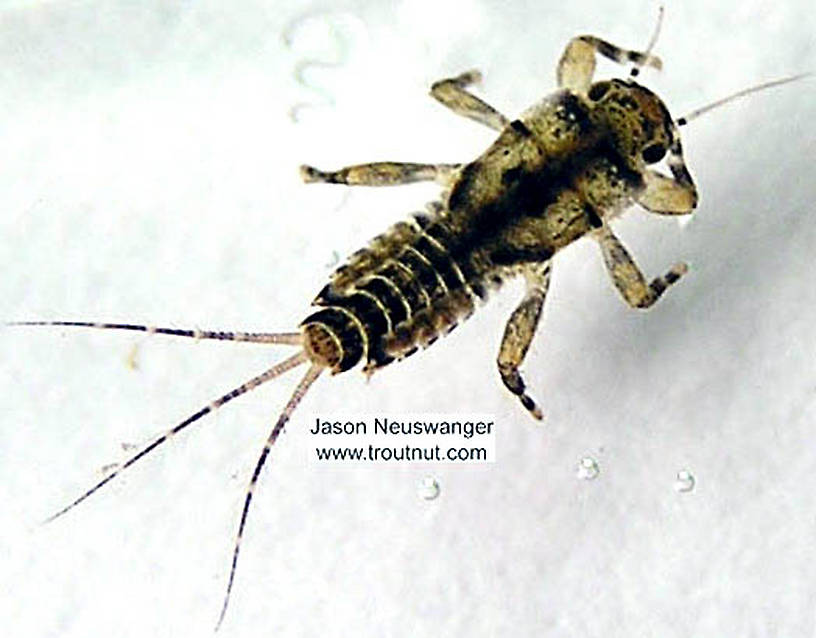
Added by Troutnut on January 25, 2006
Collected January 12, 2004 from the Namekagon River in Wisconsin
and added by Troutnut on January 25, 2006
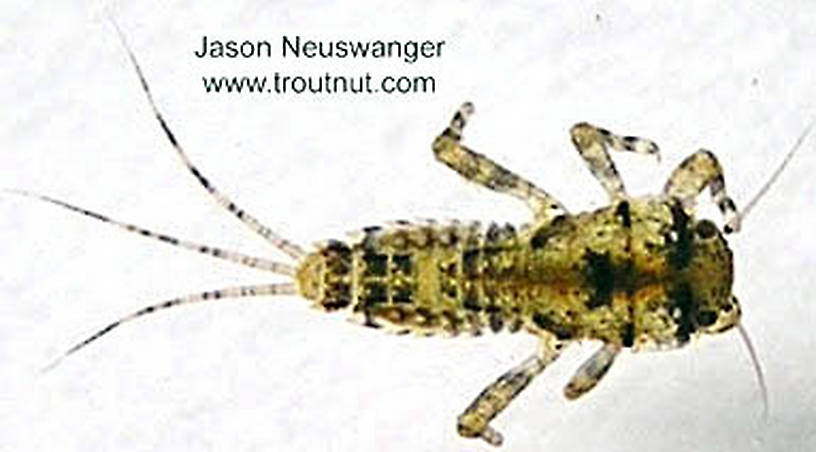
Added by Troutnut on January 25, 2006
Collected January 12, 2004 from the Namekagon River in Wisconsin
and added by Troutnut on January 25, 2006
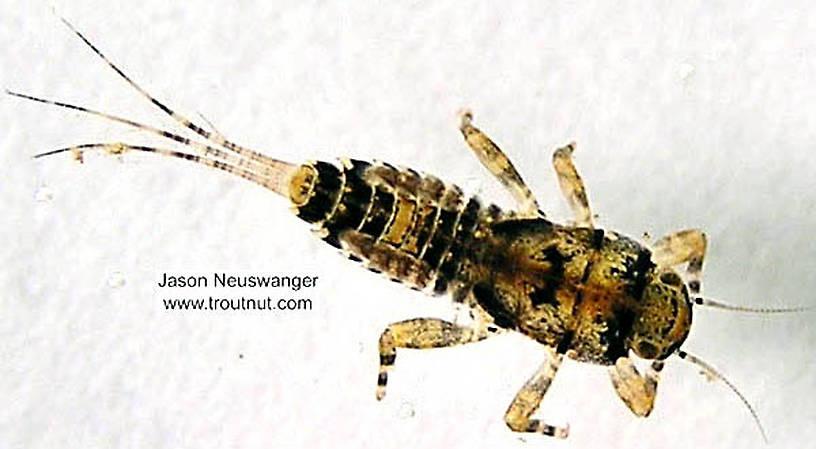
Added by Troutnut on January 25, 2006
Collected January 12, 2004 from the Namekagon River in Wisconsin
and added by Troutnut on January 25, 2006
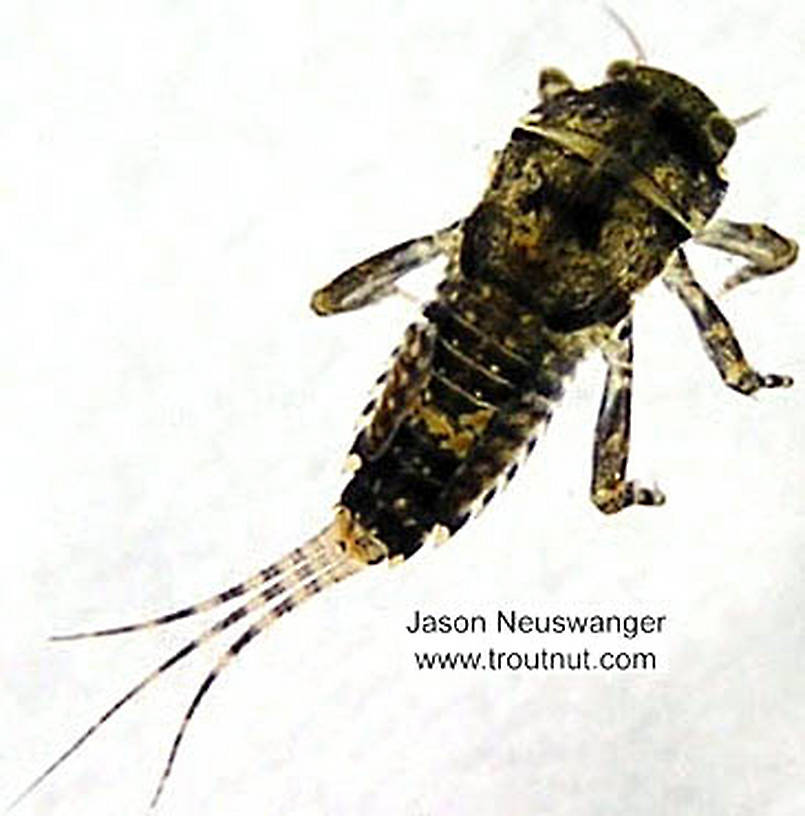
Added by Troutnut on January 25, 2006
Collected January 12, 2004 from the Namekagon River in Wisconsin
and added by Troutnut on January 25, 2006
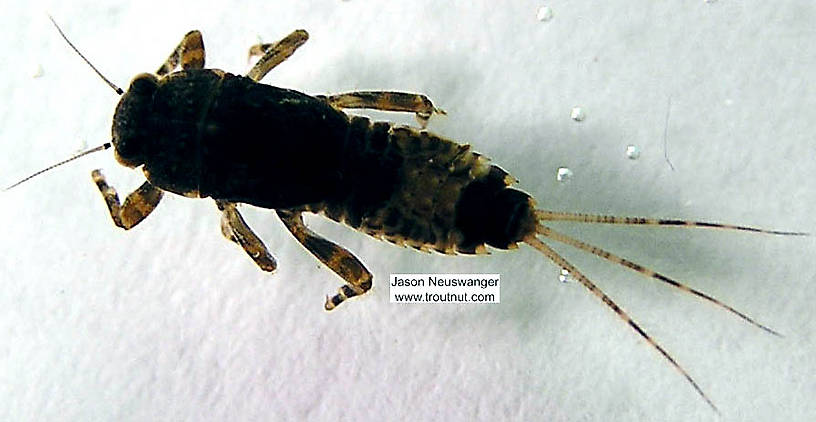
Added by Troutnut on January 25, 2006
Collected January 12, 2004 from the Namekagon River in Wisconsin
and added by Troutnut on January 25, 2006
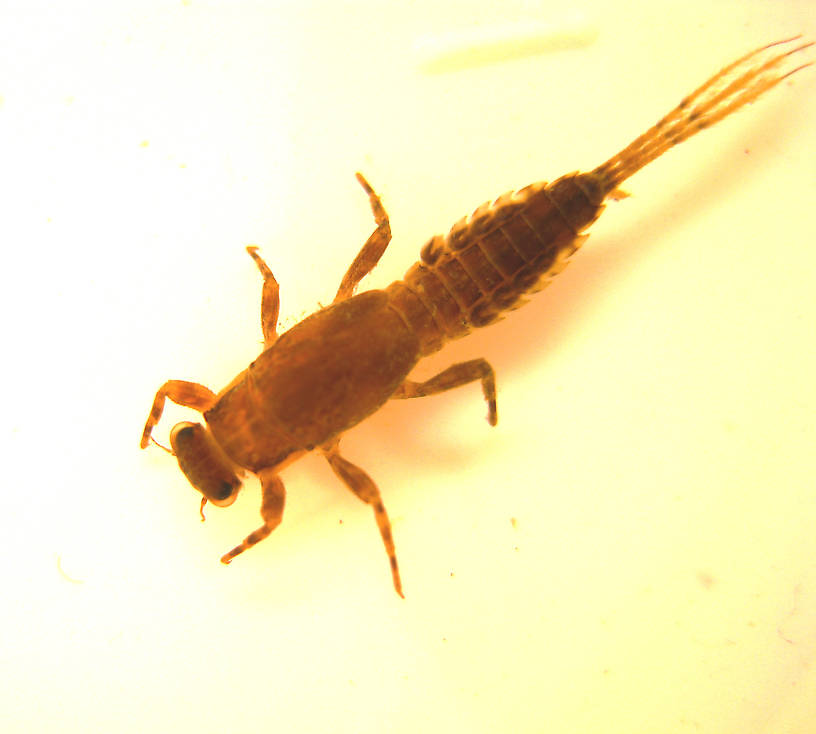
Habitat: Shallow riffle over cobble; approx. 1 ft. deep
Size: 8.5 mm. Mature specimens have been captured as large as 10.5 mm.
Emergence schedule: Variable - starting as early as mid March and lasting as late as early June, depending on the year. Usual duration is at least several weeks or more.
Dun Association: Body is elusive pale creamy yellow w/ orange highlights, cream legs and tails, and dun wings
Specimen status in photo: Preserved
Collection method: Kick net
Comments: Extremely common in samples taken from this location. It's color in life was very close to as depicted in the photo; except for the gradual darkening of the abdominal segments as they progress posteriorly, which has been accentuated somewhat by the effects of preservation. Adult association is based upon capture of this taxon at various stages of emergence including: darkened wingcases, split thoraxic notums, and partially ecloded or ''stillborn'' specimens.
Entoman
Size: 8.5 mm. Mature specimens have been captured as large as 10.5 mm.
Emergence schedule: Variable - starting as early as mid March and lasting as late as early June, depending on the year. Usual duration is at least several weeks or more.
Dun Association: Body is elusive pale creamy yellow w/ orange highlights, cream legs and tails, and dun wings
Specimen status in photo: Preserved
Collection method: Kick net
Comments: Extremely common in samples taken from this location. It's color in life was very close to as depicted in the photo; except for the gradual darkening of the abdominal segments as they progress posteriorly, which has been accentuated somewhat by the effects of preservation. Adult association is based upon capture of this taxon at various stages of emergence including: darkened wingcases, split thoraxic notums, and partially ecloded or ''stillborn'' specimens.
Entoman
Added by Entoman on October 31, 2011
Collected March 20, 2011 from the Lower Yuba River in California
and added by Entoman on October 31, 2011
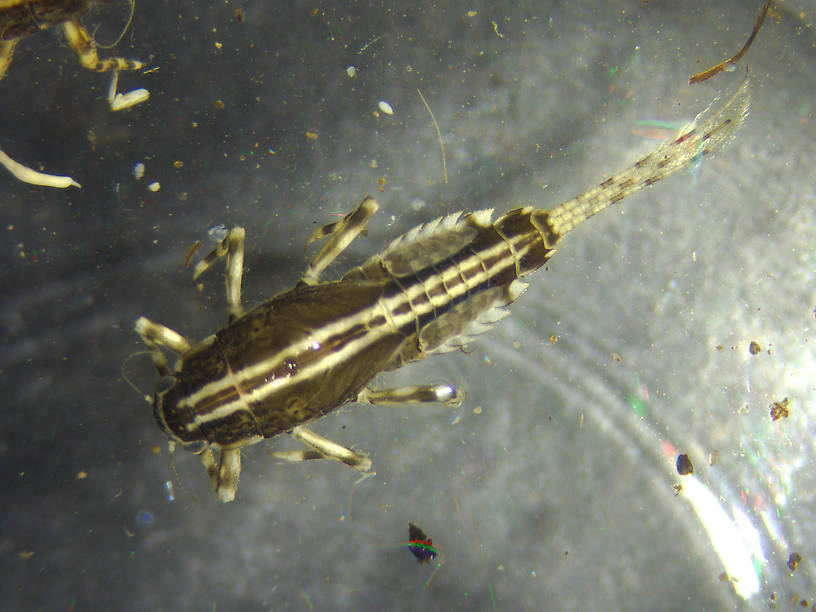
I have collected this species in Montana but it is very common in Alaska streams.
Added by Bnewell on June 26, 2011
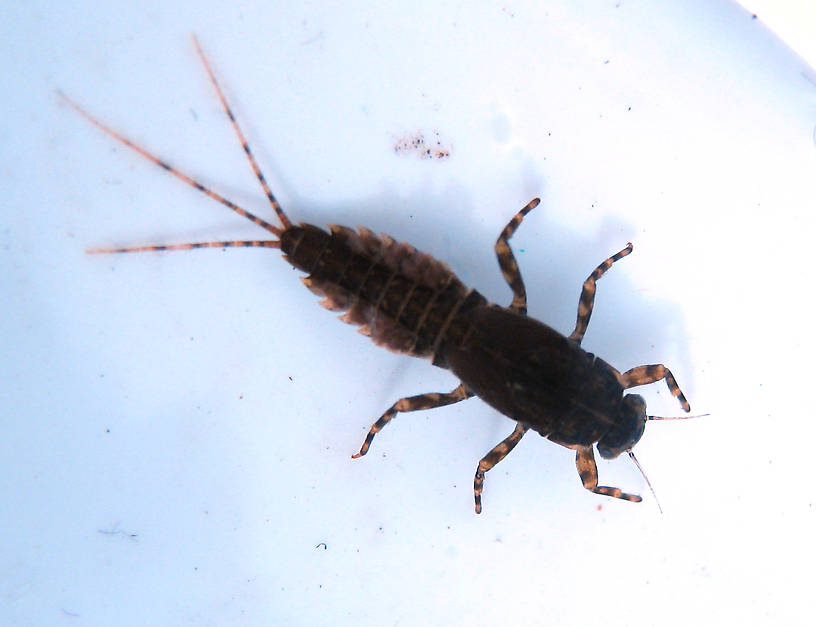
This mature nymph is associated with the dun from the same location and date posted on this hatch page. Size 10mm.
Added by Entoman on December 15, 2011
Collected November 11, 2011 from the Fall River in California
and added by Entoman on December 15, 2011
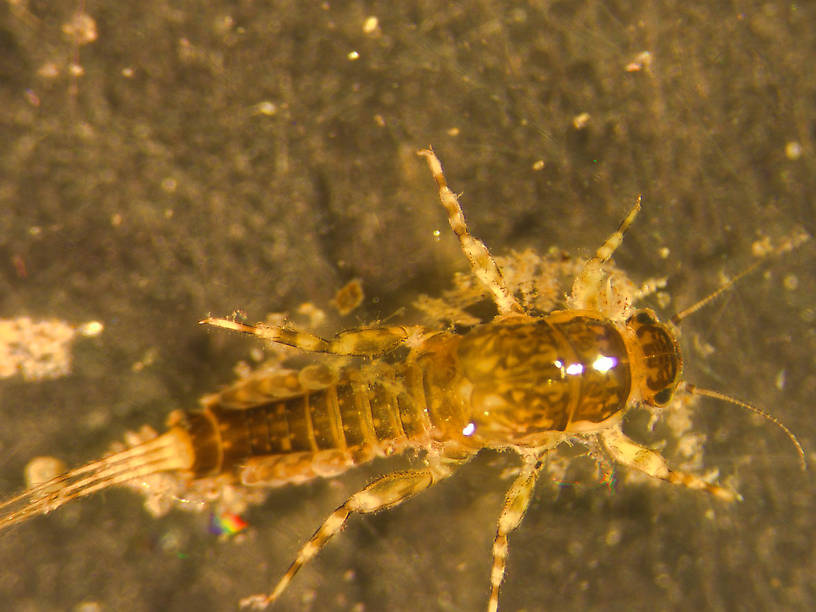
Ephemerella is a very common genus of mayfly in Montana but nymphs are difficult to identify to species.
Added by Bnewell on June 26, 2011
7 Streamside Pictures of Ephemerella Mayflies:
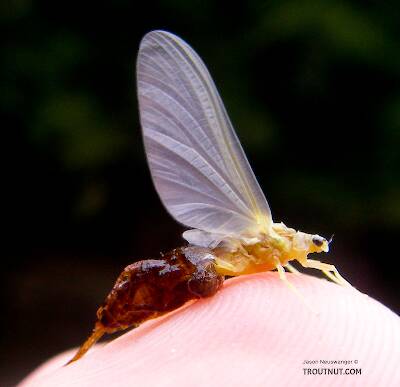
This Ephemerella invaria sulphur dun got stuck in its shuck trying to emerge. This isn't exactly a "natural" pose for a photograph, but it kind of shows what an emerger pattern could look like.
In this picture: Mayfly Species Ephemerella invaria (Sulphur).
Added by Troutnut on June 5, 2007
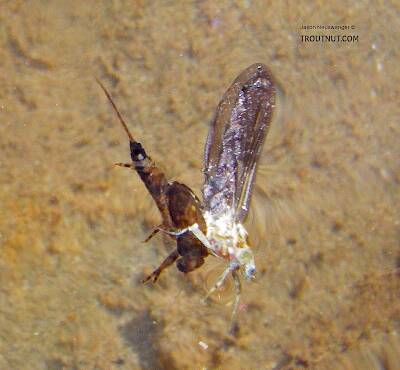
Here's an above-the-water view of a stillborn Ephemerella subvaria dun which I also photographed from below the water.
In this picture: Mayfly Species Ephemerella subvaria (Hendrickson).
Added by Troutnut on April 22, 2006
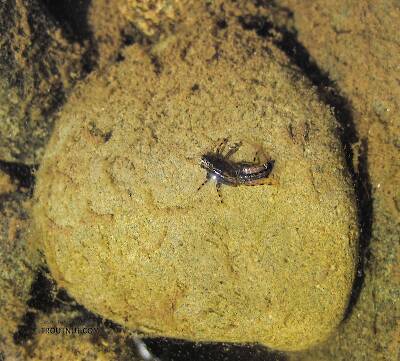
Shed exoskeleton from what was very likely an Ephemerella aurivillii nymph that emerged on this rock.
In this picture: Mayfly Species Ephemerella aurivillii.
Added by Troutnut on July 14, 2012
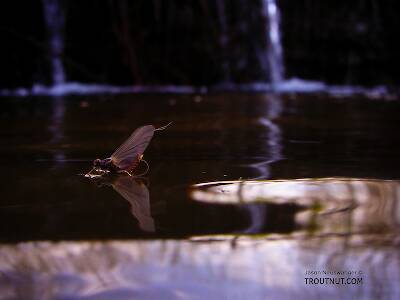
In this picture: Mayfly Species Ephemerella subvaria (Hendrickson).
Added by Troutnut on May 3, 2007
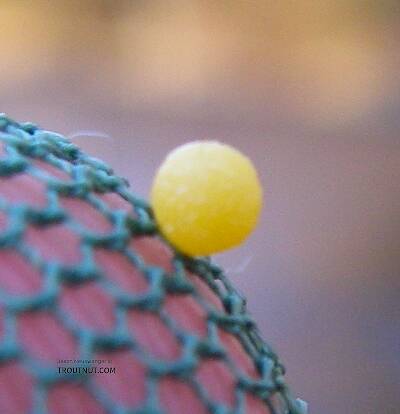
Here's a fresh ball of eggs from a Hendrickson spinner, photographed to show the proper color for the egg-ball on spinner patterns.
In this picture: Mayfly Species Ephemerella subvaria (Hendrickson).
Added by Troutnut on June 5, 2007
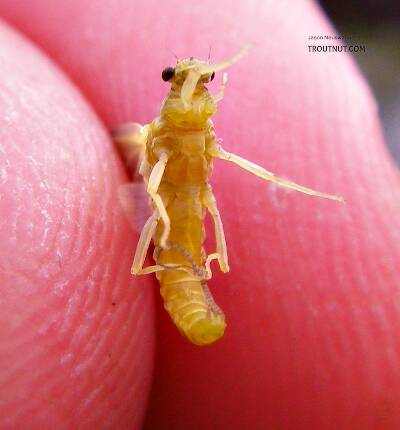
The underside of a freshly emerged Ephemerella invaria dun.
In this picture: Mayfly Species Ephemerella invaria (Sulphur).
Added by Troutnut on June 5, 2007
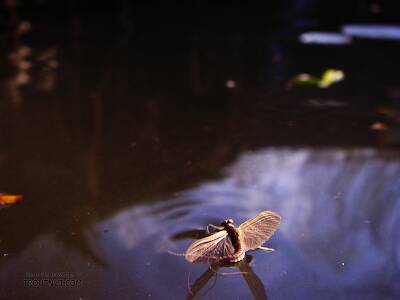
In this picture: Mayfly Species Ephemerella subvaria (Hendrickson).
Added by Troutnut on May 3, 2007
18 Underwater Pictures of Ephemerella Mayflies:
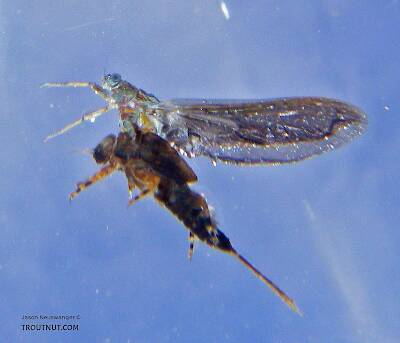
This is a close-up underwater view of a stillborn Ephemerella subvaria (Henrickson) female dun.
In this picture: Mayfly Species Ephemerella subvaria (Hendrickson).
Added by Troutnut on April 22, 2006
Taken April 18, 2006 from the East Branch of the Delaware River in New York and added by Troutnut on April 22, 2006
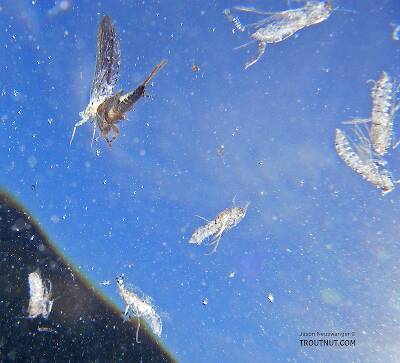
This picture from below shows a stillborn Ephemerella subvaria (Hendrickson) dun drifting on the surface amidst a number of shed pupal skins from Brachycentrus caddisflies which were heavily hatching that day.
Added by Troutnut on April 22, 2006
Taken April 18, 2006 from the East Branch of the Delaware River in New York and added by Troutnut on April 22, 2006
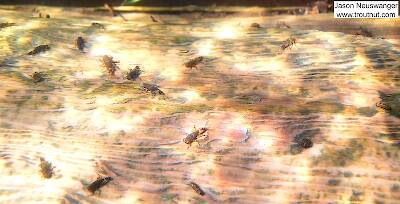
Taken April 22, 2004
Added by Troutnut on January 25, 2006
Taken April 22, 2004 and added by Troutnut on January 25, 2006
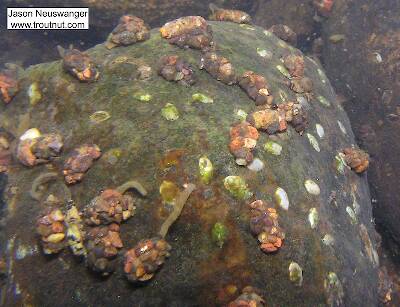
The white blotches on this rock are Leucotrichia caddisfly cases, and the wispy tubes are cases made by a type of midge.
Taken March 23, 2004
Added by Troutnut on January 25, 2006
Taken March 23, 2004 and added by Troutnut on January 25, 2006
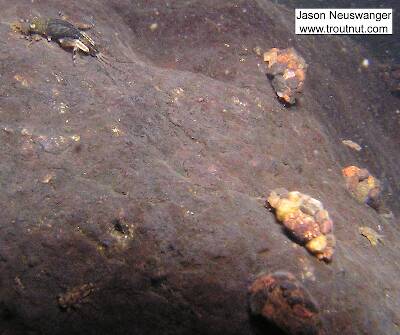
There's a large Ephemerella subvaria nymph in the top left.
Taken March 19, 2004
Added by Troutnut on January 25, 2006
Taken March 19, 2004 and added by Troutnut on January 25, 2006

In this picture: Mayfly Species Ephemerella invaria (Sulphur).
Taken March 23, 2004
Added by Troutnut on January 25, 2006
Taken March 23, 2004 and added by Troutnut on January 25, 2006
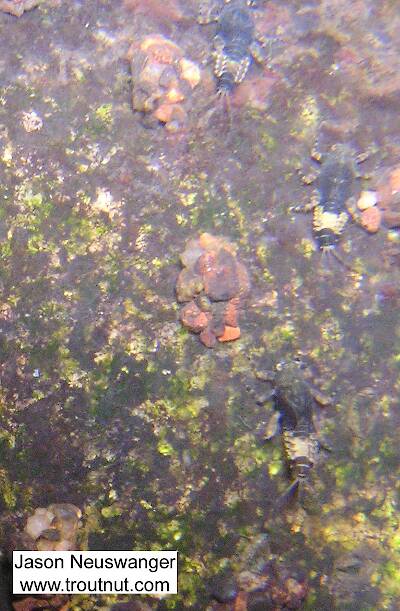
Three big Ephemerella subvaria mayfly nymphs share a rock with some cased caddis larvae.
Taken March 19, 2004
Added by Troutnut on January 25, 2006
Taken March 19, 2004 and added by Troutnut on January 25, 2006
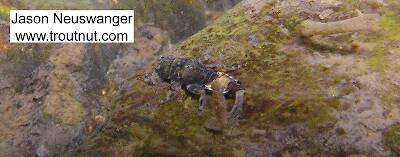
This Ephemerella subvaria (Hendrickson) nymph picture is one of my favorites.
In this picture: Mayfly Species Ephemerella subvaria (Hendrickson).
Taken March 23, 2004
Added by Troutnut on January 25, 2006
Taken March 23, 2004 and added by Troutnut on January 25, 2006
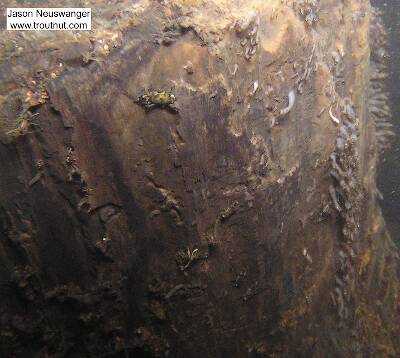
Some large Ephemerella mayfly nymphs cling to a log. In the background, hundreds of Simuliidae black fly larvae swing in large clusters in the current.
Taken March 19, 2004
Added by Troutnut on January 25, 2006
Taken March 19, 2004 and added by Troutnut on January 25, 2006
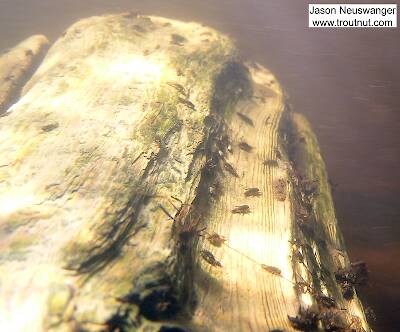
Taken April 22, 2004
Added by Troutnut on January 25, 2006
Taken April 22, 2004 and added by Troutnut on January 25, 2006
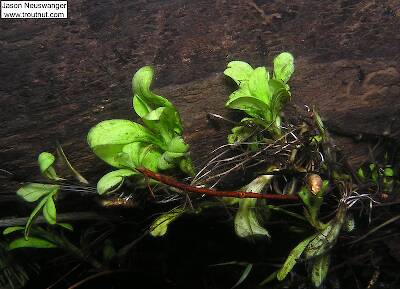
Several well-camouflaged Ephemerella mayfly nymphs cling to this log, and a few cased caddisfly larvae cling to the plant in front of it.
In this picture: Insect Order Trichoptera (Caddisfly) and Mayfly Genus Ephemerella (Hendricksons, Sulphurs, PMDs).
Taken April 12, 2004
Added by Troutnut on January 25, 2006
Taken April 12, 2004 and added by Troutnut on January 25, 2006
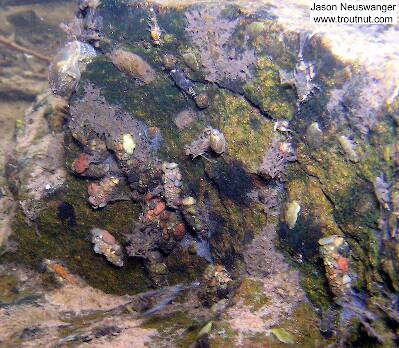
Taken April 12, 2004
Added by Troutnut on January 25, 2006
Taken April 12, 2004 and added by Troutnut on January 25, 2006
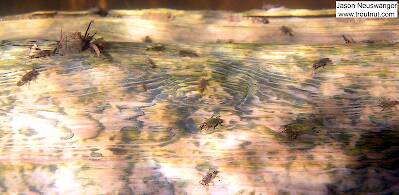
In this picture: Mayfly Species Ephemerella subvaria (Hendrickson).
Taken April 22, 2004
Added by Troutnut on January 25, 2006
Taken April 22, 2004 and added by Troutnut on January 25, 2006
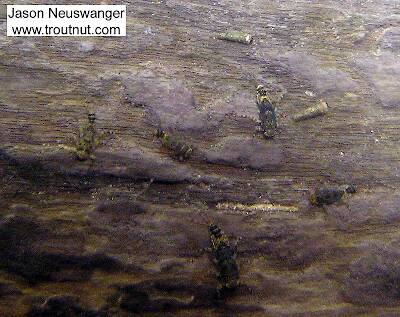
Taken April 17, 2004
Added by Troutnut on January 25, 2006
Taken April 17, 2004 and added by Troutnut on January 25, 2006
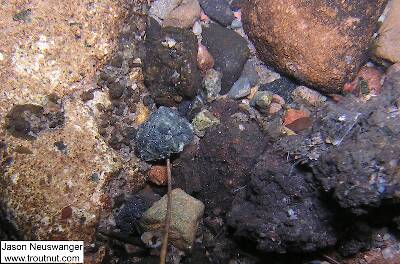
In this picture: Mayfly Genus Ephemerella (Hendricksons, Sulphurs, PMDs).
Taken April 12, 2004
Added by Troutnut on January 25, 2006
Taken April 12, 2004 and added by Troutnut on January 25, 2006
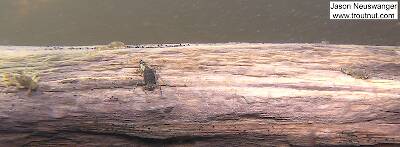
In this picture: Mayfly Species Ephemerella subvaria (Hendrickson).
Taken April 22, 2004
Added by Troutnut on January 25, 2006
Taken April 22, 2004 and added by Troutnut on January 25, 2006
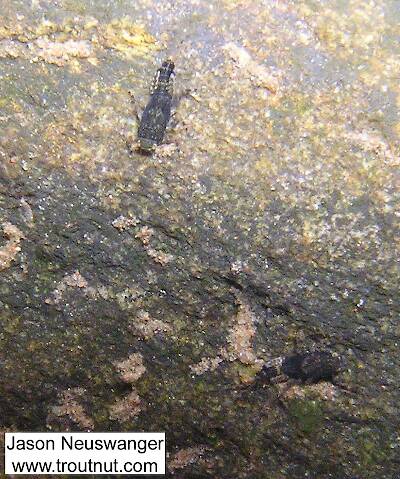
In this picture: Mayfly Species Ephemerella subvaria (Hendrickson).
Taken April 23, 2004
Added by Troutnut on January 25, 2006
Taken April 23, 2004 and added by Troutnut on January 25, 2006
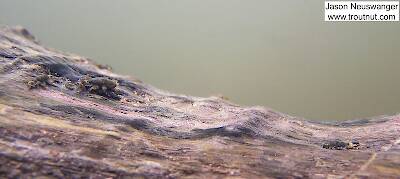
In this picture: Mayfly Species Ephemerella subvaria (Hendrickson).
Taken April 17, 2004
Added by Troutnut on January 25, 2006
Taken April 17, 2004 and added by Troutnut on January 25, 2006
Discussions of Ephemerella
PMD Spinner - Egg sack color?
20 replies
Posted by Wbranch on Jan 26, 2010 in the species Ephemerella excrucians
Last reply on Aug 18, 2020 by Troutnut
Do any of you entomologist types know the true color of the PMD spinner? Dorothea or excrucians. Where I fish in MT there are huge spinner falls, many spents are on the water in the morning and others fall again at various periods during the day. I'd like to tie some with egg sacks as I saw many in July but forgot what color they were. Thanks.
rotunda
8 replies
Posted by CharlieBugs on Jan 25, 2015 in the species Ephemerella invaria
Last reply on Feb 1, 2015 by Gutcutter
Your post on Ephemerella subvaria brought back some memories that might be of interest to some readers.
I got my master’s degree under Ed Cooper at Penn State in 1966. I studied the impact of low oxygen from Penn State’s sewage plant on the mayflies of Spring Creek. The plant mostly removed BOD (organic matter which causes low oxygen) by oxidizing it in a bacteria rich environment. But at that time the plant did not remove phosphorus (and nitrogen) which fertilized the macrophytic algae and other plant growth. There were far more macrophytes (large plants) in Spring Creek below the sewage plant entrance than above, and essentially no mayflies. What was there in the effluent that killed the mayflies? Mayflies put directly in the effluent did not die over a 16 hour day. But oxygen samples taken over 24 hours in summer showed a much greater variation below the effluent (from 16 ppm (or mg/l), 160% of saturation in late afternoon) to 3 ppm (30 percent saturation just before dawn) (vs 14 to 10 ppm, +- 20 percent saturation above the effluent.
I built a Rube Goldberg machine in the lab that would control the oxygen levels and temperature of control and experimental cages that each held 25 mayflies. The control would keep oxygen near saturation and the experimental one would lower the oxygen over 8 hours (the length of night in summer). Mortality was dependent upon both oxygen level and temperature. Virtually no mayflies would die if the oxygen was above 2 PPM (or mg/l) at 8 C, or at 4.5 at 20 C. Seventy five percent of larvae would die at 1 ppm at 8 degrees and 2.5 ppm at 20 degrees. So the mortality was much more if the temperatures were high. Hence most of the mortality would presumably occur in August when the high temperatures (20C) would increase the larvae metabolism and hence need for oxygen, but the water would hold less oxygen even before the night-time respiration of the macrophytes would reduce it much further (to only 3 ppm). Thus the low nighttime oxygen caused by excessive plant growth was a sufficient cause or the near total absence of mayflies below the sewage plant. Recognizing the aquatic impact Penn State started to use land disposal of its effluent which as far as I knew alleviated, and even stopped, the negative impacts on the mayflies. Can anyone verify this ? The otherwise well done “The Fishery of Spring Creek; A Watershed Under Siege “
By Robert F. Carline, Rebecca L. Dunlap Jason E. Detar, Bruce A. Hollender Has nothing on dissolved oxygen or aquatic insects. In my opinion we need much more of an ecosystems approach for streams (Which we are doing for Little Sandy Creek in N.Y.).
Now back to Ephemeralla subvaria. The title of the paper I published on this project (my first of nearly 300 publications) was:
1. Hall, C.A.S. 1969. Mortality of the mayfly nymph, Ephemerella rotunda, at low dissolved oxygen concentrations. J. Elisha Mitchell Sci. Soc. 85(1): 34-39 (M.S. Thesis, Pennsylvania State University, 1966).
Whoa! Ephemeralla rotunda? This was by far the most abundant mayfly in Spring Creek where I sampled! But I could not even find the name in your list. Also I had my samples verified by Burke, author of the authoritative "Mayflies of Illinois", and he said Well that’s what it keyed out to in my book”. (Talk about scientific ass covering! ) Well to make matters worse (as of 24 hours ago) my next girlfriend, Molly, at the University of North Carolina, loved the name of “Ephemerella rotunda”, the rotund one, which comes to think of it described her as well. I liked it too. But n’exist plus: where had the most abundant mayfly gone? Fortunately upon reading the rest of the post I found “Ephemerella invaria is one of the two species frequently known as Sulphurs (the other is Ephemerella dorothea). There used to be a third, Ephemerella rotunda, but entomologists recently discovered that invaria and rotunda are a single species with an incredible range of individual variation." Ahh neither rotunda nor Molly stood the test of time. So I assume what I called rotunda is still alive and well in Spring Creek as invaria. Again, can anyone verify that?
If anyone wants to follow up on the distribution and abundance of mayfly (or any other species) may I recommend: Hall, C.A.S., J.A. Stanford and R. Hauer. 1992. The distribution and abundance of organisms as a consequence of energy balances along multiple environmental gradients. Oikos 65: 377-390. I can send it if you cannot get it from google, which I think you can. (chall@esf.edu)
I got my master’s degree under Ed Cooper at Penn State in 1966. I studied the impact of low oxygen from Penn State’s sewage plant on the mayflies of Spring Creek. The plant mostly removed BOD (organic matter which causes low oxygen) by oxidizing it in a bacteria rich environment. But at that time the plant did not remove phosphorus (and nitrogen) which fertilized the macrophytic algae and other plant growth. There were far more macrophytes (large plants) in Spring Creek below the sewage plant entrance than above, and essentially no mayflies. What was there in the effluent that killed the mayflies? Mayflies put directly in the effluent did not die over a 16 hour day. But oxygen samples taken over 24 hours in summer showed a much greater variation below the effluent (from 16 ppm (or mg/l), 160% of saturation in late afternoon) to 3 ppm (30 percent saturation just before dawn) (vs 14 to 10 ppm, +- 20 percent saturation above the effluent.
I built a Rube Goldberg machine in the lab that would control the oxygen levels and temperature of control and experimental cages that each held 25 mayflies. The control would keep oxygen near saturation and the experimental one would lower the oxygen over 8 hours (the length of night in summer). Mortality was dependent upon both oxygen level and temperature. Virtually no mayflies would die if the oxygen was above 2 PPM (or mg/l) at 8 C, or at 4.5 at 20 C. Seventy five percent of larvae would die at 1 ppm at 8 degrees and 2.5 ppm at 20 degrees. So the mortality was much more if the temperatures were high. Hence most of the mortality would presumably occur in August when the high temperatures (20C) would increase the larvae metabolism and hence need for oxygen, but the water would hold less oxygen even before the night-time respiration of the macrophytes would reduce it much further (to only 3 ppm). Thus the low nighttime oxygen caused by excessive plant growth was a sufficient cause or the near total absence of mayflies below the sewage plant. Recognizing the aquatic impact Penn State started to use land disposal of its effluent which as far as I knew alleviated, and even stopped, the negative impacts on the mayflies. Can anyone verify this ? The otherwise well done “The Fishery of Spring Creek; A Watershed Under Siege “
By Robert F. Carline, Rebecca L. Dunlap Jason E. Detar, Bruce A. Hollender Has nothing on dissolved oxygen or aquatic insects. In my opinion we need much more of an ecosystems approach for streams (Which we are doing for Little Sandy Creek in N.Y.).
Now back to Ephemeralla subvaria. The title of the paper I published on this project (my first of nearly 300 publications) was:
1. Hall, C.A.S. 1969. Mortality of the mayfly nymph, Ephemerella rotunda, at low dissolved oxygen concentrations. J. Elisha Mitchell Sci. Soc. 85(1): 34-39 (M.S. Thesis, Pennsylvania State University, 1966).
Whoa! Ephemeralla rotunda? This was by far the most abundant mayfly in Spring Creek where I sampled! But I could not even find the name in your list. Also I had my samples verified by Burke, author of the authoritative "Mayflies of Illinois", and he said Well that’s what it keyed out to in my book”. (Talk about scientific ass covering! ) Well to make matters worse (as of 24 hours ago) my next girlfriend, Molly, at the University of North Carolina, loved the name of “Ephemerella rotunda”, the rotund one, which comes to think of it described her as well. I liked it too. But n’exist plus: where had the most abundant mayfly gone? Fortunately upon reading the rest of the post I found “Ephemerella invaria is one of the two species frequently known as Sulphurs (the other is Ephemerella dorothea). There used to be a third, Ephemerella rotunda, but entomologists recently discovered that invaria and rotunda are a single species with an incredible range of individual variation." Ahh neither rotunda nor Molly stood the test of time. So I assume what I called rotunda is still alive and well in Spring Creek as invaria. Again, can anyone verify that?
If anyone wants to follow up on the distribution and abundance of mayfly (or any other species) may I recommend: Hall, C.A.S., J.A. Stanford and R. Hauer. 1992. The distribution and abundance of organisms as a consequence of energy balances along multiple environmental gradients. Oikos 65: 377-390. I can send it if you cannot get it from google, which I think you can. (chall@esf.edu)
So is Ep Infrequens now known as Ep Dorothea?
20 replies
Posted by Wbranch on Feb 17, 2008 in the species Ephemerella dorothea infrequens
Last reply on Jul 1, 2014 by Crepuscular
These mayflies look more like the Sulfurs I see on the Delaware system than the PMD's I see in Montana. The Montana mayfly has a distinct yellow leading edge to an overall light dun gray wing and the abdomen and thorax have a more light greenish/yellow cloration so how is it that Infrequens is now known as Ep Dorothea Dorothea?
Invaria - Dorothea confusion
17 replies
Posted by Entoman on Feb 1, 2012
Last reply on Feb 7, 2012 by Entoman
The following is from an older post of Gonzo's.
I've often speculated the same thing as I've seen examples of eastern invaria that look virtually identical to some of infrequens out West. Compare the specimen I posted http://www.troutnut.com/specimen/1013 to this one of Spence's http://www.troutnut.com/im_user_ident/picture_219_large.jpg Any thoughts guys?
It's been my suspicion for quite some time that a good part of the credit given to dorothea for creating the later, lighter-colored "little sulphur" hatch should probably go to the same species (or species complex) that creates the earlier, larger, darker hatch--E. invaria. Many anglers who fish the small suphurs on valley limestone streams in my home state believe (or have been led to believe) that they are fishing the dorothea hatch. Close inspection of the mayfly that causes the activity usually doesn't bear that out. Most of the true dorothea hatches seem to come from mountainous areas where the streams are faster and have rockier bottoms.
All of the specimens in this section are from PA, and this seems to provide a good case in point. This specimen and the nymph (#766) are good examples of dorothea, and they both came from sections of the Brodheads in the Poconos. The other specimens came from big limestoners and appear to be invaria. Notice that all of the dun and spinner specimens, except for this one, have banded tails (dark markings at the segments). As far as I know, this is not characteristic of the Eastern version of dorothea (E. dorothea dorothea), but it is a trait of invaria.
I've often speculated the same thing as I've seen examples of eastern invaria that look virtually identical to some of infrequens out West. Compare the specimen I posted http://www.troutnut.com/specimen/1013 to this one of Spence's http://www.troutnut.com/im_user_ident/picture_219_large.jpg Any thoughts guys?
Aw Shucks
10 replies
Posted by Martinlf on May 19, 2009 in the species Ephemerella invaria
Last reply on Jul 24, 2009 by Martinlf
OK, this is going to seem like a major duh experience for some of you, but the other night I found a sulphur spinner on the door of a bathhouse in a campground I was staying at. Looking for other bugs I then saw a pale nymph shuck on the door. I was totally confused. A nymph this far from the stream? Was this some alien bug? Looking closer I noticed that the shape was too slender for a nymph and that the wing pads were more like little protruding pockets--and it hit me. Spinner shuck. I knew that mayflies molted to produce a spinner, but I had thought the shuck would be more insubstantial--something that would be flimsy and lack form. This was so cool, and at the same time I felt so silly for thinking it could somehow have been a nymph shuck. It's the first spinner shuck I've seen, but I assume that I'll start seeing them everywhere now, like a new word you learn. Anybody else have a spinner shuck story?
Start a Discussion of Ephemerella
References
- Jacobus, L. M., Wiersema, N.A., and Webb, J.M. 2014. Identification of Far Northern and Western North American Mayfly Larvae (Insecta: Ephemeroptera), North of Mexico; Version 2. Joint Aquatic Science meeting, Portland, OR. Unpublished workshop manual. 1-176.
- Knopp, Malcolm and Robert Cormier. 1997. Mayflies: An Angler's Study of Trout Water Ephemeroptera . The Lyons Press.
- Merritt R.W., Cummins, K.W., and Berg, M.B. 2019. An Introduction to the Aquatic Insects of North America (Fifth Edition). Kendall/Hunt Publishing Company.
Mayfly Genus Ephemerella (Hendricksons, Sulphurs, PMDs)
Taxonomy
- Kingdom Animalia (Animals)
- » Phylum Arthropoda (Arthropods)
- » Class Insecta (Insects)
- » Order Ephemeroptera (Mayflies)
- » Family Ephemerellidae (Hendricksons, Sulphurs, PMDs, BWOs)
- » Genus Ephemerella (Hendricksons, Sulphurs, PMDs)
Species in Ephemerella
Ephemerella alleni
0
0
Ephemerella aurivillii
18
115
Ephemerella catawba
0
0
Ephemerella consimilis
0
0
Ephemerella dorothea dorotheaPale Evening Duns
2
12
Ephemerella dorothea infrequensPale Morning Duns
6
35
Ephemerella excruciansPale Morning Duns
24
152
Ephemerella invariaSulphurs
45
193
Ephemerella maculata
0
0
Ephemerella mucronata
1
17
Ephemerella needhamiLittle Dark Hendricksons
9
42
Ephemerella subvariaHendricksons
34
162
Ephemerella tibialisLittle Western Dark Hendricksons
6
38
Ephemerella unicornis
0
0
Species in Ephemerella: Ephemerella alleni, Ephemerella aurivillii, Ephemerella catawba, Ephemerella consimilis, Ephemerella dorothea dorothea, Ephemerella dorothea infrequens, Ephemerella excrucians, Ephemerella invaria, Ephemerella maculata, Ephemerella mucronata, Ephemerella needhami, Ephemerella subvaria, Ephemerella tibialis, Ephemerella unicornis
5 species (Ephemerella apopsis, Ephemerella hispida, Ephemerella nuda, Ephemerella velmae, and Ephemerella verruca) aren't included.


